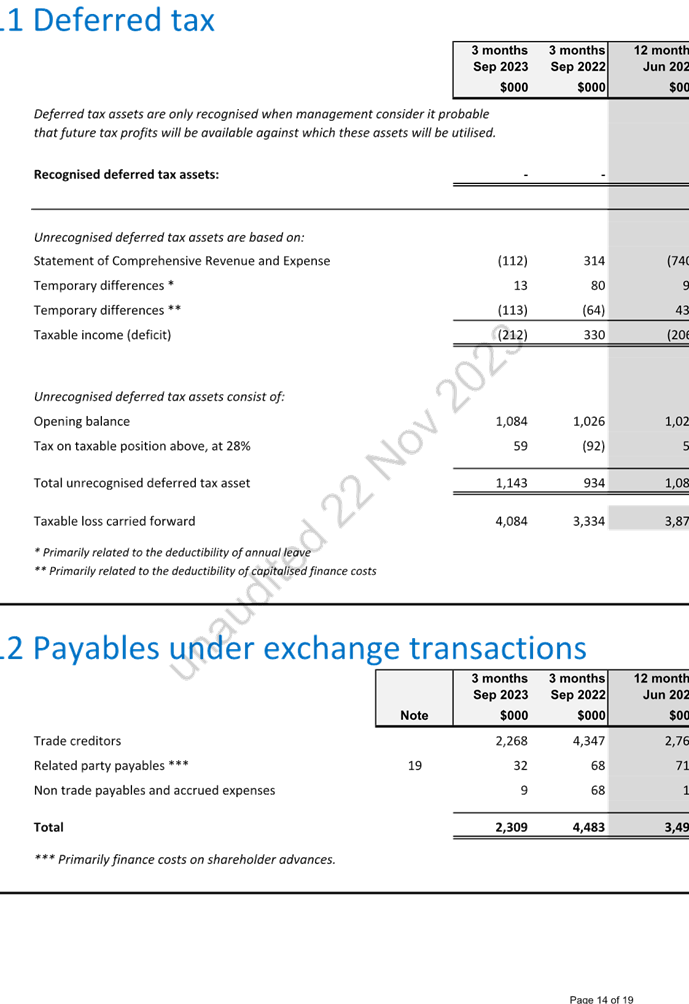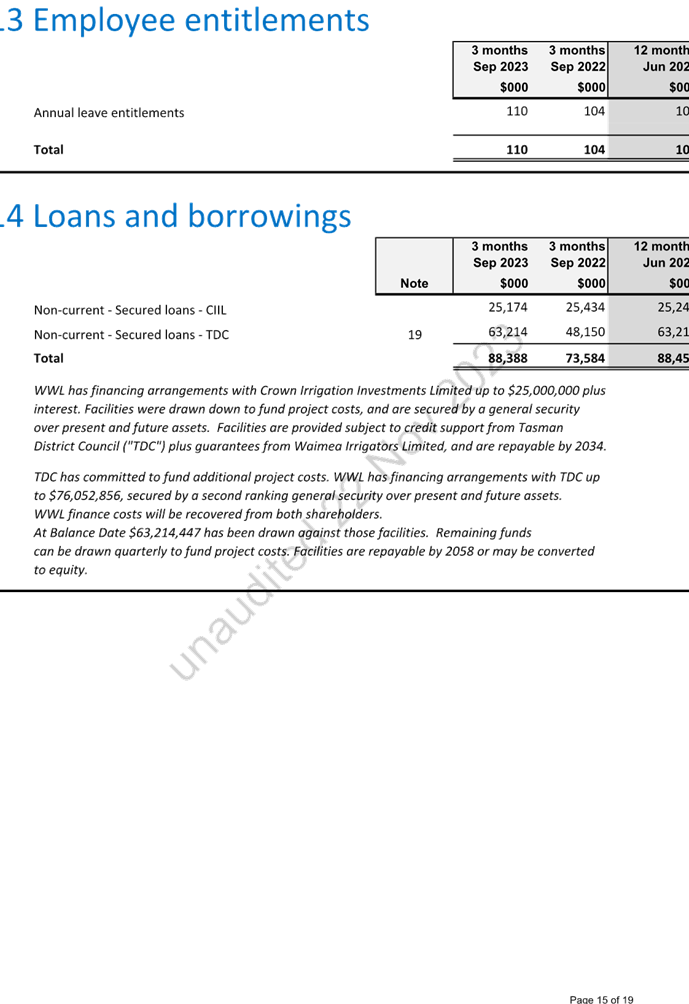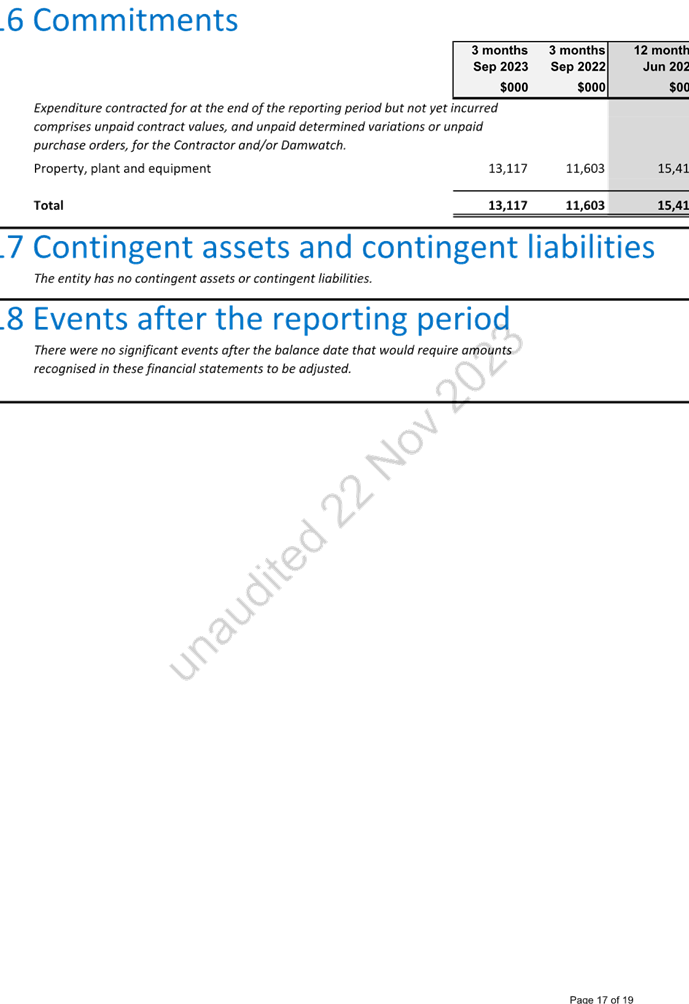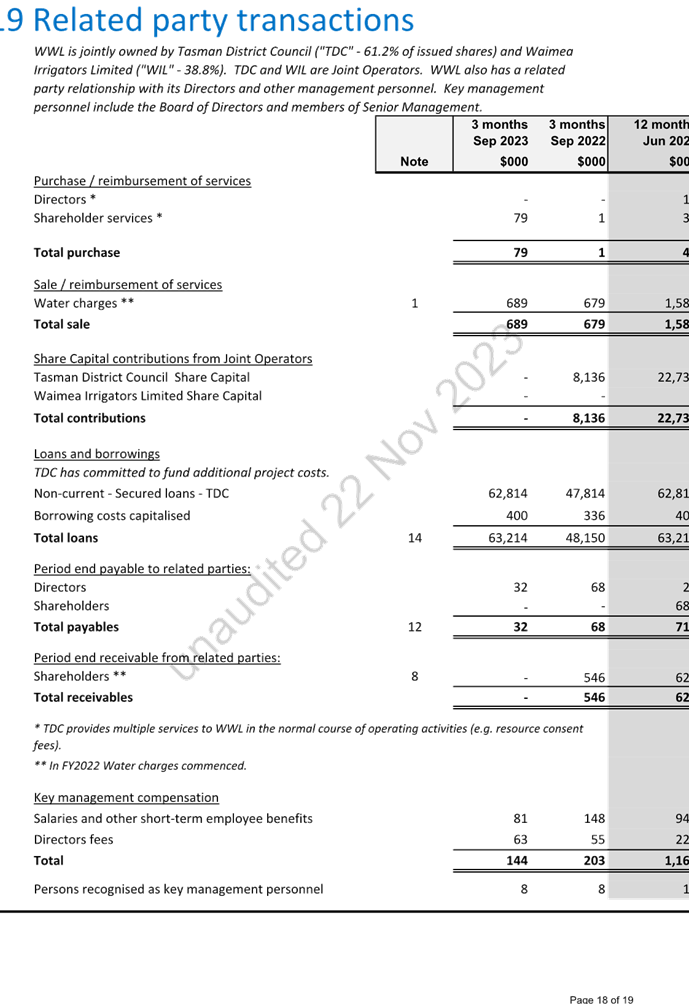Notice
is given that an ordinary meeting of the Tasman District Council will be held
on:
|
Date:
Time:
Meeting
Room:
Venue:
Zoom
conference link:
Meeting ID:
Meeting Passcode:
|
Wednesday 13 December 2023 and Thursday
14 December 2023
1.00pm
Tasman Council Chamber
189 Queen Street, Richmond
https://us02web.zoom.us/j/89845304183?
898 4530 4183
770789
|
|
Tasman District
Council
Kaunihera
Katoa
AGENDA
|
MEMBERSHIP
|
Mayor
|
Mayor T King
|
|
|
Deputy Mayor
|
Deputy Mayor S Bryant
|
|
|
Councillors
|
Councillor C Butler
|
Councillor M Kininmonth
|
|
|
Councillor G Daikee
|
Councillor C Mackenzie
|
|
|
Councillor B Dowler
|
Councillor K Maling
|
|
|
Councillor J Ellis
|
Councillor B Maru
|
|
|
Councillor M Greening
|
Councillor D Shallcrass
|
|
|
Councillor C Hill
|
Councillor T Walker
|
(Quorum 7 members)
|
|
|
Contact Telephone: 03 543 8512
Email: Robyn.Scherer@tasman.govt.nz
Website: www.tasman.govt.nz
|
Tasman District
Council
Agenda – 13 December 2023
AGENDA
1 Opening, Welcome, KARAKIA
2 Apologies
and Leave of Absence
|
Recommendation
That apologies be accepted.
|
3 Public
Forum
Public Forum will be heard when this meeting is reconvened on
Thursday 14 December 2023.
4 Declarations
of Interest
5 LATE
ITEMS
6 Confirmation
of minutes
|
That the minutes of the
Tasman District Council meeting held on Wednesday, 22 November 2023 and the
minutes of the Extraordinary Tasman District Council meeting held on
Thursday, 7 December 2023, be confirmed as a true and correct record of the
meeting.
|
|
That the confidential
minutes of the Tasman District Council meeting held on Wednesday, 22 November
2023, be confirmed as a true and correct record of the meeting.
|
7 Reports
7.1 Directions
to inform the Long Term Plan 2024-2034 consultation document and supporting
information and approval of proposed Rates Remission Policy for consultation... 6
The meeting will
be adjourned following consideration of Item 7.1 - Directions to inform the
Long Term Plan 2024-2034 consultation document and supporting information and
approval of proposed Rates Remission Policy for consultation and reconvened at
9.30am on Thursday 14 December 2023 in the Council Chamber, 189 Queen Street.
3
PUBLIC FORUM
3.1 Maxwell
Clark - Waimea Dam................................................................................. 5
7
REPORTS (continued)
7.2 Referral
Report - Nelson Tasman Regional Landfill Business Unit -
Annual Report 2022/2023 and Annual Financial Statements 2023.................... 124
7.4 Referral
Report - Nelson Tasman Regional Landfill Business Unit
Business Plan 2024 - 2025.................................................................................. 125
7.5 Referral
Report - Nelson Tasman Regional Landfill Business Unit
Activity Management Plan 2024 - 2034............................................................... 126
7.6 Referral
Report - Nelson Regional Sewerage Business Unit -
Annual Report 2022/2023 and Annual Financial Statements 2023.................... 128
7.7 Referral
Report - Nelson Regional Sewerage Business Unit Master Plan......... 129
7.8 Referral
Report - Nelson Regional Sewerage Business Unit
Business Plan 2024 - 2025.................................................................................. 131
7.9 Referral
Report - Nelson Regional Sewerage Business Unit
Activity Management Plan 2024 - 2034............................................................... 132
7.10 Referral
Report: Golden Bay Reserve Financial Contributions.......................... 134
7.11 Referral
Report: Motueka Reserve Financial Contributions............................... 138
7.12 Referral
Report - Regional Pest Management Plan 2019 - 2029
Partial Review Consultation................................................................................. 140
7.13 Community
Lease and Licence Renewals for Lakes-Murchison Ward,
Moutere-Waimea Ward and Richmond Ward..................................................... 141
7.14 Renewals
of Community Leases on Local Purpose Reserves in Lakes-Murchison Ward and
Moutere-Waimea Ward........................................................................................ 149
7.15 Amendment
to Council’s Traffic Control Devices Register and
Traffic Control Bylaw 2016.................................................................................. 157
7.16 Amendments
to the Delegation Register - Finance Roles.................................. 181
7.17 Waimea
Water Limited - Quarterly Report to Shareholders............................... 186
7.18 Machinery
Resolutions Report............................................................................ 224
7.19 Chief
Executive's Update..................................................................................... 225
7.20 Mayor's
Update Report........................................................................................ 232
8 Confidential
Session
8.1 Procedural
motion to exclude the public............................................................. 237
8.2 Waimea
Water Limited - Statement of Expectations.......................................... 237
9 CLOSING
KARAKIA
Tasman District
Council
Agenda – 13 December 2023
3 Public
Forum
3.1
Maxwell Clark -
Waimea Dam
|
Report
To:
|
Tasman
District Council
|
|
Meeting
Date:
|
13
December 2023
|
|
Report
Author:
|
Robyn
Scherer, Executive Assistant and Advisor to the Mayor
|
|
Report
Authorisers:
|
|
|
Report
Number:
|
RCN23-12-6
|
1. Public
Forum / Te Matapaki Tūmatanui
Maxwell Clark will speak at the public
forum regarding the Waimea Dam.
Nil
Tasman District
Council
Agenda – 13 December 2023
7 Reports
7.1
Directions to
inform the Long Term Plan 2024-2034 consultation document and supporting information
and approval of proposed Rates Remission Policy for consultation
Decision Required
|
Report
To:
|
Tasman
District Council
|
|
Meeting
Date:
|
13
December 2023
|
|
Report
Author:
|
Alan
Bywater, Team Leader - Community Policy; Matthew McGlinchey, Finance Manager;
David Arseneau, Senior Infrastructure Planning Advisor - Stormwater, Rivers
& Coasts; Dwayne Fletcher, Strategic Policy Manager; David Stephenson,
Team Leader - Stormwater & Waste Management; Mike Schruer, Waters and
Wastes Manager; Brylee Wayman, Senior Community Policy Advisor - Data
Analyst; Margie French, Senior Revenue Accountant; Mike Drummond, Group
Manager - Finance; Bill Rice, Senior Infrastructure Planning Advisor -
Transportation; Grant Reburn, Reserves and Facilities Manager
|
|
Report
Authorisers:
|
Dwayne
Fletcher, Strategic Policy Manager
|
|
Report
Number:
|
RCN23-12-7
|
1. Purpose
of the Report / Te Take mō te Pūrongo
1.1 The
purpose of this report is for the Council to confirm direction on what is to be
included in draft documents in its proposed Long Term Plan 2024-2034 (LTP) and
for its LTP process. This direction from the Council will enable staff to
include the Council’s proposals and changes in the draft LTP Consultation
Document, supporting information, LTP-related policies and Activity Management
Plans.
1.2 The
report also seeks the Council’s approval of the proposed Rates Remission
Policy, being amendments to its current policy, for consultation in parallel
with the LTP consultation.
2. Summary / Te Tuhinga
Whakarāpoto
2.1 The
Council is required to adopt a new Long Term Plan (LTP) by 30 June 2024 and is
required to consult on a Consultation Document based on its proposed LTP.
2.2 The
Council and staff have discussed multiple aspects of the LTP 2024-2034 in
workshops. This report seeks to formalise key parts of those discussions
in decisions to inform the consultation document, supporting information, LTP
related policies, and the LTP process. These decisions will inform the drafting
of the Consultation Document and the other documents that are either relied
upon by the content of the Consultation Document or are necessary for the
auditor to carry out the audit (collectively referred to as ‘supporting
information’ in this report).
2.3 This
report covers the following key proposals for the purposes of the development
of the LTP 2024-34:
· Financial Strategy
and proposed rating changes
· Overall Programme, Financials and Financial Strategy; and
· Confirming the
vision and community outcomes; and
· River Rating
– change from land value to capital value; and
· Harmonisation of
funding for water schemes – intention to develop this and consult in
2024/2025; and
· Richmond
Office Building – placeholder budget for LTP; and
· Waste Management and Minimisation - general rate contribution, food
scrap kerbside collection and Collingwood Resource Recovery Centre; and
· Speed Management – resources for implementation; and
· Libraries – resourcing and loan charges; and
· Community Facilities – funding of Motueka Swimming Pool, South
Waimea Community Facilities, Tapawera Community Hub and Murchison Recreation
and Cultural Centre – Stage 2; and
· Community Partnerships – resourcing; and
· Economic Development – funding of external organisations; and
· Uniform Annual General Charge – level; and
· Rates Remission Policy
2.4 Over
the next few months staff will draft the Consultation Document, supporting
information, and related LTP policies. A further workshop for councillors to
review these is programmed for 1 February 2024. A decision is sought through
this report on the key issues to include in the LTP consultation document.
2.5 The
audit of the Consultation Document and supporting information is scheduled for
4 February to 15 March 2024.
2.6 The
adoption of the Consultation Document and supporting information is scheduled
for
25 March 2024.
3. Recommendation/s
/ Ngā Tūtohunga
That the Tasman District Council
1. receives
the Directions to inform the Long Term Plan 2024-2034 consultation document and
supporting information and approval of proposed Rates Remission Policy for
consultation report RCN23-12-7; and
Vision, Purpose and Community Outcomes
2. agrees to retain the mission, vision, purpose,
community outcomes and strategic priorities (Attachment 1 to the agenda report)
from the Council’s Long Term Plan 2021-2031 for the proposed Long Term
Plan 2024-2034; and
Overall Long Term Plan
2024-2034 programme
3. agrees to use the overall expenditure programme, as
summarised in paragraphs 5.5 to 5.7 of the agenda report as the basis for the Long
Term Plan 2024-2034 Consultation Document and supporting information, modified
as required, by any resolutions below; and
4. notes the continuing uncertainty about how the three waters should
be treated in the consultation document and supporting information; and
5. notes that the proposed Long Term Plan programme referred to in clause
3 is based on a scenario where three waters remain the responsibility of the
Council for the whole Long Term Plan 2024-2034 period; and
6. agrees that the consultation document and supporting information
provide high level information on two scenarios:
a) where
three waters continue to be managed by the Council; and
b) where
responsibility for three waters is transferred to a Water Service Entity, as
contemplated in legislation currently, from 1 July 2026; and
7. notes that staff may vary this approach to the three waters in the
consultation document and supporting document, at a later stage, depending on
legislative changes and legal and other professional advice received; and
River Rating
8. agrees to consult on the proposal to change the basis
of rating for Rivers X and Rivers Y from land value to capital value through
the Long Term Plan 2024-2034; and
Harmonisation of funding for water schemes
9. notes an intention to carry out policy and financial analysis to consider options to address the
affordability issues with the rural water schemes, develop a proposal and carry
out consultation during the 2024/2025 year, subject to the direction of the
affordable waters reforms from the Government; and
10. agrees that the Council’s intention in clause 9.
above be communicated, but not consulted on through the Long Term Plan
2024-2034 Consultation Document, subject to the
direction of the affordable waters reforms from the Government prior to the
consultation commencing;
and
11. agrees that in the
meantime the existing funding mechanisms for the Council’s water supplies remain in
place; and
Richmond Office Building
12. agrees to
include ‘placeholder’ financial provision in the proposed Long Term
Plan 2024-2034 in accordance with Option C in paragraph 5.34 of the agenda report
to address the inadequate earthquake resilience in the Richmond office
building; and
13. notes the
intention to develop a firm proposal to address the inadequate earthquake
resilience in the Richmond office building for consultation in or before the
Long Term Plan 2027-2037; and
Overall Financials and Financial
Strategy
14. agrees
not to collect rates to build up the Emergency Funds in advance of emergency
events in the proposed
Long Term Plan 2024-2034;
15. agrees to
manage the provision and funding for emergency events by maintaining suitable
headroom between projected debt and our maximum prudential debt levels in the proposed Long Term Plan 2024-2034, and through reprioritising expenditure, if and when events occur;
and
16. agrees
that the goal of fully funding depreciation is moved out by five years to
2029/2030 in the proposed
Long Term Plan 2024-2034; and
17. agrees to
two dynamic financial caps for the proposed Long Term Plan 2024-2034 and
Financial Strategy being;
a) a rates cap (excluding growth)
based on Business and Economic Research Limited operating inflation plus 3% for
levels of service adjustments, noting that the Council will breach this cap in
Year 1 and 2 of the proposed Long Term Plan 2024-2034;
b) a net debt cap based on net debt
not exceeding 150% of operating revenue, noting that the Council will breach
this cap in Year 9 and 10 of the proposed Long Term Plan 2024-2034, as a result
of funding the construction of two new wastewater treatment plants; and
18. notes the
Net Debt level is forecast to increase from the current $204 million (30 June
2023) to $445 million in year 10 of the proposed Long Term Plan 2024-2034; and
19. agrees to
propose an increase in fees and charges of 10% from 2024/2025, noting there
will be exceptions to this approach to be considered when the Draft Schedule of
Fees and Charges is adopted for public consultation; and
20. agrees to retain its shares in Infrastructure Holdings Limited and
not propose selling some or all of these shares in the proposed Long Term Plan
2024-2034; and
21. agrees to propose the sale of unencumbered emissions trading scheme
(ETS) credits up to the value of approximately $400,000 per annum in the
proposed Long Term Plan 2024-2034, to offset the interest and loan repayment
costs for legacy debt for Port Tarakohe; and
22. notes the
planned overall rates increase for year one (2024/2025) is 9.56% after an
allowance for growth, and on average 4.5% after an allowance for growth for the
10 years of the proposed Long Term Plan 2024-2034; and
23. notes the
use of reserves to offset rates and to repay opening deficits from the
2022/2023 financial year, and
Waste Management and Minimisation
24. agrees to
remove the general rate contribution to the funding of Resource Recovery
Centres in the proposed Long Term Plan 2024-2034, noting this results in a
substantial increase in gate charges; and
25. agrees
not to budget for food scrap kerbside collection in the proposed Long Term Plan
2024-2034; and
26. agrees to continue to fund the Collingwood Resource Recovery Centre
in the proposed Long Term Plan 2024-2034;
Speed Management
27. agrees to a budget of $500,000 per annum in the proposed Long Term
Plan 2024-2034 for the implementation of the Speed Management Plan: and
Libraries
28. notes that the provision of libraries is an activity with strong
support from our communities; and
29. agrees to continue to fund library services in the proposed Long
Term Plan 2024-2034 with service levels comparable to now; and
30. agrees to continue charging for the loan of new adult books and
magazines and DVDs in the proposed Long Term Plan 2024-2034; and
Community
Facilities
31. agrees that the development of Waimea South Community Facilities be
included to commence in Year 2 (2025/2026) in the proposed Long Term Plan
2024-2034, with uninflated capital costs totalling $12.7 million across the
2025/2026-2027/2028 years; and
32. agrees that the capital cost of the Waimea South Community
Facilities in the proposed Long Term Plan 2024-2034 be funded from the sources
presented in the table in paragraph 5.87 of the agenda report: and
33. agrees that the development of the Motueka Swimming Pool be included
to commence in Year 3 (2026/2027) in the proposed Long Term Plan 2024-2034 with
uninflated capital costs of $20 million across the 2026/2027-2028/2029 years;
and
34. agrees that the capital costs of the Motueka Swimming Pool in the
proposed Long Term Plan 2024-2034 be funded from the sources presented in the
table in paragraph 5.94 of the agenda report: and
35. agrees that the development of the Tapawera Hub be included to
commence in Year 2 (2025/2026) in the proposed Long Term Plan 2024-2034, with
uninflated capital costs of $2.5 million included across the 2025/2026 to
2026/2027 years; and
36. agrees that the capital costs of the Tapawera Hub be funded in the
proposed Long Term Plan 2024-2034 from the sources presented in the table in
paragraph 5.101 of the agenda report: and
37. agrees that the Stage Two improvements to the Murchison Recreation
and Cultural Centre be included to commence in Year 8 (2031/2032) of the
proposed Long Term Plan 2024-2034, with uninflated capital costs of $4.5
million across the 2031/2032-2033/2034 years; and
38. agrees that the capital costs of the improvements to the Murchison
Recreation and Cultural Centre be funded in the proposed Long Term Plan
2024-2034 from the sources presented in the table in paragraph 5.107 of the
agenda report: and
Community
Partnerships
39. notes that provision of community partnership services is an
important way in which the Council builds relationships with its community and
leverages significant volunteer work; and
40. agrees to continue to fund community partnership services through
the proposed Long Term Plan 2024-2034 with service levels comparable to now;
and
Economic
Development
41. that the funding of economic development organisations recognises
the benefits this funding has for the economic wellbeing of the region; and
42. agrees to fund the following economic development organisations at
the corresponding amounts with annual inflationary adjustments in the proposed
Long Term Plan 2024-2034:
· Nelson Regional
Development Agency: $325,000 per annum;
· Golden Bay
Promotions (Tākaka Visitor Centre): $30,000 per annum;
· Tasman Bay
Promotions Association (Motueka Visitor Centre): $40,000 per annum;
· Nelson Tasman
Business Trust: $25,000 per annum; and
Uniform
Annual General Charge
43. agrees to consult on the proposal to change the basis of the Uniform
Annual General Charge to be 15% (rounded up to nearest dollar) of the general
rate take through the Long Term Plan 2024-2034; and
Remission
Policies
44. approves the Draft Rates Remission Policy for public consultation
through the Long Term Plan 2024-2034 in accordance with sections 102, 109, 82
and 82A of the Local Government Act 2002: and
45. agrees that the Chief Executive Officer be delegated authority to
approve any minor amendments required to the Draft
Rates Remission Policy prior to it being made available
for public consultation; and
46. notes that the low value property remission threshold will be
adjusted from $7,500 once the three yearly property revaluation is complete;
and
Issues for inclusion in
the Consultation Document
47. agrees that the key issues for inclusion in the Long
Term Plan consultation document are:
1) _______________________
2) _______________________
3) _______________________
Climate Change
48. agrees to include budgets to implement the Tasman
Climate Action Plan in accordance with Attachment 3 of the agenda report in the proposed Long Term Plan 2024-2034.
4.1 The
Council is required by the Local Government Act (2002) to adopt an LTP and
review it every three years. The LTP sets out the Council’s activities,
plans, budgets, and policies and must be adopted before the beginning of the
first financial year it relates to (in this case 30 June 2024).
4.2 The
Council is required to develop a Consultation Document for the LTP and to adopt
the information (referred to as supporting information in this report)
that is relied upon to develop the content of the Consultation Document. The
LTP supporting information will be made available to the community with the
Consultation Document when it opens for submissions in March 2024.
4.3 As
part of the LTP 2024-2034 process all budgets have been analysed using a
risk/opportunity assessment based on our cooperate risks management framework.
This considered risk and opportunity related to:
· service delivery;
and
· potential for loss
of external funding or significant increase in cost; and
· asset condition;
and
· reputation, legal
and regulatory; and
· health and safety
of staff, contractors and the public; and
· security and
information management; and
· business
continuity and resilience.
4.4 Using
the scores from this detailed analysis, planned expenditure was categorised as
something that the Council must do, something that it should do or something
that it could do. The initial assessments carried out by individual managers
were moderated, tested and checked for consistency by an LTP team.
4.5 Staff
have discussed the results of this analysis with councillors at workshops. In
some cases, budget areas that are something the Council should do have been
included in the proposed LTP programme and budget where staff and councillors
considered that these services were of high priority. This report includes
resolutions on three areas where this is the case: library services, community
partnerships and economic development.
4.6 The
following is a list of the supporting information that staff anticipate being
relied on to develop the content of the LTP 2024-2034 Consultation Document:
a) Draft accounting information (including inflation
adjusted forecast accounts, reserve funds and financial regulation benchmarks);
and
b) Draft forecasting assumptions; and
c) Vision, Community Outcomes and Strategic Priorities;
and
d) Draft Financial Strategy; and
e) Draft Infrastructure Strategy; and
f) Draft Statement on Fostering Māori
Participation in Council Decision Making; and
g) 2023 Treasury Risk Management Policy (including
Investment Policy and Liability Management Policy) – (already adopted);
and
h) Significance and Engagement Policy (already adopted);
and
i) Draft Activity Management Plans; and
j) Draft Group of Activities Summary Information;
and
k) Housing and Business Assessment; and
l) Draft Revenue and Financing Policy; and
m) Draft Financial Impact Statement including rates impact
example properties.
4.7 Subject to
decisions the Council makes, consultation is likely to be undertaken on changes
to several LTP- related policies, as well as the draft schedule of fees and
charges, at the same time and in parallel with the LTP Consultation
Document. These parallel consultations are on the following:
A. Draft Rates Remission Policy; and
B. Draft Policy on the Remission and Postponement
of Rates on Māori Land; and
C. Draft Development and Financial Contributions Policy;
and
D. Draft Community Facilities Funding Policy; and
E. Changes to the Revenue and Financing Policy
– River Rating and Uniform Annual General Charge.
4.8 The
Consultation Document and supporting information that has not already been
adopted, is scheduled to be adopted on 25 March 2024. On that date, staff will
also seek consultation approval of the draft policies B, C, and E above.
4.9 A
range of aspects of the LTP have been discussed at workshops during 2023.
This report seeks decisions on key aspects of the proposed LTP programme to
enable staff to draft the Consultation Document and supporting information
ready for audit in early February 2024.
5. Analysis
and Advice / Tātaritanga me ngā tohutohu
Vision, Community Outcomes and
Priorities
5.1 One of the purposes of the LTP is
to describe the Council’s community outcomes for the District. As part of
the early engagement for the LTP 2021-2031 the Council proposed some new
priorities and sought feedback on these, alongside the vision and community
outcomes.
5.2 Given the vision, community outcomes and
priorities are high level descriptions of aspirations for the Council and
District they tend to remain fairly consistent for an extended period. It is
recommended that the Vision, Community Outcomes and Priorities from the LTP
2021-2031 (see Attachment 1) be retained.
Options:
|
Option
|
Advantage
|
Disadvantage
|
|
1.
|
Retain the existing vision, community
outcomes and priorities. Preferred Option
|
Retains a consistent picture of what the
Council is working with the community to achieve.
Minimises the staff time and resources
required.
|
If the vision, community outcomes and
priorities do not adequately describe the Council’s intentions, it
would be misleading not to amend them.
|
|
2.
|
Amend the vision, community outcomes and
priorities.
|
If the Council’s view on its
vision, community outcomes and priorities has changed since the LTP 2021-2031
it would be most transparent to amend them.
|
Frequent changes to the vision, community
outcomes and priorities may cause confusion and uncertainty.
Changing the vision, community outcomes
and priorities will require significant staff time and resources (including
for consultation on the changes).
|
Overall budgets, rates increases, debt
and capital programme size
5.3 The Council has discussed an overall financial programme for the
purpose of producing a consultation document to take to the community. The
three key areas are:
5.3.1 Net Debt
5.3.2 Rate Increase
5.3.3 Capital programme
5.4 Across the ten years of the LTP the Net
Debt figure increases by 120% from $202 million as at 30 June 2023 to $444
million in 2033/2034.

5.5 The rate increase (excluding growth)
will peak in 2024/2025 at 9.56%. Across the ten years the average per annum
increase (excluding growth) is 4.5%.

5.6 The capital programme has an average
spend across the ten years of the LTP of $90.5 million excluding Joint venture
expenditure, such as the Nelson Regional Sewerage Business Unit. This average
is significantly influenced by the market increased in capital expenditure near
the end of the 10 years associated with the construction of new wastewater
treatment plants in Motueka and Golden Bay.

Options:
|
Option
|
Advantage
|
Disadvantage
|
|
1.
|
Agree
with the overall financial programme proposed.
Preferred Option
|
Staff
are able to prepare the consultation document and meet all statutory
obligations.
|
|
|
2.
|
Further
changes are made to the presented financial programme
|
Decisions
may better reflect a programme that all Councillors are comfortable with.
|
Staff
will not have time to produce a Consultation Document in time for it to be
audited which will mean delays in the preparation of the Long-Term Plan
|
Three waters in the
proposed LTP, Consultation Document and Supporting Information
5.9 The
question of how to manage three waters in the LTP programme and what to
communicate about the three waters in the consultation document has been and
remains a difficult issue given the current legislation and the intentions of
the political parties that make up the new Government.
5.10 The
existing legislation requires the Council to exclude the three waters from its
LTP from 1 July 2026. However, it is likely that the new Government will repeal
this legislation, although the timing of this move is unclear.
5.11 This
issue applies to most of the territorial authorities across New Zealand.
Taituāra is working with the Department of Internal Affairs to try to
expedite a legal change to provide clarity to councils across the country.
5.12 The
guidance at this stage is that the new Government’s intention to change
the legislation does not override the existing legislation. Therefore, if we
include the three waters in our proposed LTP programme, consultation document
and supporting information, there is a legal risk of challenge through judicial
review. However, the likely remedy if the Council lost a judicial review on
this matter is likely to be quite mild, depending a bit on what legislation the
Government puts in place in the meantime.
5.13 Advice
provided by the Auditor General is that we should prepare our consultation
document and supporting documents on the ‘best information’ we have
at the time of drafting. This would imply including the three waters in these
documents and therefore our overall LTP programme.
5.14 At
this stage staff recommend that the proposed LTP include 3 waters and that the
consultation document and supporting information is prepared to provide
high-level financial information on both scenarios i.e. three waters included
for the full ten years, and three waters included only for the first two
years. By doing so we hope to provide good information to and enable the
right conversation with the community through the consultation. At the
same time attempting to mitigate the legal risk of challenge as much as
possible.
5.15 This
situation remains fluid and we will continue to actively seek the best advice
and remain flexible about how to deal with the three waters as long as possible
through this process.
River Rates
5.16 The Council funds river management works using the
targeted Regional River Works Rates. The rate is charged on the basis of land
value, with 50% of funding from rating units in the River X and Y rating areas
and the remaining 50% from properties outside the X and Y areas (River Z
areas). It is recommended that the Council consults with the community on
changing the basis for charging river rates in X and Y rating areas from land
value to capital value. The basis of rating for River Z areas would remain land
value.
5.17 The rationale for changing to charging by capital
value is that the ratepayers whose properties have higher capital value as a
result of investment in building or plant for example receive greater benefits
from the river protection works than ratepayers with lower valued rating units.
Options:
|
Option
|
Advantage
|
Disadvantage
|
|
1.
|
Charge river rates to rating units in the
River X and Y rating areas based on capital value. Preferred Option
|
More equitable charging for rates.
Property owners with greater investment
and capital value will contribute funding proportionate to the level of their
investment, reflecting the value of protection provided and the priority that
gets placed on protecting these properties.
This may deter capital investment in
higher risk areas, which is beneficial for long-term risk management.
|
Some ratepayers whose rates increase as a
result may oppose the proposed change.
There are increased costs for carrying
out consultation to make this change although these are minimised by being
part of the LTP consultation.
|
|
2.
|
Continue to charge river rates to rating units
in the River X and Y rating areas based on land value
|
Lower cost of consultation.
|
No deterrent to capital investment in
higher flood risk areas.
Not as equitable as proposed capital
valuation system.
|
Water Rates Harmonisation
5.18 The
existing fees/charges for the provision of water supply services to
Council’s three rural water supply schemes (Dovedale, Eighty-Eight Valley
and Redwood Valley) are unaffordable and unsustainable into the future.
5.19 The
existing fee structures and charging mechanisms for the three rural supplies
and Motueka are misaligned with the way other Council services are charged and
harmonised, for example, wastewater.
5.20 The
Motueka water supply, and each rural water supply, has a separate account and
has a bespoke charging mechanism related to how much it costs to operate that
individual supply. This results in inconsistencies and inefficiencies in
operating the charging model and administering rates. The urban extension
restricted supplies in the Urban Water Club include a discount to account for
the reduced level of service (water quality, pressure, flow, fire-fighting
capacity) compared to the on demand urban water supplies.
5.21 The
separate accounts for rural water supply in some cases carry significant
accumulated and growing deficits. These deficits will need to be addressed in
the financial modelling and future funding options.
5.22 The
Dovedale, Eight-Eight Valley and Redwood Valley schemes require significant
infrastructure upgrades to provide safe and reliable water, and to comply with
Taumata Arowai rules and regulations.
5.23 The
affordability issue will be further exacerbated by these planned upgrades for
these schemes.
5.24 Further
work is required to assess the financial implications of harmonising the way
some or all the water schemes are funded with the remaining water schemes
(including Motueka) to create a more equitable and affordable charging regime
across the district. There are several options available to how and when this
is carried out.
5.25 Significant
policy analysis and financial modelling is required to fully explore and
understand the implications of the various options. There is insufficient
capacity and time to properly carry out the necessary work ahead of
consultation on the LTP 2024-2034. However, these problems are too urgent to
leave until the next LTP. In addition, there remains substantial uncertainty
about the direction of the affordable waters reforms given the General Election
result. In addition, the financial impact of changes in these funding
arrangements are likely to be difficult for individual ratepayers to understand
amongst the other budget and funding changes taking place through the LTP
2024-2034, as well as property revaluations.
5.26 It
is recommended that the policy and financial analysis required to consider
options to address these affordability issues is carried out, a proposal
developed and consultation carried out during the 2024/2025 year. The intention
would be that any new funding arrangements could commence from 1 July 2025.
This planned approach and timing is subject to the direction of the affordable
waters reforms from the Government.
5.27 In
the meantime. it is recommended that the existing funding mechanisms for the
water schemes remain in place.
5.28 It
is further recommended that these water scheme affordability issues, the
Council’s intention to develop options and to consult on them during the
2024/2025 year, subject to the direction of the affordable waters reforms from
the Government, be communicated through the LTP 2024-2034 Consultation
Document. This matter would be for information in the LTP Consultation
Document, rather than an issue being consulted on in the LTP process.
Options:
|
Option
|
Advantage
|
Disadvantage
|
|
1.
|
Address the harmonisation of water
schemes during the 2024/2025 year. Preferred Option.
|
Enables the affordability issues to be
addressed in a reasonably timely manner.
Provides suitable time for the Council to
analyse the options and model their financial impacts before carrying out
consultation.
Enables some opportunity for the new
Government to provide direction on the affordable waters reforms.
Enables ratepayers to clearly see the
financial impacts of the proposals for them, without this being complicated
by other financial changes in the LTP.
|
Means the current funding arrangements,
including General Rates subsidy for two rural schemes, to continue for
another year.
Deficits in the two rural water schemes
increase before the affordability issues are addressed.
|
|
2.
|
Address the harmonisation of water
schemes in the LTP 2024-2034
|
The affordability issues with the water
schemes will be addressed at the earliest opportunity.
Means the current funding arrangements
including General Rates subsidy for two rural schemes will not need to
continue for another year.
|
Does not provide suitable time for the
Council to analyse the options and model their financial impacts before
carrying out consultation.
Provides little opportunity for the new
Government to provide direction on the affordable waters reforms.
Would not enable ratepayers to clearly
see the financial impacts of the proposals for them, without this being
complicated by other financial changes in the LTP.
|
|
3.
|
Address the harmonisation of water
schemes later than 2024/2025 year.
|
Provides sufficient time for the Council
to analyse the options and model their financial impacts before carrying out
consultation.
Enables sufficient opportunity for the
new Government to provide direction on the affordable waters reforms.
Enables ratepayers to clearly see the
financial impacts of the proposals for them, without this being complicated
by other financial changes in the LTP.
|
Does not enable the affordability issues
to be addressed in a reasonably timely manner. This issue has already been
around for over a decade and keeps on being deferred due to resourcing
issues.
Increasing numbers of users will likely
either leave the rural water schemes or reduce their water units, which will
increase the costs for the remaining users.
Current funding arrangements including
General Rates subsidy for two rural schemes to continue for a longer
period.
Deficits in the two rural water schemes
increase before the affordability issues are addressed.
|
|
4.
|
Do not address the affordability of rural
water schemes
|
Does not require the Council to carry out
the policy analysis, financial modelling and consultation involved in making
a change.
No impact on water users outside the
schemes directly affected.
|
Does not enable the affordability issues
to be addressed in a reasonably timely manner. Water supply will become very
expensive for users of these water schemes.
Increasing numbers of users will likely
to either leave the rural water schemes or reduce their water units, which
will increase the costs for the remaining users.
Current funding arrangements including
General Rates subsidy for two rural schemes to continue for a longer
period.
Deficits in the two rural water schemes
will increase or have to be paid off through higher rates and user fees.
|
Budgetary
provision for the Richmond Office Building
5.29 The
current Council offices in Richmond have low seismic rating. Some parts of the
building are below 35% of the National Building Standards. Under current policy
settings this means that the building in its current state is not legally
useable as an office after June 2033. The building has several operational
limitations including non-contiguous spaces, inadequate amenities, toilets and
meeting spaces and poor heating, cooling and ventilation. Fire egress
constraints limit the buildings capacity with a maximum capacity of 260 if the
Council’s design manual and fit out is applied.
5.30 Given
this situation that the Council will need to address the issues with the
Richmond building prior to June 2033 and make suitable financial provision in
the LTP 2024-2034 to do so. At this stage the Council is undecided about
the course of action to take with broad options including investing
significantly to retrofit and expand the existing building, developing a new
building on the current or a different site or leasing a building.
5.31 The
environment in which to decide on major investment in office accommodation is
currently fluid with rapidly changing office work norms, the impact of the
Future for Local Government report not yet known and the potential for local
government amalgamation to be considered in the region.
5.32 During
the next three years the Council will need to develop a firm proposal and to
consult on that before or as part of the LTP 2027-2037.
5.33 In
the meantime, the Council needs to make a ‘placeholder’ financial
provision in its LTP 2024-2034. The primary options are to assume that the
Council:
A. Strengthens and expands the existing building ($25m).
Strengthening the existing building and doing the minimum to continue to occupy
it would require capital expenditure of approximately $13.3 million in Years
8-9 of the LTP 2024-2034. In addition, building expansion would be required to
accommodate the forecast staff numbers. Based on providing an additional
1,190 m2 of floor space on the current site the cost of this
expansion is estimated at $11.5 million in Year 11 or later.
B. Construct a new building with floor area of 4,500m2
either on the current site or on another site with subsequent disposal of the
current site. The expected capital cost of this option is approximately $55
million.
C. Leases a building from another party with a
floor area of 4,500m2 either on the current site or on another site
with subsequent disposal of the current site. A one-off capital cost of $1.7
million (uninflated) in Year 7 would be required mainly to fit out a new
building plus increased operational costs of $3.4 million per annum
(uninflated), commencing in Year 8.
5.34 It
is recommended that the Council include a ‘placeholder’ financial
provision in the LTP 2024-2034 in accordance with Option (C) above.
Options:
|
Option
|
Advantage
|
Disadvantage
|
|
1.
|
Make placeholder financial provision
based on option (C) above with a firm decision to be made later.
Preferred option.
|
Acknowledges the earthquake vulnerability
of the existing building and then need to address it during the LTP period.
Makes reasonable financial provision in
the LTP based on one of the practicable options.
Enables the Council to better understand
the changing context, the options available to develop a firm proposal for
consultation.
|
The financial placeholder is at the lower
end of the potential costs for a new building and may prove to be lower than
the amount required for other options.
|
|
2.
|
Make placeholder provision based on an
alternative option with a firm decision to be made later.
|
Acknowledges the earthquake vulnerability
of the existing building and the need to address it during the LTP period.
An alternative option may have a higher
cost estimate and more realistically reflect what the Council may need to
spend.
Enables the Council to better understand
the changing context, the options available to develop a firm proposal for
consultation.
|
There are a number of different
alternatives available, and all have differing cost estimates with any
proposed solution having the potential not to be the one the Council
ultimately decides on.
The placeholder financial provision may
prove to be higher or lower than the option the Council ultimately chooses.
|
|
3.
|
Consult on a firm proposal for the
Richmond Office Building in the LTP 2024-2034.
|
Acknowledges the earthquake vulnerability
of the existing building and the need to address it during the LTP period.
Provides increased time to implement the
decision once made through the LTP 2024-2034.
|
The context may change significantly
after the decision is made, requiring a revision or reversal of the decision
or the Council proceeding with a less-than-optimal or overly costly solution.
There is insufficient time to fully
explore, develop and cost the options available to a level where consultation
can be carried out and a firm decision can be made.
|
|
4.
|
Make no placeholder provision with a firm
decision to be made at a later date.
|
Lower impact on rates and debt levels in
the LTP 2024-2034.
|
Does not acknowledge the earthquake
vulnerability of the existing building and the need to address it during the
LTP period.
Presents an unrealistic picture of the
Council’s finances compared with its liabilities and risks in the LTP
2024-2034.
Unlikely to be acceptable to the auditor.
|
Emergency Funds
5.35 In
the LTP 2021-2031 the Council decided not to collect rates to contribute to the
emergency fund reserves for the first four years of the LTP. The Council
decided to rely on using the remaining funds existing in the reserves and debt
headroom to be able to fund the recovery from emergency events.
5.36 As part of the LTP 2024-2034 it is recommended not collecting rates
to contribute to the emergency fund reserves to help moderate the proposed
rates increases.
5.37 The
Council can expect a level of Central Government support to assist in recovery
from emergency events similarly to other councils following recent events. To
fund recovery following an emergency event the Council could re-prioritise
planned work programmes and services and borrow to fund recovery. The Draft
Financial Strategy plans for modest debt headroom to be maintained (above the
self-imposed debt cap) to enable the Council to borrow in these circumstances.
In the years following an emergency event, it will be necessary to increase
rates (and other forms of revenue) to service the loans used to fund the
recovery.
Options:
|
Option
|
Advantage
|
Disadvantage
|
|
1.
|
Do not collect rates to contribute to
emergency funds and rely on reprioritisation and debt headroom to fund
recovery from emergency events. Preferred Option
|
Helps limit rates revenue increases prior
to an emergency event.
|
Relies on debt and reprioritisation to
respond after an event has taken place, which is likely to increase rates in
the years after an emergency event.
|
|
2.
|
Collect rates to contribute to emergency
funds and rely on debt headroom to fund recovery from emergency events.
|
Less reliance on debt and
reprioritisation to respond after an event.
Reserves built up before an emergency
event can be used to reduce debt levels until the funds are required.
|
Rates increases will be higher prior to
an emergency event.
It is unlikely that reserves could be
built up to a level to fund all recovery expenses so programme
reprioritisation and borrowing headroom would be required as well.
|
Funding depreciation
5.38 In previous LTP’s the Council had agreed to
move to fully fund depreciation over 10 years i.e. by 2024/2025. The Council
had steadily been moving to this goal over the last eight years.
5.39 However, because of the recent economic climate
including very high inflation, the Council has had significant valuation
increases. This has resulted in material increases to the depreciation expense.
To help ease the rates increases in the LTP 2024-2034 the option of moving this
goal out by a further five years to 2029/2030 has been discussed and is
recommended.
Options:
|
Option
|
Advantage
|
Disadvantage
|
|
1.
|
Agree to move out fully funding
depreciation by 5 years.
|
The rates increase will not be as high in
the first 5 years of the LTP and thus more affordable.
|
By pushing out the requirement to fully
fund depreciation it will result in more debt being held by Council across
those 5 years.
This in turn may delay some capital
programme work and increased rates in future years.
|
|
2.
|
Agrees to leave it as the status quo.
|
Lower net debt levels which limit
exposure to interest rate movements.
|
Higher rates increase which contributes
to affordability issues with some ratepayers of Tasman District Council.
|
Financial Caps
5.40 In
previous LTPs the Council has established static caps for the percentage rates
increase and net debt levels. Over the last two years we have exceeded
the percentage rates increase caps in the LTP 2021-2031 and largely as a
result, have consulted on the Annual Plan in each case.
5.41 Through
workshops we have considered the option of changing from these static financial
caps to more dynamic ones i.e. caps that change as underlying financial metrics
move.
5.42 It
is recommended that the Council adopts a dynamic rates increase cap (excluding
growth) made up of the following components:
· An allowance for inflation based on the forecast operating Local
Government Cost Index; and
· A service change allowance (that acknowledges that the services the
Council provides may change over time as a result of the needs in the District
and/or mandates from Central Government). This is set at 3.0% for the draft
LTP.
5.43 The
dynamic rates increase cap will operate in addition to any increase in rates
revenue generated by the growth in rating units. The growth in rating units
increases rates collected but also increases the cost of providing services.
5.44 It
is recommended that the Council adopts a dynamic net debt cap of 150% of
operating revenue.
Options:
|
Option
|
Advantage
|
Disadvantage
|
|
1.
|
Adopt the dynamic rates increase and net
debt caps recommended. Preferred Option
|
The financial caps auto- adjust as the
other financial metrics change over time.
Acknowledge cost increases for providing
services.
Acknowledge growth increases the
Council’s cost base.
Allows movement in the debt cap as
Council revenue increases.
Ratings agencies will assess the
Council’s debt in relation to its revenue
|
Revenue tends to track upwards and the
debt cap will increase with this.
Potential perverse incentive to increase
costs and revenue as a means of increasing debt cap but this is moderated by
pressure to moderate revenue increases.
Lack of certainty the caps change
annually as the underlying metrics change.
Net debt cap does not account for the
cost of servicing debt.
|
|
2.
|
Adopt the dynamic rates increase and net
debt caps of the type recommended but alter their levels.
|
Advantages depend on the specific dynamic
caps selected.
|
Risk of creating caps that are either so
high as not to be meaningful or so low that the Council is likely to exceed
them on a regular basis.
|
|
3.
|
Adopt static financial caps or
alternative dynamic caps (i.e. using different underlying financial metrics)
|
The Council would consciously adjust the
caps periodically and could deliberately use them to apply downward pressure
on rates and debt
|
The financial caps do not auto-adjust as
the other financial metrics change over time and would need to be manually
adjusted periodically.
Caps don’t automatically
acknowledge growth increases the Council’s cost base and inflation
meaning that adjustments for these would have to be done manually and could
potentially lag.
There is a risk that the caps manually
selected get exceeded relatively frequently undermining their value.
The level of the static caps are
established with not real rationale.
|
General 10% inflation increase for fees and charges
5.45 Fees
and charges are an important source of revenue for the Council and are
generally charged where there is private benefit from the provision of a
service and it is practical to impose a charge.
5.46 The
proportion of revenue we raise through rates, fees and other sources for each
activity is established in the Revenue and Funding Policy.
5.47 To
keep pace with rising costs and maintain the proportion of the costs of
services being funded by fees and charges, it is proposed that in general these
be increased by 10% from the 2024/2025 year.
5.48 This
is a general rule and will not apply to every fee in the Council’s
schedule of fees and charges. In some cases, fees are set by Government
regulation and in some cases an increase of this size will be inappropriate for
one reason or another. The fees and charges for commercial and
semicommercial activities are influenced by prevailing market rates. The
Council will consider the full schedule of fees and charges prior to
consultation on it being carried out.
Options:
|
Option
|
Advantage
|
Disadvantage
|
|
1.
|
10% increase in the Council’s fees
and charges in general.
Preferred Option
|
Enables revenue from fees and charges to
keep pace with costs and rates increases.
Enables compliance with Revenue and
Financing Policy percentages.
|
Increases costs for people to use the
Council’s services and in some cases, people will choose not to do so
because of the price.
Increases the incentive for some people
to choose not to follow regulations due to the cost of complying.
|
|
2.
|
Increase fees and charges by more than 10%
in general
|
May generate additional revenue for the
Council.
|
Increases costs for people to use the
Council’s services and in some cases, people will choose not to do so
because of the price.
Increases the incentive for some people
to choose not to follow regulations due to the cost of complying.
May not be justified by the increase in
costs for providing the service i.e. not real and reasonable.
May lead to a higher proportion of
revenue coming from fees than indicated in the Revenue and Financing Policy.
|
|
3.
|
Increase fees and charges by less than
10% in general
|
Lower increases in costs for people to
use the Council’s services and people will be less likely to choose not
to use them because of the price.
Less of an incentive for some people to
choose not to follow regulations due to the cost of complying.
Less likely to lead to a higher
proportion of revenue coming from fees than indicated in the Revenue and
Financing Policy.
|
May reduce revenue for the Council.
May lead to a lower proportion of revenue
coming from fees than indicated in the Revenue and Financing Policy.
Less cost recovery with further costs
being met by rates.
|
Not sell Infrastructure Holdings
Limited shares
5.49 On 1 July
2023 Council exchanged its 50% shareholding in Port Nelson Ltd and Nelson
Airport Ltd for a 50% stake in Infrastructure Holdings Limited (IHL). The
other 50% is held by Nelson City Council. The arrangements include
a shareholder’s agreement that provides for Nelson City Council to have
the first right of refusal on any share sale by this Council. Any
purchase by Nelson City Council would result in it having a controlling
interest in the port and airport and enhanced influence of the port and
airport’s direction and dividend policy.
5.50 The
Council's investment in IHL is considered a strategic Investment and any sale
would require a consultative process with the community. There is likely
to be a range of views within the community on.
5.51 IHL
provides a steady income stream to the Council which is used to offset Council
expenditure therefore reducing overall rates. A sale or part sale of IHL
shares would provide an immediate cash benefit to the Council at the expense of
the longer-term and ongoing dividend stream.
Options
|
Option
|
Advantage
|
Disadvantage
|
|
1.
|
Retain Current investment in IHL.
Preferred Option
|
Retains current dividend streams.
Retains current governance arrangements.
|
No immediate cash injection into Council.
|
|
2.
|
Sell all or a part of Council’s
stake in IHL
|
An Immediate cash benefit from the net
proceeds of the sale.
|
Will require the cost and resources for
consultation and engagement with the community.
Could effectively hand control of IHL to
NCC with a resultant loss of influence over future direction and dividend
policies.
Reduced flow of income from dividends.
|
Use of Emissions Trading Scheme (ETS) credits for Port
Tarakohe
5.52 Currently
Council has as part of its forestry activity unencumbered ETS credits. The
value of these credits moves markedly as they are traded on a volatile market.
These unencumbered credits are available for sale as they are not required to
be surrendered for future forestry harvesting.
5.53 Port
Tarakohe continues to operate at a loss. All efforts to reduce the
ongoing operational losses at Port Tarakohe have not been effective. The
Port lacks the scale and other income streams that other ports have. The
Port is a key strategic asset for Golden Bay to support resilience,
recreational users and commercial users (primarily marine farming).
5.54 To
reduce the financial pressure on the Port it is proposed to use the proceeds of
ETS credit sales over the next 10 years to cover all or part of the interest
and loan repayments on current debt that has accumulated for the Port.
The proposed sales of ETS credits would be made annually. This approach
will reduce the price risks inherent in a volatile market.
5.55 The
value of interest and loan repayments to be funded by receipts from the sale of
ETS credits in the proposed LTP programme for consultation is in the order of
$400,000 per annum.
|
Option
|
Advantage
|
Disadvantage
|
|
1.
|
Annual ETS credit sale.
Preferred Option
|
Releases cash over time to meet servicing
of legacy debt in relation to Port Tarakohe.
Does not directly increase rates as the
alternative funding from rates would.
Is consistent with cross-subsidisation
between Enterprise activities.
|
Funds are not available for other
purposes or the credits available for future carbon offsets.
Is inconsistent with the Council's
previous position that Port Tarakohe must operate as a stand-alone
self-funding business.
|
|
2.
|
No ETS credits sale
|
Current ETS credits are retained for
future carbon offsets or future sale.
|
An alternative funding source like rates
will need to be found. If that does not occur the debt against the port
will continue to grow. Allowing the debt to grow is not a
sustainable strategy in the medium term.
|
Waste Management and Minimisation
5.58 In March 2023, the previous government announced a
new range of waste minimisation proposals, as part of an update to the New
Zealand Waste Strategy. Included in this strategy was an intention for
regulations and performance standards requiring all councils to provide food
waste collections to urban areas by January 2030. For Tasman District, this
would require collections in Richmond, Hope, Brightwater, Wakefield, Motueka
and Tākaka. At the time of writing, while regulations had been published
regulating the food waste materials there was not yet a performance requirement
for us to provide food waste collections.
5.59 Our initial estimates indicated that the earliest
that food waste collections could feasibly commence would be 2027/2028. In 2024
we will be starting work with staff at Nelson City Council on a detailed
business case for food waste collection, to confirm the strategic case, and
determine the feasibility of a service. Results are expected in 2025. In
parallel with this we will be working on a review of the Nelson-Tasman Waste
Management and Minimisation Plan.
5.60 At this stage we are not proposing to budget for
food waste collections, as they are not yet mandatory, and the community is
facing cost of living pressures. There will be an opportunity to review this
position in the LTP 2027-2037, following the results of the business case and
when the Nelson Tasman Waste Management and Minimisation Plan has been updated.
Options:
|
Option
|
Advantage
|
Disadvantage
|
|
1.
|
Do not include a budget for food waste
collections.
Preferred Option
|
Reduces financial pressure in later years
of LTP and does not introduce a budget with a high level of
uncertainty. Allows for further consideration through waste plan.
|
No financial provision for food waste
collections should they be required in the future. Does not align with
intention to reduce organic waste from landfill.
|
|
2.
|
Include a budget for food waste
collections from 2029-2030.
|
Makes financial provision for a service
that is likely to be required to meet waste reduction and climate objectives.
|
High level of uncertainty around scope
and timing of service. Some questions around cost-effectiveness of service
have not yet been answered.
|
Remove general rate contribution to waste management
5.61 In developing operating budgets for Resource
Recovery Centres, we have considered the balance of funding between fees and
charges and general rates. Waste disposal and transport make up around 80% of
our direct external costs, and historically our fees at the Resource Recovery
Centres have covered these expenses, with general rates covering the remaining
external and internal costs.
5.62 In 2024/2025 we are expecting landfill fees at the
York Valley landfill to increase by just under $44 per tonne, an 18% increase.
In our budgeting, we initially planned to increase Resource Recovery Centre
gate charges by $44 per tonne (from $282.90 to $326.60 incl. GST, a 15%
increase).
5.63 Following feedback at Council workshops, and
considering the pressure on general rates, we have increased the proposed fees
and charges to largely eliminate the need for general rate funding for the
remaining external and financing costs for Resource Recovery Centres. This
results in a substantial increase in Resource Recovery Centre gate charges in
2024/2025, from $282.90 to $360.16 per tonne, an increase of 27%. In the
following three years the proposed gate charges would increase between 0.3% and
3.3%, and then decrease until 2031/2032, when charges would again increase
(Attachment 5).
Options:
|
Option
|
Advantage
|
Disadvantage
|
|
1.
|
Budget for an increase of $77 per tonne
in 2024/2025, to largely eliminate general rate requirement for RRCs.
Preferred Option
|
Reduces general rate requirement and
moves to a user pays approach for waste disposal.
May also incentivise large commercial
customers in Richmond to haul direct to landfill, reducing maintenance costs.
|
Likely to be unpopular.
May reduce affordability of waste
disposal and risk of increased illegal dumping.
|
|
2.
|
Budget for an increase RRC gate charges
in 2024/2025 of $44 per tonne of waste, to match York Valley increase.
(Status quo)
|
Minimises price increase for customers at
Resource Recovery Centres.
|
Increased general rate requirement for
Resource Recovery Centre activities.
|
|
3.
|
Budget for an increase of $60 per tonne
in 2024/2025, and a further increase of $18 per tonne in 2025/2026 to
eliminate general rate in 2025/2026.
|
Moves to a user pays approach but smooths
increase over two years.
Impact of cost increase can be monitored
in 2024/2025.
|
Maintains a general rate requirement for
the activity.
|
Collingwood Resource
Recovery Centre
5.64 In
considering potential cost savings for the Waste Management activity staff
considered whether the Collingwood Resource Recovery Centre (RRC) should remain
open.
5.65 The
Collingwood RRC provides waste disposal, recycling, greenwaste disposal and a
reuse shop. It is normally open three days a week (9 am to 12 noon) but opens
seven days a week for an eight-week period over summer.
5.66 The
Collingwood site handles around 1800 transactions per annum - around 1.7% of
the Council’s RRC transactions and just under 0.5% of the
district’s waste materials. Most of the transactions are for domestic
customers.
5.67 If
we chose to close the site we would see savings in the order of $35,000 per
annum. This saving excludes maintenance and other holding costs which would
still be required as long as we own the site.
Options:
|
Option
|
Advantage
|
Disadvantage
|
|
1.
|
Continue to provide Collingwood RRC.
Preferred Option
|
Continues to provide services for
Collingwood, including recycling services for Aorere Valley, where there is
no kerbside recycling service.
|
Cost of approximately $35,000 per annum.
|
|
2.
|
Close the Collingwood Resource Recovery
Centre
|
Savings of approximately $35,000 per
annum.
|
Likely to be very unpopular with
Collingwood residents. Customers would need to drive around 30km to the
Tākaka Resource Recovery Centre or purchase commercial waste services.
|
Speed Management
5.68 A
placeholder budget for providing signs, changes to road structures etc. to
implement the Speed Management Plan was developed by staff at $700,000 per
annum for each year of the LTP 2024-2034. However, the Speed Management Plan is
still under development, so it is difficult to be accurate about the costs to
implement it.
5.69 Following
discussion at a workshop it is recommended that this budget be set at the lower
level of $500,000 per annum.
Options:
|
Option
|
Advantage
|
Disadvantage
|
|
1.
|
Provide implementation budget at $500,000
per annum. Preferred option.
|
The resources for implementation may well
be adequate at this level.
Decisions are less likely to be made to
reduce the resources for other services/activities in the LTP unnecessarily
to manage the rates increases.
|
It is possible that the resources for
implementation will not be sufficient in some or all years and additional
budgets sought through subsequent Annual Plans.
|
|
2.
|
Provide implementation budget at $700,000
per annum
|
Based on estimates the resources for
implementation should be at least adequate.
|
The resources being budgeted for
implementation may be in excess of what will actually be required and risks
unnecessarily impacting rates increases through the LTP period.
Decisions may be made to reduce the
resources for other services/activities in the LTP unnecessarily to manage
the rates increases.
|
|
3.
|
Provide budget needed to meet only the
‘do minimum’ requirements in regulations.
|
Minimizes cost associated with spend
management. Circa $1m mostly in the first 2-3 years of the LTP period.
|
Provides no scope to implement the final
speed management plan if it entails more than the ‘do minimum’.
Council is consulting on four options for urban and four options for rural
communities, and most of these options require investment to progressively
change the roading environment to match any future speed limits.
|
Libraries
5.70 Following the application of the risk/opportunity
matrix funding for the continued provision of library services across the
District was rated as something the Council should do, rather than something it
must do i.e. funding of library services is not mandatory.
5.71 Libraries provide important and highly valued
services in our communities. This is evidenced in the 2023 Residents’
Survey with 86% of all respondents being satisfied of very satisfied with
libraries and 100% of users satisfied or very satisfied. We anticipate that
there would be significant opposition to a proposal to discontinue these
services through the consultation.
5.72 Libraries have a range of benefits including
providing access to books and other material regardless of ability to pay;
access to computers and contributing to bridging the digital divide, providing
a conduit to disseminate public information; contributing to literacy,
providing safe community spaces and meeting space and providing access to free
programmes and events. Libraries help to provide a focus for the community and
there are several benefits from people being able read for pleasure.
5.73 It is recommended that the funding of library
services be retained in the LTP 2024-2034.
Options:
|
Option
|
Advantage
|
Disadvantage
|
|
1.
|
Continue to fund libraries.
Preferred Option.
|
See list of benefits in paragraph 5.76.
The Council has invested substantially in
libraries over a number of years and not continuing to fund them would see
this investment wasted.
|
Higher rates revenue required.
|
|
2.
|
Discontinue funding for libraries
|
Lower rates revenue required.
|
The benefits listed in paragraph 5.76
would be lost.
The Council’s previous investment
in libraries would not provide benefits to the community.
|
|
3.
|
Substantially reduce funding for
libraries
|
Lower rates revenue required to some
degree.
|
The benefits listed in paragraph 5.76
would be reduced or lost to some degree
|
5.74 Some
material (new adult books, magazines in the adult section and DVDs) currently
have fees applied to them. Annually these generate approximately $100,000 but
also generate additional administrative costs of approximately $50,000 per
annum.
5.75 To
make this material more widely accessible (particularly for young people moving
into borrowing adult material) and to be consistent with no charges being made
for electronic versions of the same books, there is an option to remove these
charges.
5.76 It
is recommended that fees for the loan of these specific categories of material
be retained to help moderate the increase in rates.
Options:
|
Option
|
Advantage
|
Disadvantage
|
|
1.
|
Continue to charge for the loan of new
adult books, magazines in the adult section and DVDs. Preferred option.
|
Helps to limit the increase in rates.
|
Maintains the existing costs barriers for
this material for some users.
Maintains the existing inconsistency
between the charges for physical books and no charges for electronic versions
of books.
|
|
2.
|
Discontinue loan fees for new adult
books, magazines in the adult section and DVDs
|
Removes cost barriers for use of this
material.
Removes the inconsistency between the
charges for physical books and no charges for electronic versions of books.
|
Adds to rate increases.
|
Waimea South Community
Facilities
5.77 Investigations
and feasibility work has been carried out on the development of community facilities
in South Waimea.
5.78 A
new facility is being considered at Wakefield Recreation Reserve to cater for
community, recreation and arts-based groups. In Brightwater at the Brightwater
Recreation Reserve, it is proposed to extend/upgrade an existing facility to
better meet community needs.
5.79 The
best current estimate of costs for these facilities is $12.7 million
(uninflated). Note at this stage concept designs have not been developed, nor
have the costs been estimated by a quantity surveyor.
5.80 It
is recommended that the development of the Waimea Community Facilities be
included to commence in Year 2 (2025/2026) in the proposed LTP 2024-2034, with
capital costs across the 2025/2026-2027/2028 years.
5.81 It
is recommended that the capital costs of these facilities be funded as follows:
|
Source
|
%
|
$
|
Rationale
|
|
Community contribution
|
23%
|
$2.9m
|
Consistent with the Draft Community
Facilities Funding Policy
|
|
Reserve and community faciality financial
contributions (RFCs).
|
58%
|
$7.4m
|
75% of Council's contribution
|
|
Rates funded loans
|
19%
|
$2.4m
|
25% of Council's contribution
|
|
Total
|
|
$12.7m
|
|
5.82 Under
this proposal operating costs would start from the 2028/2029 year reaching a
full year’s operating costs in 2029/2030. The operational costs will be
funded through the District Facilities Rate.
Options:
|
Option
|
Advantage
|
Disadvantage
|
|
1.
|
Plan for the facilities to commence in
Year 2 with the mix of funding sources in paragraph 5.87.
Preferred Option.
|
Clear commitment from the Council to
support and provide significant funding for these community facilities.
Appropriate mix of funding sources.
Consistent with the Draft Community
Facilities Funding Policy.
Provides a level of certainty to the
community about the timing and expected community fundraising requirement.
|
The proportion of the capital costs
funded through loans contribute to rates increases.
Opportunity costs for the use of Reserve
and Community Facilities Financial Contributions.
Operational costs impact rates from
2028/2029 onwards.
Substantial community fundraising is
required over a relatively short period.
|
|
2.
|
Do not include these facilities in the
proposed LTP
|
Lower impact on rates levels.
Reserve and Community Facilities
Financial Contributions could be used on alternative projects.
|
No commitment from the Council to these
facilities would disappoint local residents.
Lower standard of community facilities in
the area would persist.
The current earthquake-prone community
centre would have to be addressed in another way.
Social and cultural wellbeing in the area
may be impaired by the lack of good-quality community facilities.
|
|
3.
|
Plan for the facilities to commence later
than Year 2
|
Including a plan for the facilities in
the LTP would signal commitment from the Council.
More time available for community
fundraising to take place.
Some Reserve and Community Facilities
Financial Contributions may be able to be used on alternative projects in the
meantime.
|
Lower standard of community facilities in
the area would persist for longer.
The current earthquake-prone community
centre continues to be used for longer.
Social and cultural wellbeing in the area
may be impaired for longer by the lack of good-quality community facilities.
|
|
4.
|
Use an alternative mix of funding sources
for the capital
|
Reducing the use of Reserve and Community
Facilities Financial Contributions means they could be used on alternative
projects.
Reducing the funding from rates-funded
loans would reduce the increase in rates.
Reducing the level of community
fundraising would mean less fundraising stress on the community and may
enable the project to take place earlier.
|
Increasing the use of Reserve and
Community Facilities Financial Contributions may be inconsistent with the
purpose for which they are collected.
Increasing the use of rates funded loans
will further increase rates.
Requiring a greater level of community
fundraising would be inconsistent with the Draft Community Facilities Funding
Policy and the funding of other community facilities, and potentially
increase the pressure on the community to raise funds.
|
Motueka Swimming Pool
5.83 The
provision of a public swimming pool has been a long-held community aspiration
in Motueka. Investigations and feasibility work has been carried out on the
development of a pool. The Council has purchased land in Motueka with the
intention of providing a swimming pool.
5.84 At
this stage the concept for the Motueka Pool includes:
· A
25-metre pool with 6 lanes (8 lanes if this can be accommodated within
available funding)
· Learners
and leisure pool
· Hydrotherapy
pool
· Splash
pad and toddlers pool
· Spa
pool
5.85 The
best current estimate of costs for the swimming pool in Motueka is $20 million
(uninflated). Note at this stage concept designs have not been developed, nor
have the costs been estimated by a quantity surveyor.
5.86 It
is recommended that the development of the Motueka Swimming Pool be included to
commence in Year 3 (2026/2027) in the proposed LTP 2024-2034, with capital
costs across the 2026/2027-2028/2029 years.
5.87 It
is recommended that the capital costs of these facilities be funded as follows:
|
Source
|
%
|
$
|
Rationale
|
|
Community contribution
|
22%
|
$4.4m
|
Following proposed policy on community
contributions
|
|
RFCs
|
59%
|
$11.8m
|
75% of Council's contribution
|
|
Rates funded loans
|
19%
|
$3.8m
|
25% of Council's contribution
|
|
Total
|
|
$20.0m
|
|
5.88 Under
this proposal operating costs would start from the 2028/2029 year reaching a
full year’s operating costs in 2029/2030. The operational costs will be
funded through the District Facilities Rate.
Options:
|
Option
|
Advantage
|
Disadvantage
|
|
1.
|
Plan for the facilities to commence in
Year 3 with the mix of funding sources in paragraph 5.94.
Preferred Option.
|
Clear commitment from the Council to
support and provide significant funding for the Motueka Swimming Pool.
Appropriate mix of funding sources.
Consistent with the Draft Community
Facilities Funding Policy.
Provides a level of certainty to the
community about the timing and expected community fundraising requirement.
|
The proportion of the capital costs
funded through loans contribute to rates increases.
Opportunity costs for the use of Reserve
Financial and Community Facilities Contributions.
Operational costs impact rates from
2029/2030 onwards.
Substantial community fundraising is
required over a relatively short period.
|
|
2.
|
Do not include the Motueka Swimming Pool
in the proposed LTP
|
Lower impact on rates levels.
Reserve Financial and Community
Facilities Contributions could be used on alternative projects.
Land purchased could be used for
alternative purposes or sold.
|
No commitment from the Council to the
Motueka Swimming Pool would disappoint local residents.
No public swimming pool in Motueka with
residents having to travel to Richmond to the nearest public pool.
Social well being in the area may be
impaired by the lack of a public swimming pool.
Potentially higher rates of water-related
accidents and deaths due to the lower access to opportunities to learn to
swim and develop water confidence.
|
|
3.
|
Plan for the facilities to commence later
than Year 3
|
Including a plan for the facilities in
the proposed LTP and having purchased land would signal commitment from the
Council.
More time available for community
fundraising to take place.
|
No public swimming pool available in the
area for longer.
Social well-being benefits of a public
swimming pool will be delayed.
The benefits of additional water safety
through opportunities to learn to swim and develop water confidence will be
delayed.
|
|
4.
|
Use an alternative mix of funding sources
for the capital
|
Reducing the funding from rates-funded
loans would reduce the increase in rates.
Reducing the level of community
fundraising would mean less fundraising stress on the community and may
enable the project to take place earlier.
|
Increasing the use of Reserve and
Community Facilities Financial Contributions may be inconsistent with the
purpose for which they are collected.
Increasing the use of rates-funded loans
will further increase rates.
Requiring a greater level of community
fundraising would be inconsistent with the Draft Community Facilities Funding
Policy and the funding of other community facilities, and potentially
increase the pressure on the community to raise funds.
|
Tapawera Community Hub
5.89 A
new community hub building is proposed which will provide for community
meetings, workshops, office space and community health services. Tapawera
Connect and Tapawera and Districts Community Council (TDCC) support the
proposal and TDCC would provide the land.
5.90 Preliminary
design and costings for the hub have been obtained.
5.91 The
best current estimate of costs for these facilities is $2.5million
(uninflated),
5.92 It
is recommended that the development of the Tapawera Hub be included to commence
in Year 2 (2025/2026) in the proposed LTP 2024-2034, with capital costs
included across the 2025/2026 to 2026/2027 years.
5.93 It
is recommended that the capital costs of these facilities be funded as follows:
|
Source
|
%
|
$
|
Rationale
|
|
Community contribution
|
33%
|
$1.3m
|
Following proposed policy on community
contributions
|
|
RFCs
|
50%
|
$0.8m
|
75% of Council's contribution
|
|
Rates funded loans
|
17%
|
$0.4m
|
25% of Council's contribution
|
|
Total
|
|
$2.5m
|
|
5.94 Under
this proposal operating costs would start from the 2027/2028. The operational
costs will be funded through the District Facilities Rate.
Options:
|
Option
|
Advantage
|
Disadvantage
|
|
1.
|
Plan for the Tapawera Community Hub to
commence in Year 2 with the mix of funding sources in paragraph 5.101.
Preferred Option.
|
Clear commitment from the Council to
support and provide significant funding for this facility.
Appropriate mix of funding sources.
Consistent with the Draft Community
Facilities Funding Policy.
Provides a level of certainty to the
community about the timing and expected community fundraising requirement.
|
The proportion of the capital costs
funded through loans contribute to rates increases.
Opportunity costs for the use of Reserve
and Community Facilities Financial Contributions.
Operational costs impact rates from
2027/2028 onwards.
Substantial community fundraising is
required.
|
|
2.
|
Do not include Tapawera Community Hub in
the proposed LTP
|
Lower impact on rates levels.
Reserve and Community Facilities
Financial Contributions could be used on alternative projects.
|
No commitment from the Council to this
facility would disappoint local residents.
Lower standard of community facilities in
the area would persist.
Social, economic and cultural wellbeing
in the area may be impaired by the lack of this facility.
|
|
3.
|
Plan for the Tapawera Community Hub to
commence later than Year 2.
|
Including a plan for the Tapawera
Community Hub in the LTP would signal commitment from the Council.
More time available for community
fundraising to take place.
Some Reserve and Community Facilities
Financial Contributions may be able to be used on alternative projects in the
meantime.
|
Lower standard of community facilities in
the area would persist for longer.
Social, economic and cultural wellbeing
in the area may be impaired for longer by the lack the Tapawera Community
Hub.
|
|
4.
|
Use an alternative mix of funding sources
for the capital
|
Reducing the use of Reserve and Community
Facilities Financial Contributions means they could be used on alternative
projects.
Reducing the funding from rates-funded
loans would reduce the increase in rates.
Reducing the level of community
fundraising would mean less fundraising stress on the community and may
enable the project to take place earlier.
|
Increasing the use of Reserve and
Community Facilities Financial Contributions may be inconsistent with the
purpose for which they are collected.
Increasing the use of rates funded loans
will further increase rates.
Requiring a greater level of community
fundraising would be inconsistent with the Draft Community Facilities Funding
Policy and the funding of other community facilities, and potentially
increase the pressure on the community to raise funds.
|
Murchison Sport,
Recreation and Cultural Centre - Stage 2
5.95 The
Murchison Sport, Recreation and Cultural Centre is proposed to be extended to
include the following features:
§ Large
meeting room
§ Community
room
§ Squash
Court and mezzanine floor
§ Gym
§ Changing
Rooms
5.96 The
best current estimate of costs for these facilities is $4.5million
(uninflated). Note at this stage concept designs have not been developed, nor
have the costs been estimated by a quantity surveyor.
5.97 It
is recommended that the improvements to the Murchison Sport, Recreation and
Cultural Centre be included to commence in Year 8 (2031/2032) in the proposed
LTP 2024-2034, with capital costs across the 2031/2032-2033/2034 years.
5.98 It
is recommended that the capital costs of these facilities be funded as follows:
|
Source
|
%
|
$
|
Rationale
|
|
Community contribution
|
29%
|
$1.3m
|
Following proposed policy on community
contributions
|
|
RFCs
|
53%
|
$2.4m
|
75% of Council's contribution
|
|
Rates funded loans
|
18%
|
$0.8m
|
25% of Council's contribution
|
|
|
|
$4.5m
|
|
5.99 Under
this proposal operating costs would start from the 2031/2032 year reaching a
full year’s operating costs in 2032/2033. The operational costs will be
funded through the District Facilities Rate.
Options:
|
Option
|
Advantage
|
Disadvantage
|
|
1.
|
Plan for the facilities to commence in
Year 8 with the mix of funding sources in paragraph 5.107.
Preferred Option.
|
Clear commitment from the Council to
support and provide significant funding for this facility improvement.
Appropriate mix of funding sources.
Consistent with the Draft Community
Facilities Funding Policy.
Provides a level of certainty to the
community about the timing and expected community fundraising requirement.
|
The proportion of the capital costs
funded through loans contribute to rates increases.
Opportunity costs for the use of Reserve
and Community Facilities Financial Contributions.
Operational costs impact rates from
2031/2032 onwards.
Substantial community fundraising is
required.
Community members may be disappointed by
having to wait several years for the facility improvements.
|
|
2.
|
Do not include these facilities in the
proposed LTP
|
Lower impact on rates levels.
Reserve and Community Facilities
Financial Contributions could be used on alternative projects.
|
No commitment from the Council to this
facility improvement would disappoint local residents.
Current limitations with the existing
facility would persist.
Social and cultural well being in the
area may be impaired by the range and quality of facilities provided.
|
|
3.
|
Plan for the facilities to commence later
than Year 8.
|
Including a plan for the facilities in
the LTP would signal commitment from the Council.
More time available for community
fundraising to take place.
Appropriate mix of funding sources.
Some Reserve and Community Facilities
Financial Contributions may be able to be used on alternative projects in the
meantime.
|
Lower standard of community facilities in
the area would persist for longer.
Social and cultural well being in the
area may be impaired for longer by the lack of good-quality community
facilities.
Community members may be disappointed by
having to wait additional years for the facility improvements
|
|
4.
|
Plan for the facilities to commence
earlier than Year 8.
|
Including a plan for the facilities in
the proposed LTP would signal commitment from the Council.
A shorter timeframe may give community
fundraising more impetus.
Appropriate mix of funding sources.
|
Less time for the community to raise its
share of the project costs.
Earlier impact on rates increases through
interest and repayment of loans, as well as operational costs.
|
|
5.
|
Use an alternative mix of funding sources
for the capital
|
Reducing the use of Reserve and Community
Facilities Financial Contributions means they could be used on alternative
projects.
Reducing the funding from rates-funded
loans would reduce the increase in rates.
Reducing the level of community
fundraising would mean less fundraising stress on the community.
|
Increasing the use of Reserve and
Community Facilities Financial Contributions may be inconsistent with the
purpose for which they are collected.
Increasing the use of rates funded loans
will further increase rates.
Requiring a greater level of community
fundraising would be inconsistent with the Draft Community Facilities Funding
Policy and the funding of other community facilities, and potentially
increase the pressure on the community to raise funds.
|
Community Partnerships
5.100 Following
the application of the risk/opportunity matrix funding for the continued
provision of community partnerships was rated as something the Council should
do, rather than something it must do i.e. community partnerships are
non-mandatory services.
5.101 The
Council’s community partnerships function is an important part of the
Council’s relationship with its communities. It contributes particularly
to the social, cultural and environmental aspects of well being for our
community. Through its partnership approach and community grants
community partnerships leverages substantial volunteer work and benefits for
the Council and wider community. The Community Partnerships service also
provides a range of free events which are accessible to everyone and help
engender a sense of community.
5.102 It is recommended that the funding of community partnerships
services be retained in the proposed LTP 2024-2034.
Options:
|
Option
|
Advantage
|
Disadvantage
|
|
1.
|
Continue to fund community
partnerships. Preferred Option.
|
See list of benefits in paragraph 5.111.
Valuable staff that have developed strong
links with organisations in the community would be retained.
|
Continued rates revenue required.
|
|
2.
|
Discontinue funding for community
partnerships.
|
Lower rates revenue required.
|
The benefits listed in paragraph 5.111
would be lost.
Valuable staff that have developed strong
links with organisations in the community would be lost.
|
|
3.
|
Substantially reduce funding for
community partnerships.
|
Lower rates revenue required to some
degree.
|
The benefits listed in paragraph 5.111
would be reduced or lost to a substantial degree
|
Economic Development
services
5.103 Following
the application of the risk/opportunity matrix, the continued funding of
organisations that contribute the District’s economic development was
rated as something the Council should do, rather than something it must do i.e.
it is non-mandatory. This applied to funding to the Nelson Regional Development
Agency, Golden Bay Promotions (for the operation of the Tākaka visitor
centre), Tasman Bay Promotions Association (for the operation of the Motueka
Visitor Centre) and Nelson Tasman Business Trust (for the provision of free
mentoring and advice services to start up and existing
businesses).
5.104 The
Council is responsible for promoting economic wellbeing, as well as social,
cultural and environmental wellbeing. The Council contributes to economic
wellbeing in several ways including funding economic development organisations.
5.105 There
are a range of benefits to the community from the Council funding economic
development organisations. These include improving the understanding of the
nature and performance of our regional economy and coordinating planning for
its continued enhancement and expansion. This funding enables the facilitation
of sector groupings of businesses working in the same industry to come together
for their mutual benefit. It also provides for mentoring and professional
development of business operators assisting them to start, expand and develop
their businesses. It provides a vehicle to attract and administer funding from
the Government and other sources for business and infrastructure development.
It helps to attract visitors to the region, provides visitors with the
information they need when in the region and facilitates visitors' use of
accommodation and attraction businesses, as well as facilitating the social
licence for tourism in the region.
5.106 It is recommended that the funding of economic development
organisations be retained in the proposed LTP 2024-2034.
|
Option
|
Advantage
|
Disadvantage
|
|
1.
|
Continue to fund economic development
organisations. Preferred Option.
|
See list of benefits in paragraph 5.116.
Continuity of service that has developed
strong links with businesses in the region would be retained.
|
Continued rates revenue required.
|
|
2.
|
Discontinue funding for economic
development organisations.
|
Lower rates revenue required.
|
The benefits listed in paragraph 5.116
would be lost.
Valuable staff that have developed strong
links with businesses in the region would be lost to the region.
The Council may have to provide some of
these services in-house.
|
|
3.
|
Substantially reduce funding for economic
development organisations.
|
Lower rates revenue required to some
degree.
|
The benefits listed in paragraph 5.116
would be reduced or lost to a substantial degree.
|
Rates Remission Policy
5.107 The
proposed updated rates remission policy is attached (Attachment 4).
5.108 The
Council offers a range of rates remission policies to assist ratepayers with
rates under certain agreed circumstances.
5.109 It
is recommended there is an amendment to the Introduction section to meet the
new legislative requirement to state how the policy supports the principles set
out in the Preamble to Te Ture Whenua Māori Act 1993.
5.110 It
is recommended minor editorial amendments to the following parts of the policy:
5.110.1 Uniform
Charges on Non-Contiguous Rating Units Owned by the Same Owner
5.110.2 Rates
on Low-Valued Properties
5.110.3 Rates
for School Wastewater Charges
5.110.4 Rates
on Abandoned Land
5.110.5 Land
Subject to Council Initiated Zone Changes
5.111 It
is proposed to add an additional policy for Social Housing and Papakāinga.
5.112 It
is recommended that the following parts of the policy be amended along with
other minor editorial amendments:
5.112.1 Land
Occupied by a Dwelling that is Affected by Natural Disaster be updated to
clarify what is meant by an uninhabited dwelling.
5.112.2 Sporting,
Recreation or Community Organisations be updated to include association of
persons (whether incorporated or not).
5.112.3 Low
Valued Properties to be updated after the 3 yearly revaluation to reflect the
new amount for low value properties.
5.112.4 Penalties
be updated to include an additional two criteria for invoice not received and
deceased sole ratepayer.
5.112.5 Excess
Metered Water Rates be updated to reflect that a plumber is no longer required
but recommend, clarify not for profit organisations s and charities can claim
under the policy as residential and remove the requirement for monitoring water
use for non-residentials.
|
Option
|
Advantage
|
Disadvantage
|
|
1.
|
Adopt the draft policies for consultation
at the same time as the Long-Term Plan 2024-2034 consultation process.
Preferred Option
|
Keeps policies current to legislation and
operational requirements.
Policies able to reflect community
feedback.
Meets the requirements of the LGA 2002.
|
Council would not have an opportunity to
make major amendments to the draft policies, if it considers they are needed
prior to public consultation.
|
|
2.
|
Amend the draft policies before
consultation
|
If Council considers that the draft
policies do not meet its needs or the needs of the community, Council can
request staff to make further amendments before releasing them for public
consultation.
|
Use of further staff time to undertake
the amendments and report back to Council.
|
|
3.
|
Make no changes
|
Requires no staff time
|
Will not meet legislative requirements.
May not meet the needs of the community.
May not meet operational needs.
|
Uniform Annual General
Charge
5.113 The
Council funds general rates through a combination of Capital Value based rates,
and the Uniform Annual General Charge (UAGC). The UAGC has been set at $290 per
rating unit for several years. Consequently, its percentage of general rates
has reduced (as the overall rates level has increased).
5.114 The
demand on Council services funded by the UAGC does not generally increase with
increasing value of the rating unit.
5.115 Increasing
the level of the UAGC has the effect of increasing the proportion of rates
revenue funded by lower-value rating units compared to higher-valued rating
units compared to it staying at $290. Due to the UAGC not being increased for
several years it has had the opposite effect of higher-valued rating units
bearing more of the rates burden over time.
|
Option
|
Advantage
|
Disadvantage
|
|
1.
|
Modest change to 15% of the general rate
take Preferred Option
|
Keeps the rates from the UAGC consistent
to the total general rates take over time
|
The UAGC will change year on year.
|
|
2.
|
Change to a different fixed dollar
amount, either higher or lower than the current $290 per rating unit.
|
Keeps per rating unit amount consistent
|
Would require regular review to ensure
that the UAGC was set at an appropriate level.
Could end up in similar situation where
the UAGC is not changed for a number of years shifting the general rate,
rates burden.
|
|
3.
|
Keep at $290 per rating Unit
|
Keeps per rating unit amount consistent
|
Changes the rates burden over time as
income requirements increase
|
6.58 The
options for each key items are outlined in the tables in section 5 above.
7.58 Section
93 of the Local Government Act requires the Council to have an LTP, to adopt it
prior to the first year to which it relates and identifies the purposes of an
LTP. One of the purposes of the LTP is to describe the community outcomes of
the District.
7.59 Under
section 93A of the LGA, the Council is required to prepare a Consultation
Document on its proposed LTP and consult on it using the Special Consultative
Procedure. The LGA specifically prohibits the Council from consulting on a
draft LTP, but requires, under Section 93G, that the Council must prepare and
adopt information that is relied upon by the content of the Consultation
Document, is necessary to enable the Auditor General to give an audit statement
and provides the basis for the preparation of the LTP.
7.60 Sections
93B to 93G detail various other requirements about the LTP content, form and
process.
7.61 Section
94 documents the requirement for the LTP to be audited by the Auditor-General.
7.62 Section
96 makes it clear that the effect of an LTP is to provide a formal and public
statement of the Council’s intentions but does not constitute a decision
to act on any specific matter included in the Plan. The Council can use the
provisions in section 80 to diverge from what it planned in the LTP. One of the
main purposes of the Annual Plan is to signal variation from the LTP for the
year in question.
7.63 The
only exceptions to this are if the Council is significantly altering the
intended level of service for a significant activity or transferring ownership
or control of a strategic asset. In these cases, the Council is required to
make the changes via an LTP or LTP Amendment.
7.64 Schedule
10 provides more detail on the information to be included in Long Term
Plans. This includes the significant forecasting assumptions and risks
underlying the financial estimates.
8. Iwi
Engagement / Whakawhitiwhiti ā-Hapori Māori
8.58 Manawhenua ki Mohua hosted and participated in
one of the early engagement hui in May 2023. Representatives of Te Āwhina
Marae attended and participated in the Motueka early engagement workshop.
8.59 We
have made several invitations to Te Tauihu iwi to engage on the LTP. This
took the form of several offers for the Trusts to provide advice on how they
wanted to be engaged.
8.60 Staff
analysed the iwi environmental plans and iwi trust’s strategic plans to
identify the areas of priority that had a relationship to the LTP. We
identified the connection to the LTP and asked some open questions to stimulate
iwi thinking about the LTP. We circulated this information to the iwi trusts.
8.61 We
held two online hui with iwi trust taiaio staff and general managers at which
the LTP was explained, key linkages to areas of iwi interest were explained and
discussion took place. Some iwi discussed specific matters as part of this hui.
The opportunity to engage further with the Council was offered with the (then)
Kaihautū offering herself and Te Kāhui Hononga as guides to connect iwi into the right people within
the Council and processes to engage on matters of interest.
8.62 Subsequently,
staff have carried out some engagement on Te Tare Whenua Act aspects of the
Development and Financial Contributions Policy and the Remission and
Postponement of Rates on Māori Land Policy. Some initial feedback
was received from the iwi trusts on these matters.
8.63 The
Kaihautū has sent a further memo to iwi general managers outlining
the timeline for consultation and submissions and raising the following items
with them from the LTP documentation:
· Te Ture Whenua Act; and
· Draft Statement on Fostering Māori Participation in Council
Decision Making.
9. Significance
and Engagement / Hiranga me te Whakawhitiwhiti ā-Hapori Whānui
9.58 Significance
assessments have been carried out for each of the decisions sought in this
report. The full significance assessments are provided in Attachment 2.
The following table provides a summary of the overall level of significance
identified for each decision by staff.
|
Decision/Issue
|
Assessed Level of Significance
|
|
Retaining the vision, purpose and community outcomes
|
Low/Medium
|
|
Change in river rating to capital value
|
Low significance for the general public, medium-high
significance for affected landowners
|
|
Harmonisation of the Funding of Water Supply Schemes
|
High
|
|
Richmond Office Building Placeholder Financial provision
in the LTP
|
Low
|
|
Emergency funding – rely on debt headroom
|
Medium/High
|
|
Slow down transition to fully funding depreciation
|
Low
|
|
Change to caps in financial strategy
|
Medium
|
|
General 10% increase in fees and charges
|
Medium/Low
|
|
Not to sell IHL Credits
|
Low
|
|
Sell unencumbered ETS credits to offset Port Tarakohe
historic debt
|
Medium
|
|
Overall rates, debt and capital programme level
|
High
|
|
Removal of General Rates Contribution to Waste Management
and Minimisation
|
Low/Medium
|
|
Not to budget for Kerbside Food Scrap Collection
|
Medium
|
|
Continue to fund and operate the
Collingwood RRC
|
Low
|
|
Level of Funding for Implementing the Speed Management
Plan
|
Low
|
|
Continue to fund libraries services
|
Medium
|
|
Retain loan fees for adult books, adult magazines and DVDs
|
Low
|
|
Funding Motueka Pool
|
High
|
|
Wakefield/Brightwater community facilities
|
Medium/High
|
|
Funding Tapawera Hub
|
Medium/Low
|
|
Funding Murchison Recreation and Cultural Centre - Stage 2
|
Medium/Low
|
|
Continue to Fund Community Partnerships –
discretionary services
|
Medium
|
|
Continue to fund economic development activities (NRDA,
local visitor centres and NTBT):
|
Low/Medium
|
|
Rates Remission Policy Changes
|
Low
|
|
Rates Remission Policy Changes: Introduction of new social
housing and papakainga category
|
Low
|
|
Raising UAGC percentage
|
Low
|
|
Tasman Climate Action Plan – projects included and
budgets
|
Medium/High
|
9.59 We intend to identify the issue for the harmonisation of the
funding of water supply schemes but not decide on how to address this issue
through the LTP 2024-2024. Rather, further analysis and consultation are
scheduled for 2024/2025.
9.60 For the Richmond Office Building the intention is
to include a placeholder budget in the LTP 2024-2034. The more substantive
decisions on the form of the future office accommodation will be consulted on
before or as part of the LTP 2027-2037. This intention will be noted in the LTP
2024-2034 consultation document.
9.61 We will be carrying out consultation in parallel
with the LTP 2024-2034 consultation on the following:
· Development and Financial Contributions Policy
· Remission and Postponement of Rates on Māori Land Policy
· Rates
Remission Policy
· Community
Facilities Funding Policy
· Schedule
of fees and charges 2024/2025.
9.62 From the remaining decisions several of those with
higher significance scores will be included in the LTP consultation document as
key issues. Others may also feature in the LTP consultation document in
another way.
9.63 For the LTP 2024-2034 we will be using the Special
Consultative Procedure, as required by legislation.
9.64 The parallel consultations will be carried out
under section 82. but follow a similar process as the LTP (i.e. written
submissions followed by hearings and deliberations).
10. Communication
/ Whakawhitiwhiti Kōrero
10.1 Early
engagement on the LTP took place in April and May 2023 online through Shape
Tasman and through a series of workshops across the District.
10.2 Since
that time communication and engagement has continued at a lower level via Shape
Tasman.
10.3 Following
the decisions at this meeting staff anticipate increasing the communication
through Shape Tasman and Newsline on LTP-related issues prior to formal
consultation with the community in late March to late April.
10.4 Planning
for the formal consultation process has commenced.
Issues to consult on
through the Consultation Document
10.5 Under
the Local Government Act we are required to include key issues that the Council
determines having regards to the Significance and Engagement Policy and the
importance of other issues to the district and communities.
10.6 For
each of these issues identified in the consultation document we are required to
identify the principal options and the implications of each option. We must
state the Council’s proposal and the likely consequences of proceeding
with the proposal on the Council’s rates, debt and level of
service.
10.7 As
should be apparent from this report, we intend to make a number of changes
through the LTP and parallel consultations. However, it is best practice to
limit the number of issues identified in the consultation document to a small
number to focus the submissions received and make the consultation manageable
for the public.
10.8 Staff’s
assessment of the level of significance of the decisions included in this
report are summarised in section 9 of this report.
10.9 There
are several planned parallel consultations to take place alongside the LTP
consultation document. These are about changes to policies closely associated
with the LTP as noted in paragraph 4.7. Separate consultation documents will be
developed for each of these. However, the key proposals from any of these
policy changes could also be treated as an issue in the LTP consultation
document which would raise their profile.
10.10 The
Council’s investment in addressing climate change through the Tasman
Climate Action Plan could be included in the LTP consultation document as an
issue.
10.11 It
is recommended that the Council identify the key issues it considers should be
included in the LTP consultation document to enable staff to progress with
drafting this document.
11. Financial
or Budgetary Implications / Ngā Ritenga ā-Pūtea
11.1 Many
of the areas for decisions in section 5 of this report effect the budgets in
the LTP.
11.2 Paragraphs
5.5 to 5.47 refer to the overall financial impact of the proposed LTP 2024-2034
programme.
11.3 In
2022/2023 Council experienced a severe weather event and additional costs in
certain activities as reported to Council in September 2023. These opening deficits are being rated for in the first five years
of the LTP 2024-2034. Additionally, in some instances opening surplus positions
have been used to offset rates if appropriate.
12.1 There
are substantial risks around the new Government’s direction on affordable
waters and Resource Management Act reform. The pre-election manifestos of
the parties that now make up the new Government indicated intentions to depart
markedly from the previous Government’s position which is currently
enshrined in legislation.
12.2 The
uncertainty and risks around the treatment of the three waters in the LTP are
detailed in paragraphs 5.5 to 5.7.
12.3 Substantial
legal and reputational risks to the Council remain around the treatment of the
three waters in the LTP.
12.4 Between
now and the time consultation is scheduled to commence in late March 2024, the
position concerning affordable waters and the RMA reform may become clearer and
we will attempt to make suitable changes as much as possible to these in
consultation with the auditor.
13.1 Through our LTP 2024-2034, we intend to continue
growing the Council’s response to climate change. The draft Tasman
Climate Response Strategy and Action Plan charts a path for reducing emissions,
increasing resilience and adapting to a changing environment.
13.2 The
updated Tasman Climate Action Plan and new Strategy component have been
developed in parallel with the LTP 2024-2034 to ensure that there is
consistency between the stated aspirations to address climate change and the
resourcing available to do so, as planned in the LTP.
13.3 The
budgets that address climate change spread across several different activities
in the LTP. A new column has been added to the Tasman Climate Action
Plan, outlining the total expenditure planned over 10 years against each
individual action. This provides the Council with a comprehensive picture of
the planned actions to address climate change across all activities.
13.4 Through
the application of the risk/opportunity assessment to proposed budgets several
actions to address climate change initially identified were excluded from the
LTP programme in order to improve affordability. Across the mitigation,
adaptation, leadership and information actions the total initial, unconstrained
budget for the Tasman Climate Action Plan was $145.6 million across the 10
years. Of that $56.7 million is included in the proposed LTP programme
following the application of the risk/opportunity assessment. The details of
the TCAP budgets included in the proposed programme following the
risk/opportunity analysis are provided in Attachment 3.
13.5 During
workshop discussions staff were asked to identify the priority additional TCAP
actions they would recommend if the Council was to increase the programme and
funding in this area. The actions recommended are summarised in the table
below and total $1.5 million over the ten years.
|
|
Tasman Climate Action Plan actions
|
$
|
Timing
|
|
Adaptation
|
Planning for resilient infrastructure
(3 waters + roads + property + facilities)
|
$200,000 (x 2 years)
|
Years 4 and 5
|
|
Mitigation
|
Energy efficiency/solar initiatives
for Council assets (3 waters + property)
|
$100,000 p.a. (ongoing)
|
Years 4-10
|
|
Leadership
|
Partnering with community and businesses on projects
|
$50,000 p.a. (ongoing)
|
Years 4-10
|
|
Information
|
A small budget to progress all
relevant actions requiring funding for Years 2 and 3.
|
$50,000 (x 2
years)
|
Years 2 and 3
|
13.6 As
noted in paragraph 10.10 the level of investment in Tasman Climate Action Plan could
be selected as an issue for inclusion in the LTP consultation document, with
the option of including the additional work noted in paragraph 13.5 as one of
the options.
13.7 Staff
anticipate the Council adopting the draft Tasman Climate Response Strategy and
Action Plan in March 2024 as supporting information to the LTP Consultation
Document and making this available to the public. A summary of the climate
change actions will be included in the LTP Consultation Document providing a
link to the draft Tasman Climate Response Strategy and Action Plan for those
interested in reading more detail and/or making a submission.
14. Alignment
with Policy and Strategic Plans / Te Hangai ki ngā aupapa Here me ngā
Mahere Rautaki
Tūraru
14.1 The
LTP provides a broad plan for resourcing over the next ten years with greater
certainty around the first three years. The inclusion of matters in the LTP
states the Council’s intention but does not constitute a decision
to act on any specific matter included in the Plan.
15. Conclusion
/ Kupu Whakatepe
15.1 A
substantial amount of work has been discussed by the Council in workshops about
multiple aspects of the LTP 2024-2034. This report seeks formal decisions on
many of these matters to enable staff to draft the Consultation Document and
supporting information with confidence that they reflect the Council’s
intentions.
16. Next
Steps and Timeline / Ngā Mahi Whai Ake
16.1 Staff
will draft the LTP Consultation Document and supporting information.
16.2 A
workshop is scheduled for 1 February 2024 to share the draft Consultation
Document and key supporting information with the Council and provide a final
opportunity for their feedback on these.
16.3 The
audit on the Consultation Document and supporting information takes place
between
5 February and 15 March 2024.
16.4 The
Consultation Document and supporting information will be submitted for adoption
at the Council meeting on 25 March 2024 with consultation scheduled to commence
on 28 March 2024.
|
1.⇩
|
Vision,
Strategic Priorities and Community Outcomes for LTP 2024-2034
|
55
|
|
2.⇩
|
Significance
Assessments
|
59
|
|
3.⇩
|
Tasman
Climate Response Strategy and Action Plan - Strategy on a Page
|
103
|
|
4.⇩
|
Updated
Draft Rates Remission Policy
|
105
|
|
5.⇩
|
Trend in
Mixed Use Refuse Disposal Rate Per Tonne
|
123
|
Tasman District
Council
Agenda – 13 December 2023




Tasman District Council Agenda – 13 December 2023




























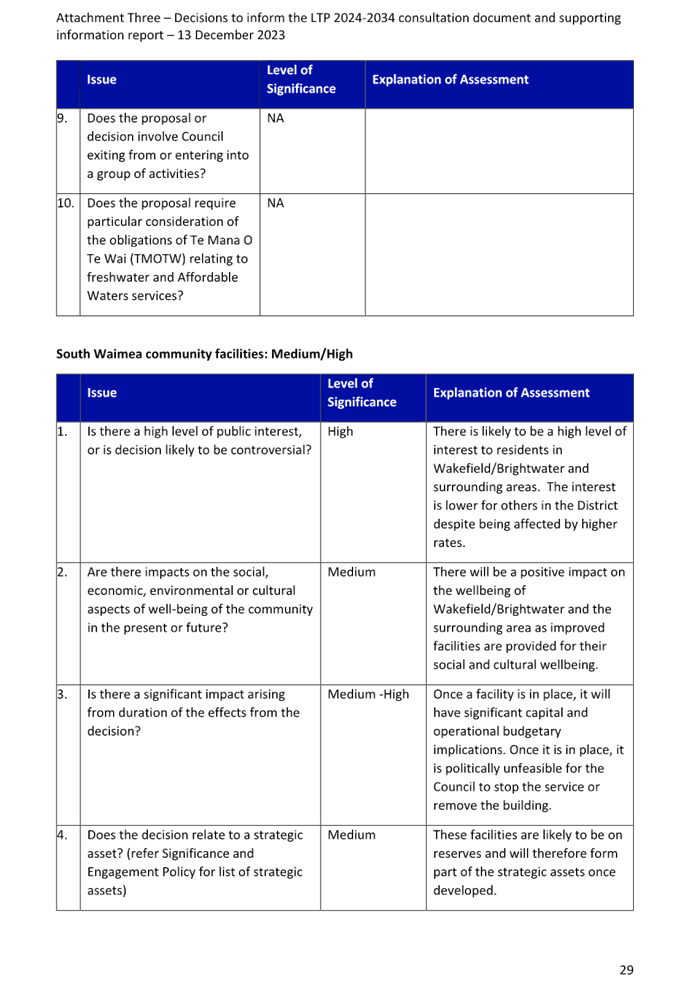


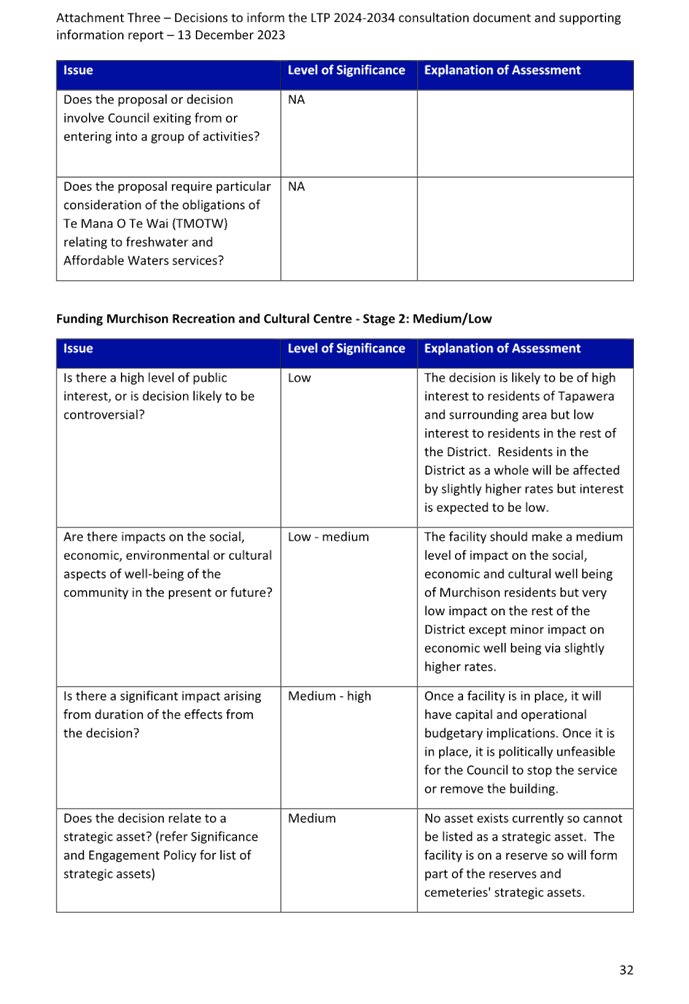




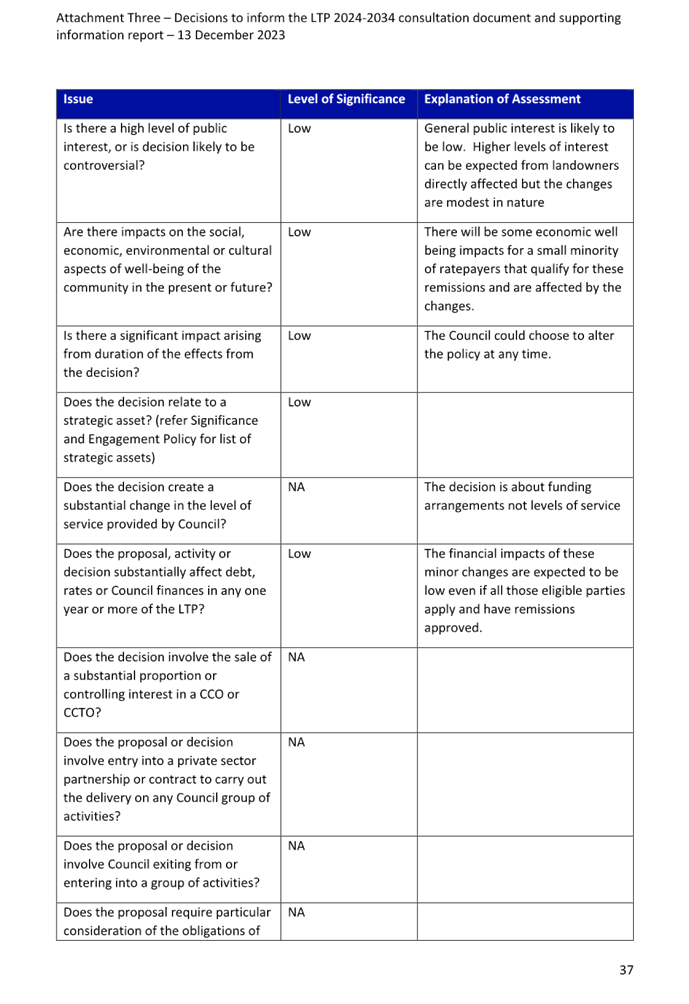
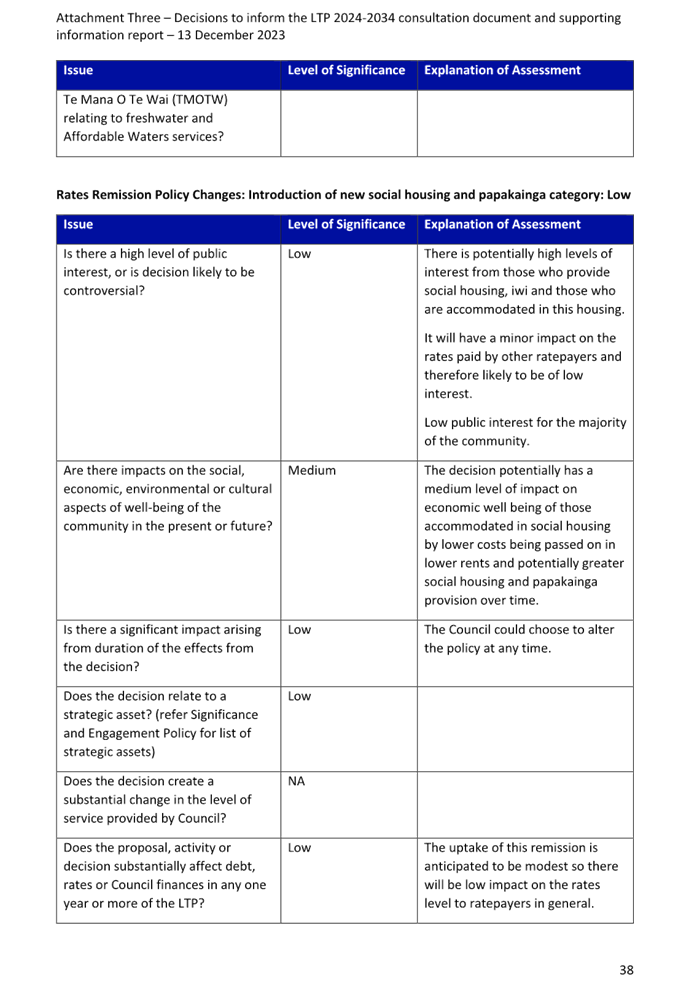
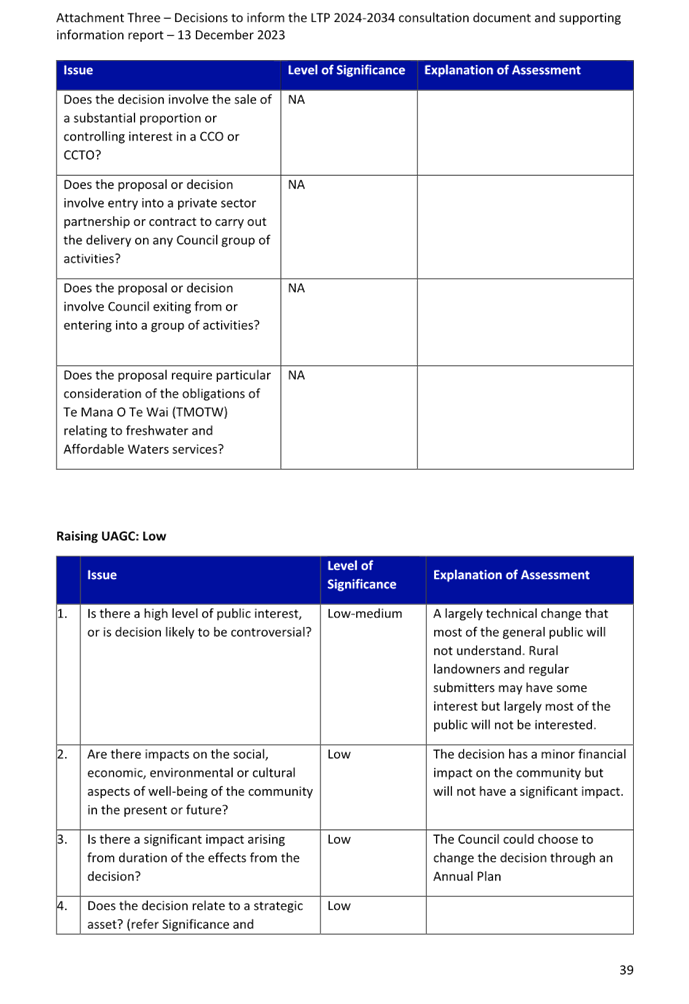
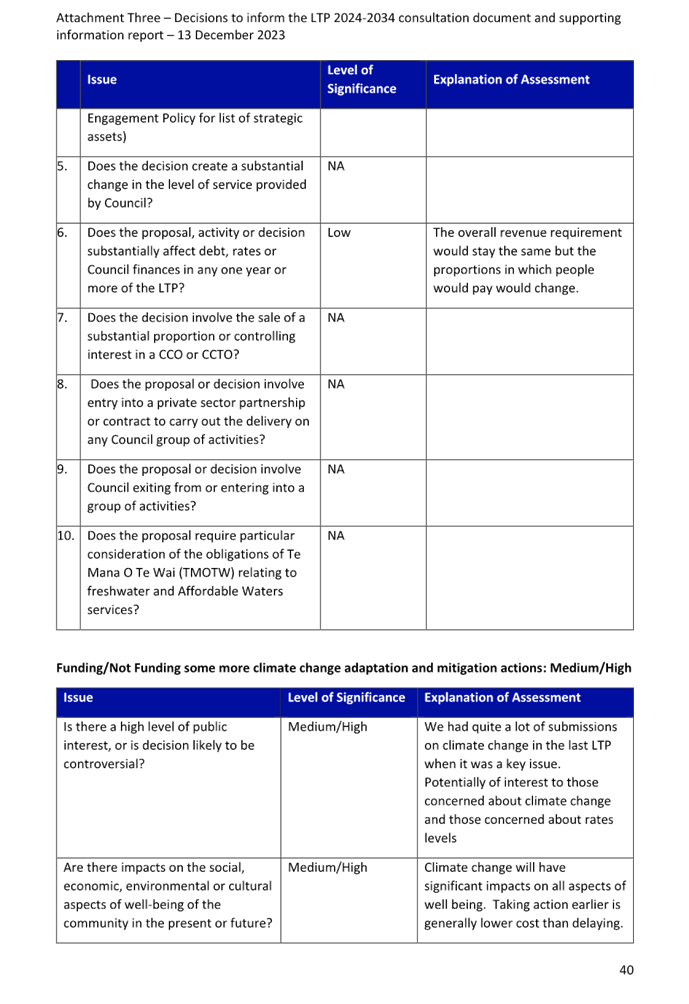
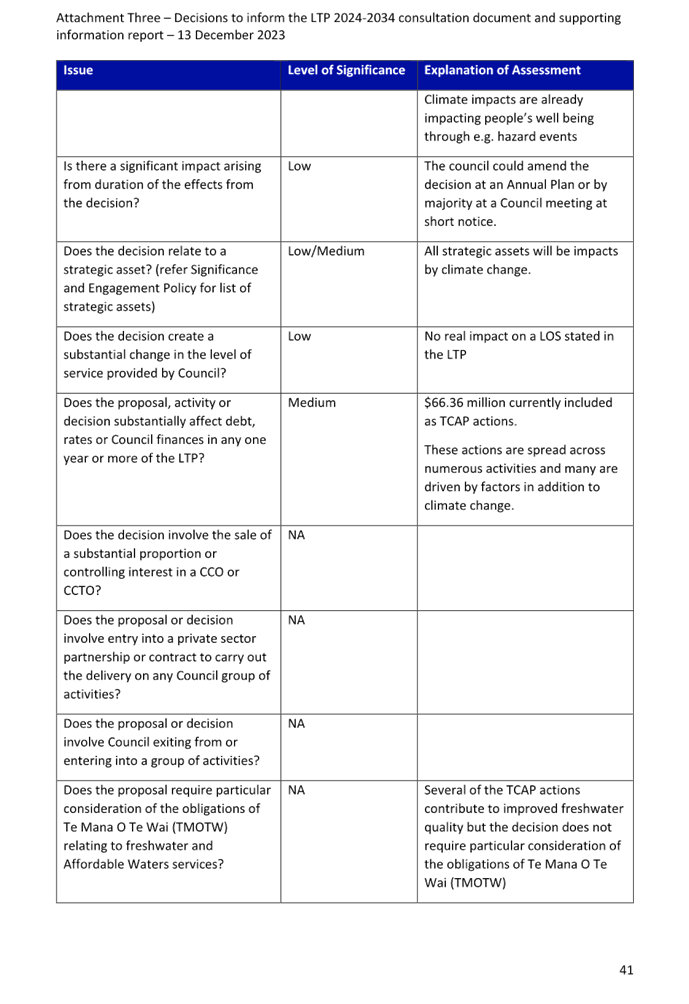

Tasman District Council Agenda – 13 December 2023
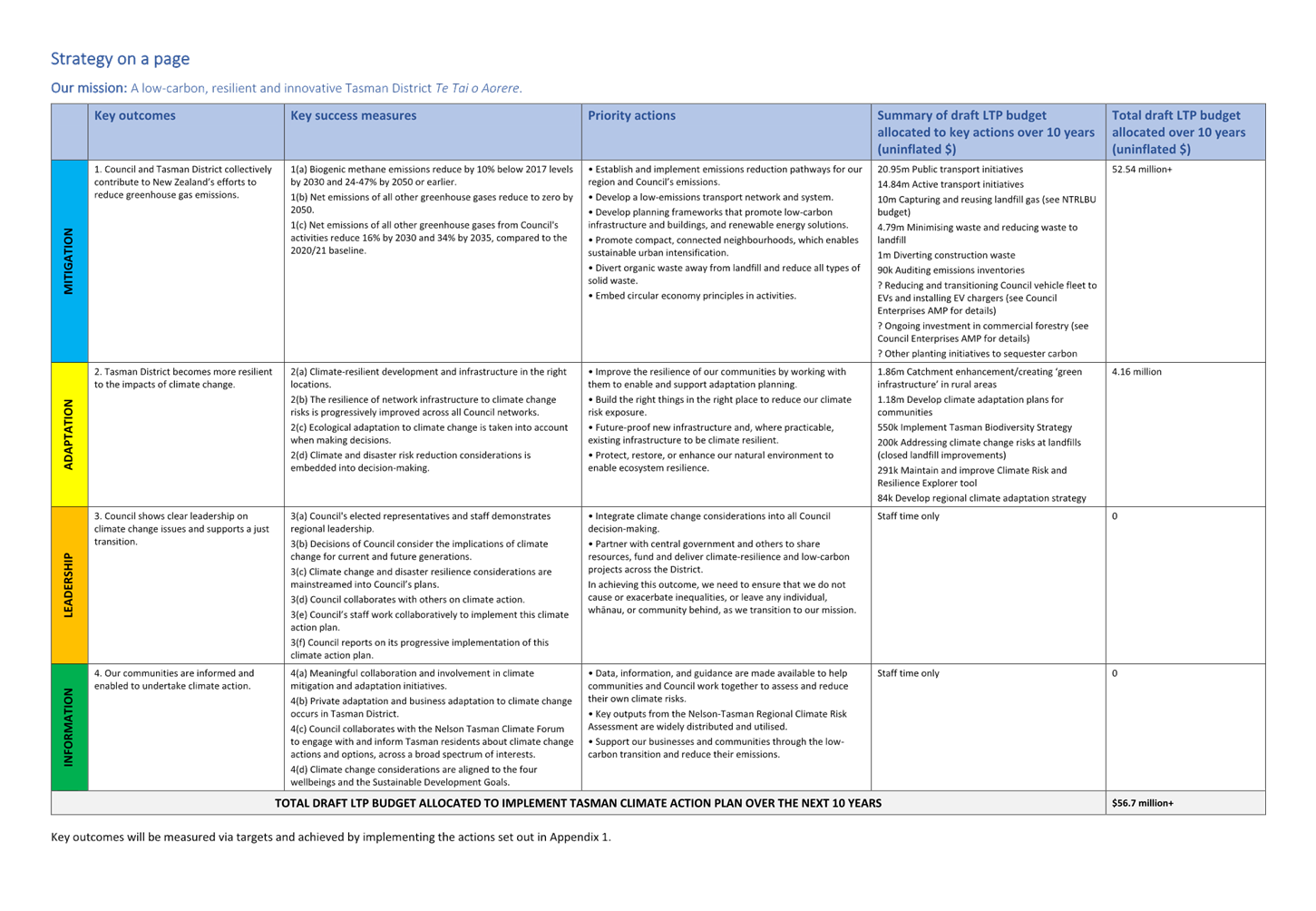
Tasman District
Council
Agenda – 13 December 2023
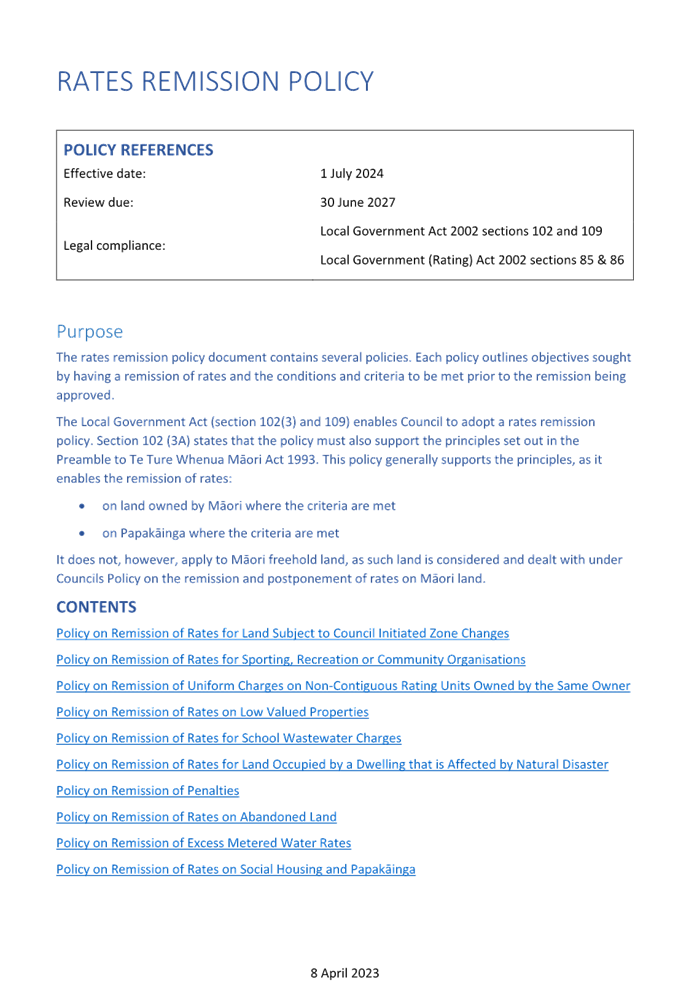

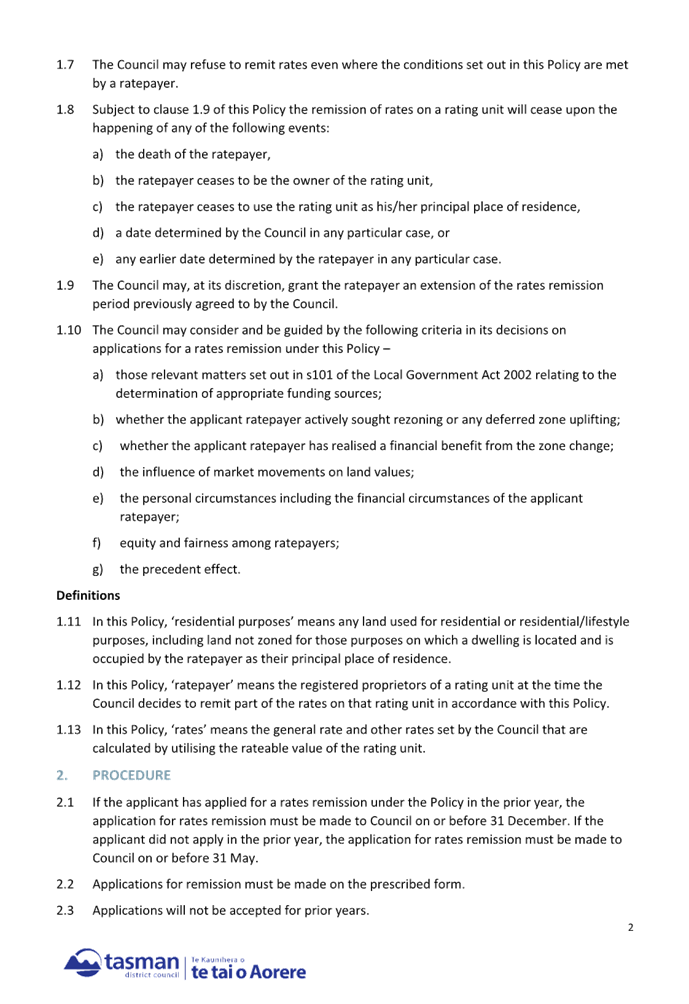

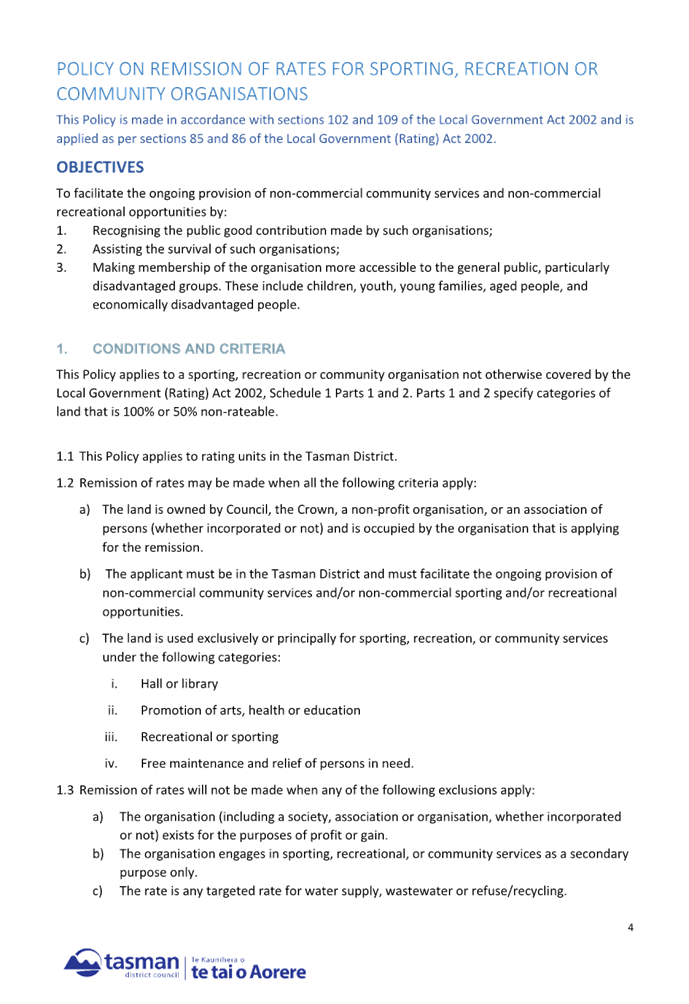
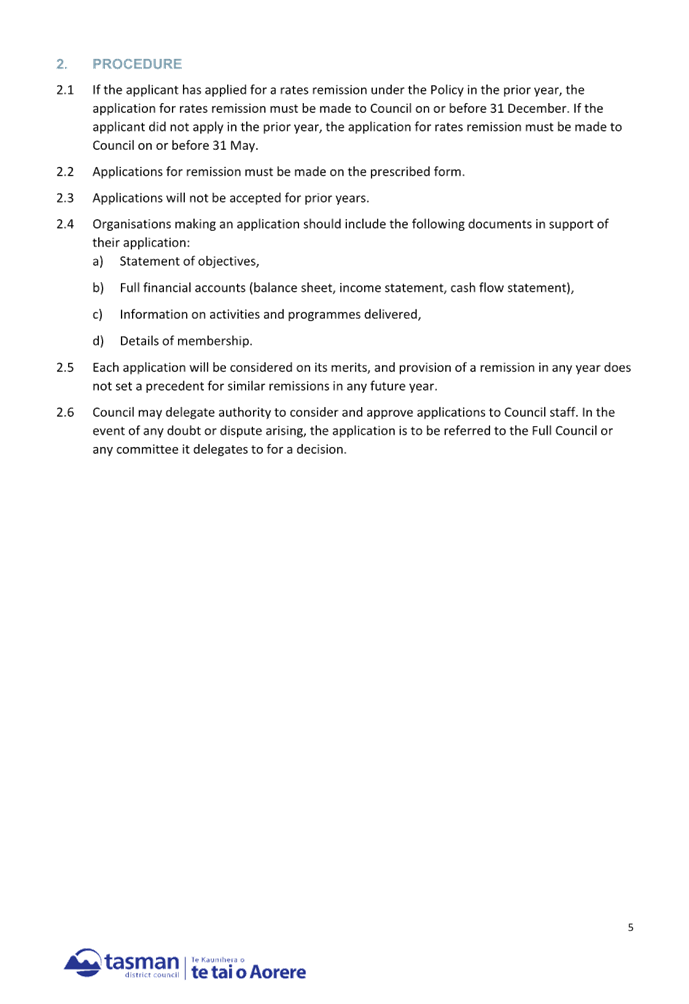
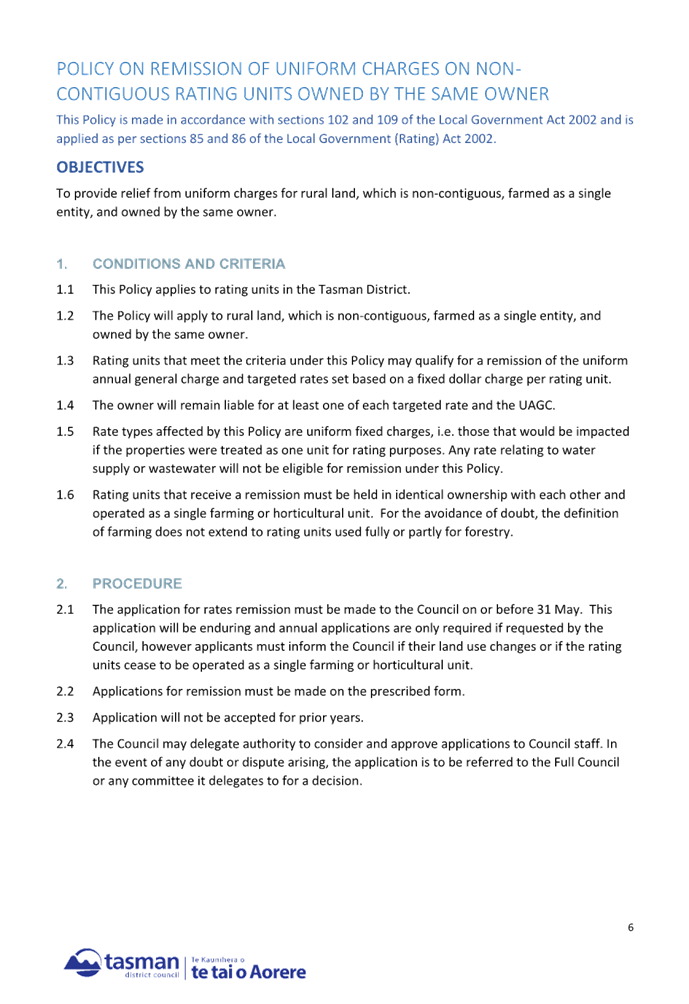
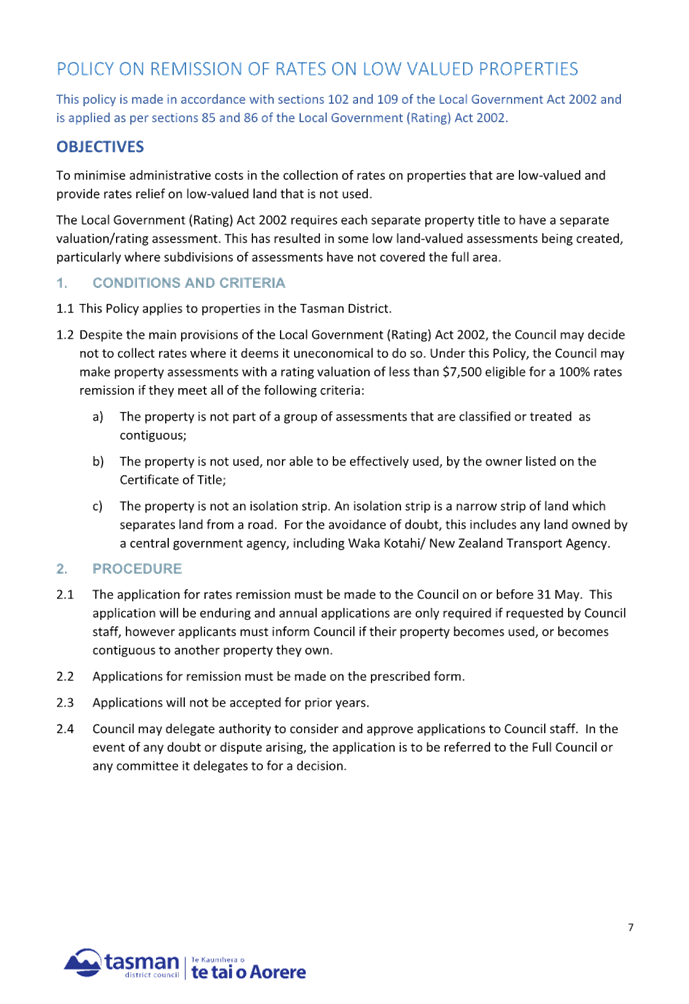
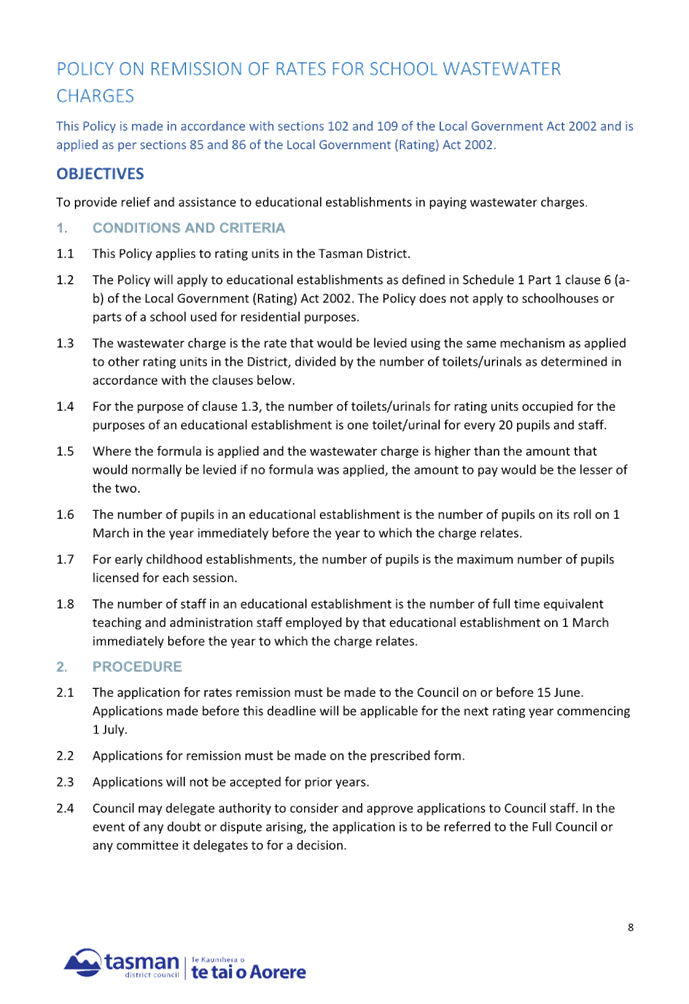
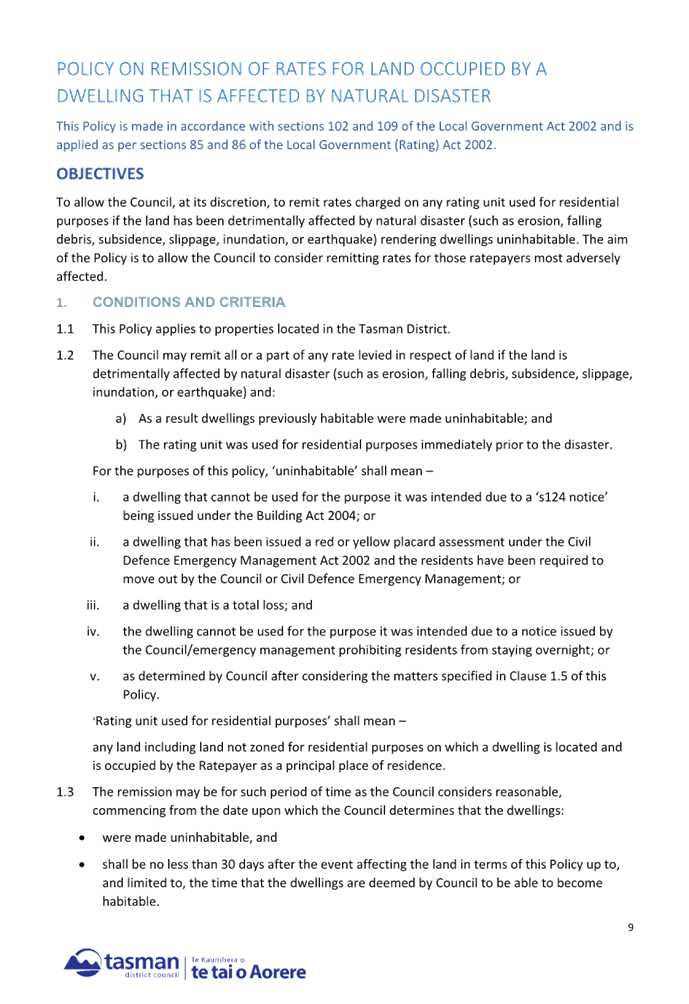
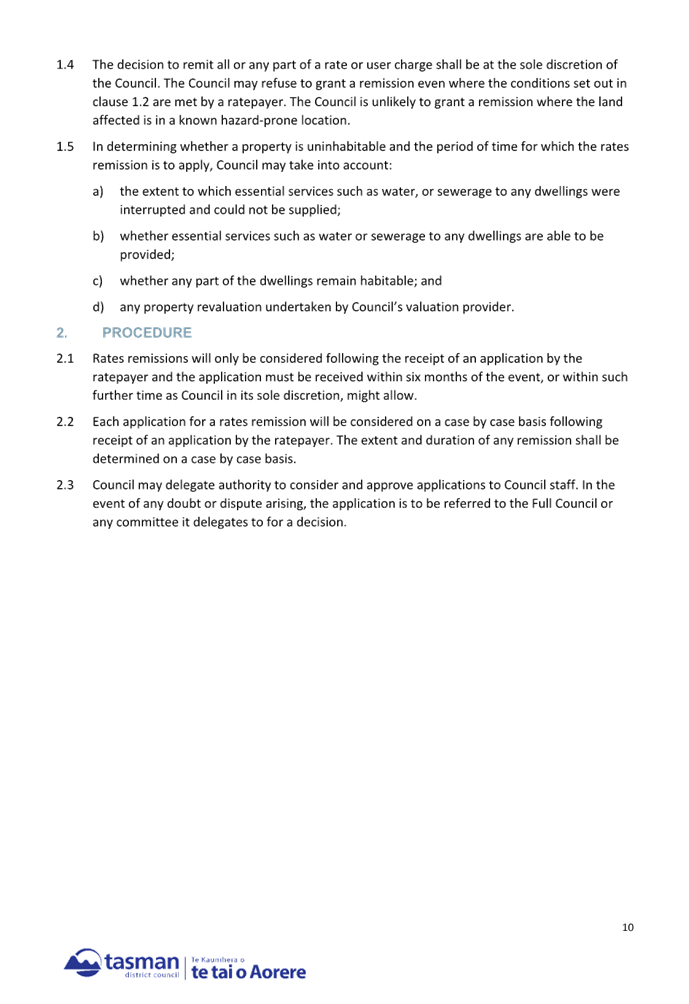
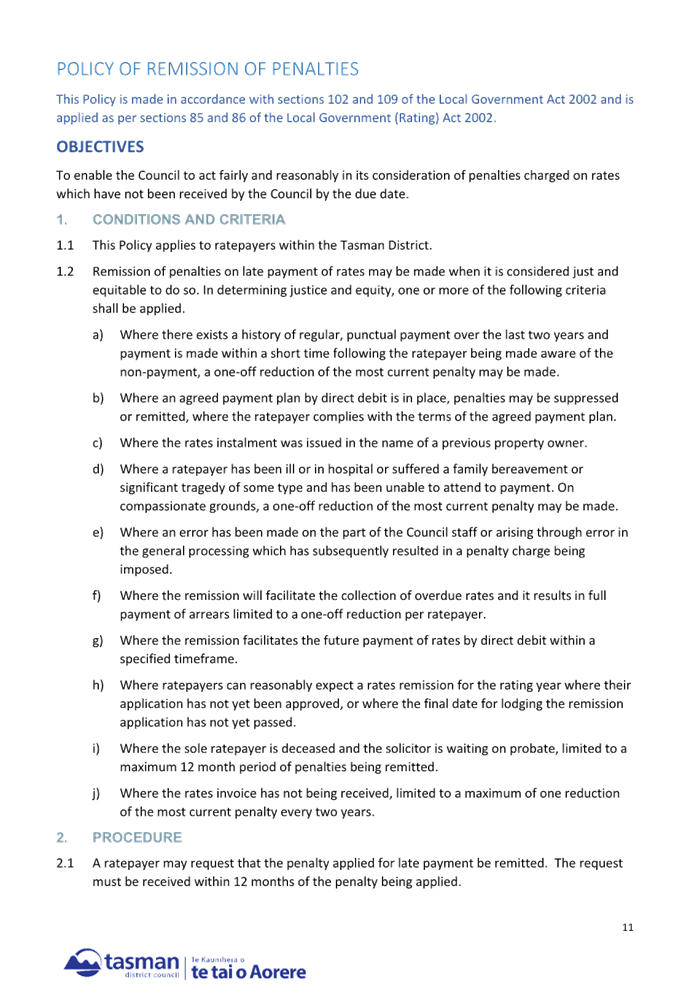

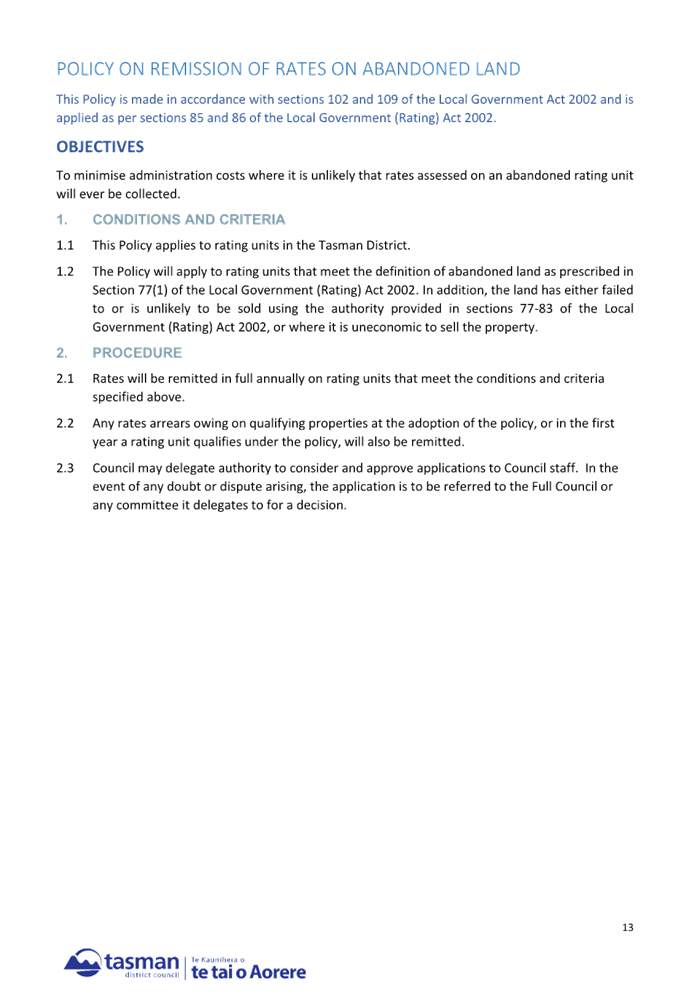
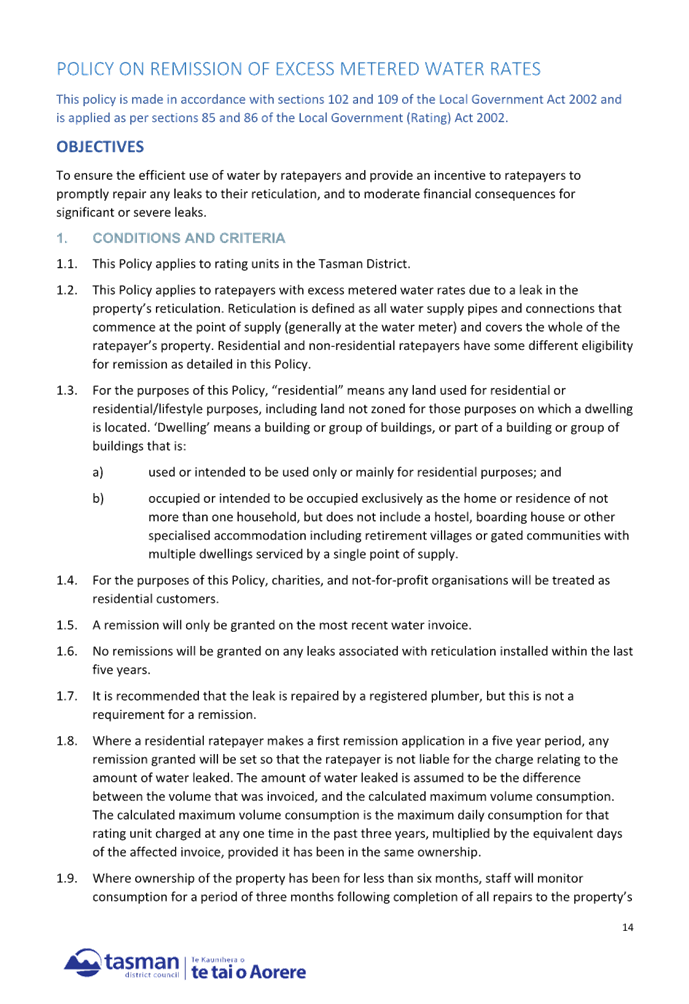
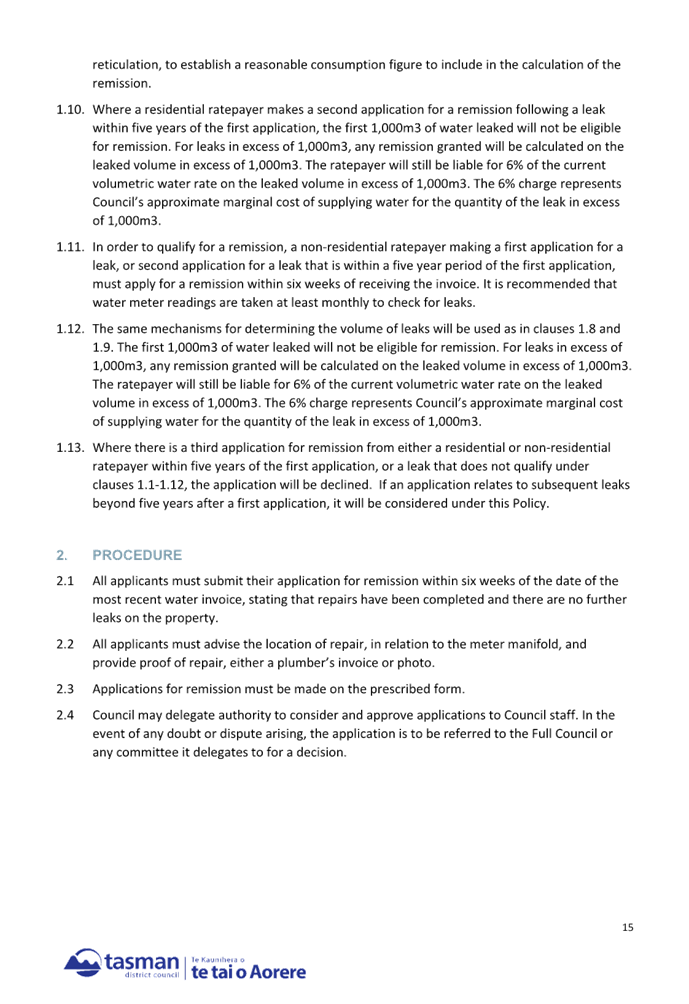
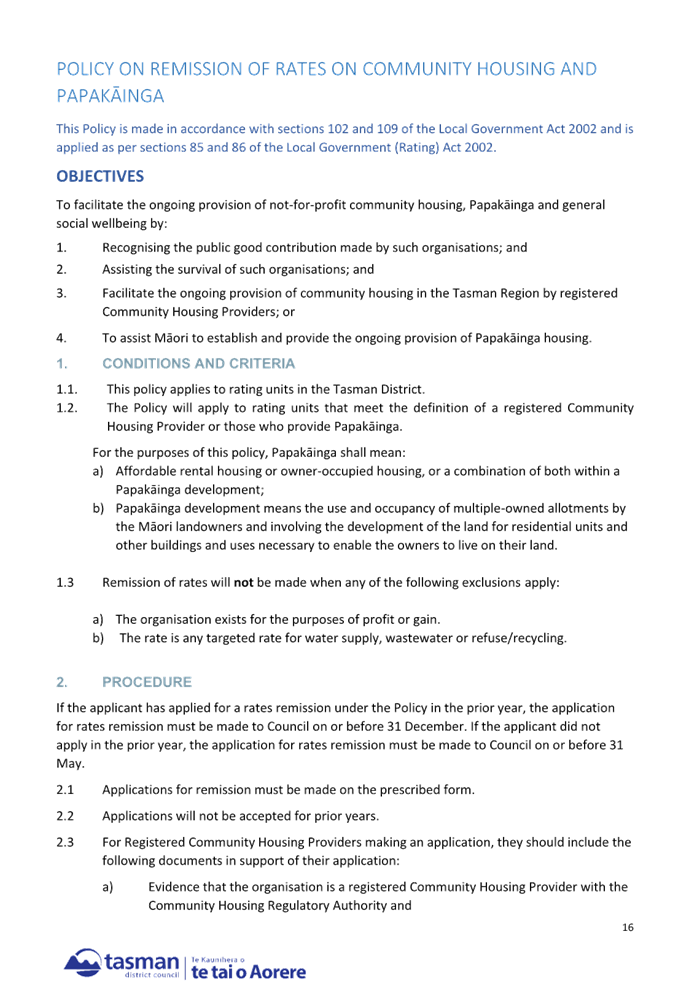
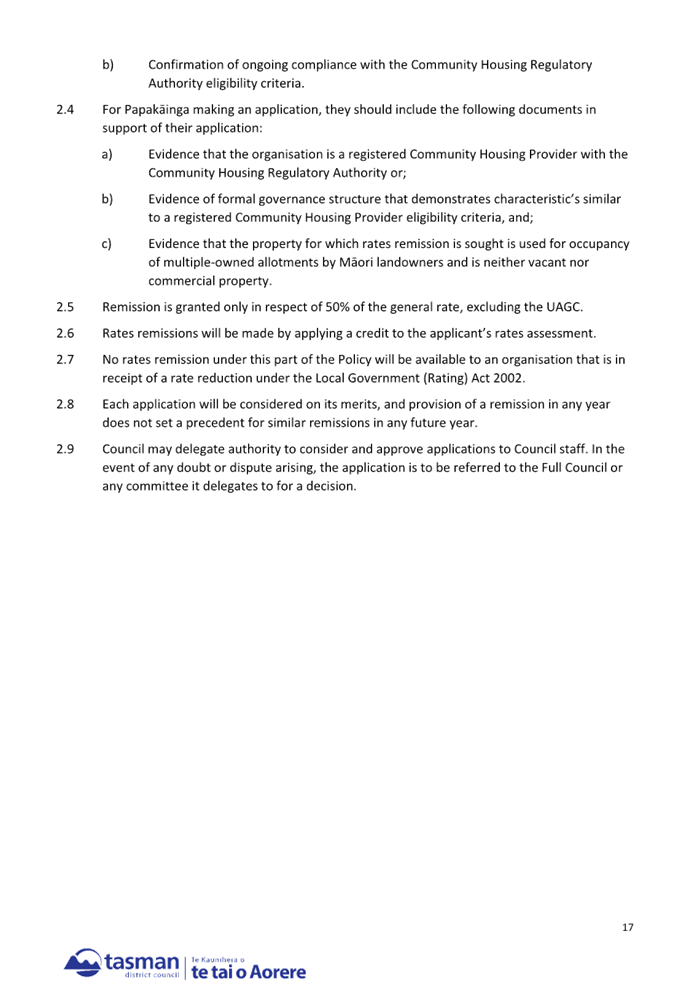
Tasman District Council Agenda – 13 December 2023
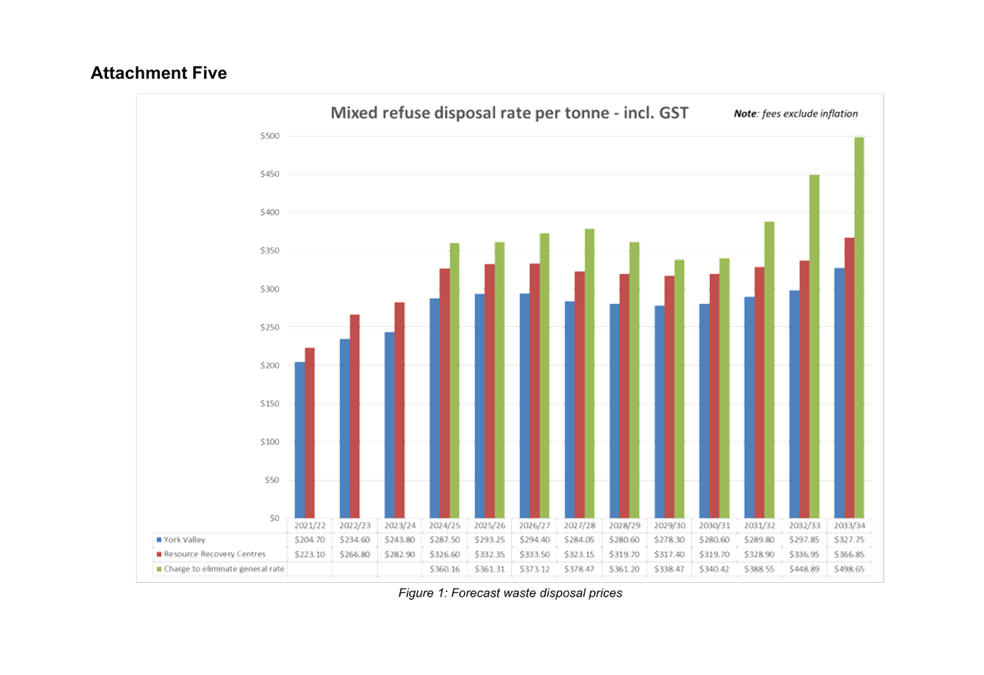
Tasman District
Council
Agenda – 13 December 2023
7.3 Referral Report - Nelson Tasman Regional
Landfill Business Unit - Annual Report 2022/2023 and Annual Financial
Statements 2023
|
Report
To:
|
Tasman
District Council
|
|
Meeting
Date:
|
13
December 2023
|
|
Report
Author:
|
Mike
Schruer, Waters and Wastes Manager; Elaine Stephenson, Team Leader -
Democracy Services
|
|
Report
Authorisers:
|
Richard
Kirby, Group Manager - Community Infrastructure
|
|
Report
Number:
|
RCN23-12-9
|
1. Purpose
of the Report / Te Take mō te Pūrongo
1.1 To
present the recommendations of the Nelson Tasman Regional Landfill Business
Unit (NTRLBU) for the Council to receive its Annual Report and draft Annual
Financial Statements 2023.
2. Summary
/ Te Tuhinga Whakarāpoto
2.1 The
NTRLBU Annual Report 2022/23 (Attachment 1) and the draft Annual
Financial Statements 2023 (Attachment 2) were presented to the NTRLBU
joint committee on
18 August 2023, and the meeting recommended as follows:
That the
Nelson City Council and Tasman District Councils
1. Receive
the Nelson Tasman Regional Landfill Business Unit Annual Report 2022/23 (27132)
and its attachments (749984575-1082 and 1995708647-51).
3. Recommendation/s
/ Ngā Tūtohunga
That the Tasman
District Council receives the Referral Report - Nelson Tasman Regional Landfill
Business Unit - Annual Report 2022/2023 and Annual Financial Statements 2023
(Attachment 1 to the agenda report) and draft Annual Financial Statements 2023
(Attachment 2 to the agenda report) RCN23-12-9.
|
1.⇨
|
Draft Nelson
Tasman Regional Landfill Business Unit Annual Report 2022-2023 (Under
Separate Cover)
|
|
|
2.⇨
|
Nelson
Tasman Regional Landfill Business Unit Draft Financial Statements 2023
(Under Separate Cover)
|
|
Tasman District
Council
Agenda – 13 December 2023
7.4 Referral Report - Nelson Tasman Regional
Landfill Business Unit Business Plan 2024 - 2025
|
Report
To:
|
Tasman
District Council
|
|
Meeting
Date:
|
13 December
2023
|
|
Report
Author:
|
Mike
Schruer, Waters and Wastes Manager; Elaine Stephenson, Team Leader -
Democracy Services
|
|
Report
Authorisers:
|
Richard
Kirby, Group Manager - Community Infrastructure
|
|
Report
Number:
|
RCN23-12-10
|
1. Purpose
of the Report / Te Take mō te Pūrongo
1.1 To
present the Nelson Tasman Regional Landfill Business Unit Business Plan
(NTRLBU) 2024 – 2025 for the Council’s approval.
2. Summary
/ Te Tuhinga Whakarāpoto
2.1 At
its 1 December 2023 meeting, the NTRLBU recommended to both Councils as
follows:
That the Nelson City Council
and Tasman District Councils
1.
Receive the Nelson Tasman Regional
Landfill Business Unit Business Plan 2024-25 (1399367370-8784);
and
2. Approve
the Nelson Tasman Regional Landfill Business Unit Business Plan 2024-25 (1399367370-8784).
2.2 The
report and attachments to the 1 December 2023 NTRLBU meeting are appended as Attachment
1.
3. Recommendation/s
/ Ngā Tūtohunga
That the Tasman
District Council
1. receives
the Referral Report - Nelson Tasman Regional Landfill Business Unit Business
Plan 2024 - 2025 report RCN23-12-10; and
2. receives the Nelson Tasman Regional Landfill Business
Unit Business Plan 2024 – 2025 (Attachment 1 to the agenda report); and
3. approves
the Nelson Tasman Regional Landfill Business Unit Business Plan 2024-25
(Attachment 1 to the agenda report).
|
1.⇨
|
NRSBU
Business Plan 2024-25 Business Plan report to 1 December meeting (Under
Separate Cover)
|
|
Tasman District
Council
Agenda – 13 December 2023
7.5 Referral Report - Nelson Tasman Regional
Landfill Business Unit Activity Management Plan 2024 - 2034
|
Report
To:
|
Tasman
District Council
|
|
Meeting
Date:
|
13
December 2023
|
|
Report
Author:
|
Mike
Schruer, Waters and Wastes Manager; Elaine Stephenson, Team Leader -
Democracy Services
|
|
Report
Authorisers:
|
Richard
Kirby, Group Manager - Community Infrastructure
|
|
Report
Number:
|
RCN23-12-11
|
1. Purpose
of the Report / Te Take mō te Pūrongo
1.1 To
present the Nelson Tasman Regional Landfill Business Unit (NTRLBU) Activity
Management Plan 2024 – 2034 for the Council’s approval.
2. Summary
/ Te Tuhinga Whakarāpoto
2.1 At
its 1 December 2023 meeting, the NTRLBU recommended to both councils as
follows:
That the Nelson City Council
and Tasman District Councils
1. Receive
the Nelson Tasman Regional Landfill Business Unit Activity Management Plan
2024-34 (1399367370-8789); and
2. Approve
the Nelson Tasman Regional Landfill Business Unit Activity Management Plan
2023-34 (1399367370-8789) as the version to inform the development of the Long
Term Plan 2024-34; and
3. Notes
that the Nelson Tasman Regional Landfill Business Unit Activity Management Plan
2023-24(1399367370-8789) will be updated, and the final Activity Management
Plan approved by Council after the adoption of the Long Term Plan 2024-2034.
2.2 The
report and its attachments to the 1 December 2023 NTRLBU meeting are appended
as Attachment 1.
3. Recommendation/s
/ Ngā Tūtohunga
That the Tasman
District Council
1. receives
the Referral Report - Nelson Tasman Regional Landfill Business Unit Activity
Management Plan 2024 - 2034 report, RCN23-12-11; and
2. receives
the Nelson Tasman Regional Landfill Business Unit Activity Management Plan
2024-34 (Attachment 1 to the agenda report); and
3. approves
the Nelson Tasman Regional Landfill Business Unit Activity Management Plan
2023-34 (Attachment 1 to the agenda report) as the version to inform the
development of the Long Term Plan 2024-2034; and
4. notes
that the Nelson Tasman Regional Landfill Business Unit Activity Management Plan
2023-24 (Attachment 1 to the agenda report) will be updated, and the final
Activity Management Plan approved by the Council after the adoption of the Long
Term Plan 2024-2034.
|
1.⇨
|
NRSBU AMP
2024-34 report to 1 December 2023 meeting (Under Separate Cover)
|
|
Tasman District
Council
Agenda – 13 December 2023
7.6 Referral Report - Nelson Regional Sewerage
Business Unit - Annual Report 2022/2023 and Annual Financial Statements 2023
|
Report
To:
|
Tasman
District Council
|
|
Meeting
Date:
|
13
December 2023
|
|
Report
Author:
|
Mike
Schruer, Waters and Wastes Manager; Elaine Stephenson, Team Leader -
Democracy Services
|
|
Report
Authorisers:
|
Richard
Kirby, Group Manager - Community Infrastructure
|
|
Report
Number:
|
RCN23-12-12
|
1. Purpose
of the Report / Te Take mō te Pūrongo
1.1 For
the Council to receive the Nelson Regional Sewerage Business Unit (NRSBU)
Annual Report and draft Annual Financial Statements 2023.
2. Summary
/ Te Tuhinga Whakarāpoto
2.1 The
NRSBU Annual Report 2022/2023 (Attachment 1) and the accompanying Annual
Financial Statements (Attachment 2) were presented to the NRSBU joint
committee on 1 September 2023, and the meeting recommended as follows:
RSBU/2023/021
That the Nelson City Council and Tasman District Council
1. Receives
the Nelson Regional Sewerage Business Unit Annual Report 2022/23
(1080325921-573) and Financial Statements (1080325921-577).
3. Recommendation/s
/ Ngā Tūtohunga
That the Tasman District Council receives the Referral Report -
Nelson Regional Sewerage Business Unit - Annual Report 2022/2023 and Annual
Financial Statements 2023 (Attachment 1 to the agenda report) and draft Annual
Financial Statements 2023 (Attachment 2 to the agenda report).
|
1.⇨
|
NRSBU
Annual Report 2022-2023 (Under Separate Cover)
|
|
|
2.⇨
|
NRSBU
Annual Financial Statements 2022-2023 (Under Separate Cover)
|
|
|
3.⇨
|
Report to
1 September 2023 NRSBU meeting (Under Separate Cover)
|
|
Tasman District
Council
Agenda – 13 December 2023
7.7 Referral Report - Nelson Regional Sewerage
Business Unit Master Plan
|
Report
To:
|
Tasman
District Council
|
|
Meeting
Date:
|
13
December 2023
|
|
Report
Author:
|
Mike
Schruer, Waters and Wastes Manager; Elaine Stephenson, Team Leader -
Democracy Services
|
|
Report
Authorisers:
|
Richard
Kirby, Group Manager - Community Infrastructure
|
|
Report
Number:
|
RCN23-12-13
|
1. Purpose
of the Report / Te Take mō te Pūrongo
1.1 To
present the Nelson Regional Sewerage Business Unit’s (NRSBU) Master Plan
2024 – 2075 to the Council for review and provision of feedback to the
NRSBU, if required.
2. Summary
/ Te Tuhinga Whakarāpoto
2.1 At
its 1 September 2023 meeting the NRSBU’s Master Plan 2024 – 2075
was considered by the NRSBU.
2.2 Following
consideration, it was noted that the Master Plan held the same status as
Infrastructure Strategies that were required to be prepared by each council (to
form part of each council’s Long Term Plan and consultation) and that the
same rigour was needed to apply to the Master Plan.
2.3 As
officers had not had adequate time to review the Master Plan, and iwi had not
had input into its preparation, it was suggested that the Master Plan should be
sent to each council for consideration as part of a bigger discussion.
2.4 The
1 September 2023 NRSBU meeting recommended to both councils as follows:
RSBU/2023/023
That
the Nelson City Council and Tasman District Council
1. Receive
the Nelson Regional Sewerage Business Unit Wastewater Master Plan
(1080325921-551) for review and provide feedback to the Nelson Regional
Sewerage Business Unit if required.
2.5 The
report and attachments to the 1 September 2023 NRSBU meeting are appended as
Attachment 1.
3. Recommendation/s
/ Ngā Tūtohunga
That the Tasman
District Council
1. receives
the Referral Report - Nelson Regional Sewerage Business Unit Master Plan report
RCN23-12-13; and
2. receives
the Nelson Regional Sewerage Business Unit Wastewater Master Plan (Attachment 1
to the agenda report (1080325921-551)) for review and provides feedback to the
Nelson Regional Sewerage Business Unit, if required.
|
1.⇨
|
Master
Plan 2024 - 2075 Report to 1 September 2023 NRSBU meeting (Under Separate
Cover)
|
|
Tasman District
Council
Agenda – 13 December 2023
7.8 Referral Report - Nelson Regional Sewerage
Business Unit Business Plan 2024 - 2025
|
Report
To:
|
Tasman
District Council
|
|
Meeting
Date:
|
13
December 2023
|
|
Report
Author:
|
Mike
Schruer, Waters and Wastes Manager; Elaine Stephenson, Team Leader -
Democracy Services
|
|
Report
Authorisers:
|
Richard
Kirby, Group Manager - Community Infrastructure
|
|
Report
Number:
|
RCN23-12-14
|
1. Purpose
of the Report / Te Take mō te Pūrongo
1.1 To
present the Nelson Regional Sewerage Business Plan (NRSBU) 2024-2025 to the
Council for approval.
2. Summary
/ Te Tuhinga Whakarāpoto
2.1 At
its 28 November 2023 meeting, the NRSBU recommended to both councils as
follows:
That the Nelson City Council
and Tasman District Councils
1. Receive
the Nelson Regional Sewerage Business Unit Business Plan 2024-25 (1080325921-756),
and
2. Approve
the Nelson Regional Sewerage Business Unit Business Plan 2024-25 (1080325921-756).
2.2 The
report and its attachment to the 28 November 2023 NRSBU meeting are appended as
Attachment 1.
3. Recommendation/s
/ Ngā Tūtohunga
That the Tasman
District Council
1. receives
the Referral Report - Nelson Regional Sewerage Business Unit Business Plan 2024
- 2025 RCN23-12-14; and
2. receives the Nelson Regional Sewerage Business Unit
Business Plan 2024-25 (Attachment 1 to the agenda report (1080325921-756)), and
3. approves the Nelson Regional Sewerage Business Unit
Business Plan 2024-25 (Attachment 1 to the agenda report (1080325921-756)).
|
1.⇨
|
NRSBU
Business Plan 2024-25 report to 28 November meeting (Under Separate Cover)
|
|
Tasman District
Council
Agenda – 13 December 2023
7.9 Referral Report - Nelson Regional Sewerage
Business Unit Activity Management Plan 2024 - 2034
|
Report
To:
|
Tasman
District Council
|
|
Meeting
Date:
|
13
December 2023
|
|
Report
Author:
|
Mike
Schruer, Waters and Wastes Manager; Elaine Stephenson, Team Leader -
Democracy Services
|
|
Report
Authorisers:
|
Richard
Kirby, Group Manager - Community Infrastructure
|
|
Report
Number:
|
RCN23-12-15
|
1. Purpose
of the Report / Te Take mō te Pūrongo
1.1 To
present the Nelson Regional Sewerage Business Unit (NRSBU) Activity Management
Plan 2024 - 2034 for approval to inform the development of the Long Term Plan
(LTP) 2024 – 2034.
2. Summary
/ Te Tuhinga Whakarāpoto
2.1 At
its 28 November 2023 meeting, the NRSBU recommended to both Councils:
That the Nelson City Council
and Tasman District Council
1. Receive
the Nelson Regional Sewerage Business Unit Activity Management Plan 2024-34
(1080325921-753); and
2. Approve
the Nelson Regional Sewerage Business Unit Activity Management Plan 2024-34
(1080325921-753) as the version to inform the development of the Long Term
Plan 2024-34; and
3. Note
that the Nelson Regional Sewerage Business Unit Activity Management Plan 2024-34
(1080325921-753) will be updated, and the final Activity Management Plan approved
by Council after the adoption of the Long Term Plan 2024-2034.
2.2 The
report and its attachment to the 28 November 2023 NRSBU meeting are appended as
Attachment 1.
3. Recommendation/s
/ Ngā Tūtohunga
That the Tasman
District Council
1. receives
the Referral Report - Nelson Regional Sewerage Business Unit Activity
Management Plan 2024 - 2034 report RCN23-12-15; and
2. receives the Nelson Regional Sewerage Business Unit
Activity Management Plan 2024-34 (Attachment 1 to the agenda report
(1080325921-753)); and
3. approves
the Nelson Regional Sewerage Business Unit Activity Management Plan 2024-34 (Attachment 1 to the agenda report (1080325921-753)) as
the version to inform the development of the Long Term Plan 2024-34; and
4. notes
that the Nelson Regional Sewerage Business Unit Activity Management Plan
2024-34 (Attachment 1 to the agenda
report (1080325921-753)) will be updated, and the final Activity
Management Plan approved by the Council after the adoption of the Long Term
Plan 2024-2034.
|
1.⇨
|
NRSBU AMP
report to 28 November 2023 meeting (Under Separate Cover)
|
|
Tasman District
Council
Agenda – 13 December 2023
7.10 Referral Report: Golden Bay Reserve Financial Contributions
|
Report
To:
|
Tasman
District Council
|
|
Meeting
Date:
|
13
December 2023
|
|
Report
Author:
|
Grant
Reburn, Reserves and Facilities Manager; Elaine Stephenson, Team Leader -
Democracy Services
|
|
Report
Authorisers:
|
Richard
Kirby, Group Manager - Community Infrastructure
|
|
Report
Number:
|
RCN23-12-16
|
1. Purpose
of the Report / Te Take mō te Pūrongo
1.1 To
present the 10 July 2023 Golden Bay Community Board recommendations to the
Council regarding Golden Bay Reserve Financial Contribution projects in the
2023/2024 financial year.
2. Summary
/ Te Tuhinga Whakarāpoto
2.1 At
its 10 July 2023 meeting, the Golden Bay Community Board resolved as follows:
That the Tasman District Council
1. receives
the Referral Report: Golden Bay Reserve Financial Contributions RCN23-12-16;
and
2. recommends to Council the proposed Reserve Financial
Contribution carry forward from the 2022/2023 financial year into the 2023/2024
financial year, for the following projects:
· $8,736 from the
Walkways and Esplanade general account
· $180,927 for
the Playgrounds general account; and
3. Recommends
to Council the additional budget allocation of $40,000 in the 2023/2024
financial year from the Golden Bay Ward Reserves Financial Contributions as
additional funding for the following projects:
· $40,000 to the
Sportsfield General account; and
4. Recommends to Council the Reserve
Financial Contributions Capital projects to be undertaken in the 2023/2024
financial year and the projects proposed for the following year as set out in
the following table; and
|
Project Name
|
Work
Description
|
Budget
|
|
|
|
2023/24
|
2024/2025
|
|
Sportsfields
|
|
Includes proposed carried forward and addition funding requests.
|
|
|
Golden Bay Rec Park
|
Football training lights
|
40,000
|
|
|
Walkways/Esplanades
|
|
|
|
|
Sunbelt Crescent
Esplanade
|
Pathway &
interpretative signs
|
10,000
|
17,865
|
|
Tata Beach
|
Road and parking
upgrades
|
11,471
|
|
|
Golden Bay
walkways
|
Planting
|
5,000
|
|
|
Picnic Areas/Gardens
|
|
|
|
|
Ward
general
|
Park
furniture
|
16,516
|
|
|
Cemeteries
|
|
|
|
|
Golden Bay
cemeteries
|
Beams
|
5,505
|
|
|
Coastcare
|
|
|
|
|
Coastcare
|
Planting &
Protection
|
22,022
|
22,184
|
|
Playgrounds
|
|
|
88,736
|
|
Playgrounds
General
|
|
|
|
|
Pōhara Campground
|
|
73,400
|
|
|
Ruataniwha Reserve
|
|
60,000
|
|
|
Upper Takaka Rec Reserve
|
|
63,200
|
|
|
Ward Totals
|
|
307,114
|
128,785
|
5. recommends
to Council the Special Purpose Committee project spend of $105,500 for upgrades
and capital works at the Collingwood, Pōhara, Bainham and Pakawau Halls as
outlined in the following table:
|
Mohua /Golden Bay
|
Project
|
Amount Requested
|
Priority
|
|
Collingwood
Hall
|
External
painting.
|
9,500
|
High
|
|
Pōhara
Hall
|
Replace
the roof.
|
70,000
|
High
|
|
Bainham
Hall
|
Picnic
table, blackout curtains
and
stage curtains.
|
8,500
|
Medium
|
|
Pakawau
Hall
|
New
kitchen and relocate water pump.
|
17,500
|
Medium
|
|
Total
|
|
105,500
|
|
Carried
2.2 The
report to the 10 July 2023 Golden Bay Community Board meeting is attached as Attachment
1.
3. Recommendation/s
/ Ngā Tūtohunga
That the Tasman
District Council
1. receives
the Referral Report: Golden Bay Reserve Financial Contributions report, RCN23-12-16;
and
2. approves the
proposed Reserve Financial Contribution carry forward from the 2022/2023
financial year into the 2023/2024 financial year, for the following projects:
· $8,736 from the
Walkways and Esplanade general account
· $180,927 for
the Playgrounds general account; and
3. approves
the additional budget allocation of $40,000 in the 2023/2024 financial year
from the Golden Bay Ward Reserves Financial Contributions as additional funding
for the following projects:
· $40,000 to the
Sportsfield General account; and
4. recommends to
the Council the Reserve Financial Contributions Capital projects
to be undertaken in the 2023/2024 financial year and the projects proposed for
the following year as set out in the following table; and
|
Project Name
|
Work
Description
|
Budget
|
|
|
|
2023/24
|
2024/2025
|
|
Sportsfields
|
|
Includes proposed carried forward and addition funding requests.
|
|
|
Golden Bay Rec Park
|
Football training lights
|
40,000
|
|
|
Walkways/Esplanades
|
|
|
|
|
Sunbelt Crescent
Esplanade
|
Pathway &
interpretative signs
|
10,000
|
17,865
|
|
Tata Beach
|
Road and parking
upgrades
|
11,471
|
|
|
Golden Bay
walkways
|
Planting
|
5,000
|
|
|
Picnic
Areas/Gardens
|
|
|
|
|
Ward general
|
Park
furniture
|
16,516
|
|
|
Cemeteries
|
|
|
|
|
Golden Bay
cemeteries
|
Beams
|
5,505
|
|
|
Coastcare
|
|
|
|
|
Coastcare
|
Planting &
Protection
|
22,022
|
22,184
|
|
Playgrounds
|
|
|
88,736
|
|
Playgrounds
General
|
|
|
|
|
Pohara Campground
|
|
73,400
|
|
|
Ruataniwha Reserve
|
|
60,000
|
|
|
Upper Takaka Rec Reserve
|
|
63,200
|
|
|
Ward Totals
|
|
307,114
|
128,785
|
5. approves
the Special Purpose Committee project spend of $105,500 for upgrades and
capital works at the Collingwood, Pohara, Bainham and Pakawau Halls as outlined
in the following table:
|
Mohua /Golden Bay
|
Project
|
Amount Requested
|
Priority
|
|
Collingwood
Hall
|
External
painting.
|
9,500
|
High
|
|
Pohara
Hall
|
Replace
the roof.
|
70,000
|
High
|
|
Bainham
Hall
|
Picnic
table, blackout curtains
and
stage curtains.
|
8,500
|
Medium
|
|
Pakawau
Hall
|
New
kitchen and relocate water pump.
|
17,500
|
Medium
|
|
Total
|
|
105,500
|
|
|
1.⇨
|
Reserve
Financial Contributions Report to the 10 July 2023 Golden Bay Community Board
meeting (Under Separate Cover)
|
|
Tasman District
Council
Agenda – 13 December 2023
7.11 Referral Report: Motueka Reserve Financial Contributions
|
Report
To:
|
Tasman
District Council
|
|
Meeting
Date:
|
13 December
2023
|
|
Report
Author:
|
Grant
Reburn, Reserves and Facilities Manager; Elaine Stephenson, Team Leader -
Democracy Services
|
|
Report
Authorisers:
|
Richard
Kirby, Group Manager - Community Infrastructure
|
|
Report
Number:
|
RCN23-12-17
|
1. Purpose
of the Report / Te Take mō te Pūrongo
1.1 To
present the 17 October 2023 Motueka Community Board recommendations to the
Council regarding Motueka Reserve Financial Contribution projects in the
2023/2024 financial year.
2. Summary
/ Te Tuhinga Whakarāpoto
2.1 At
its 17 October 2023 meeting, the Motueka Community Board resolved as follows:
MCB23-10-7
That the Motueka Community
Board:
1. receives
the Motueka Reserve Financial Contributions report RMCB23-10-5; and
2. notes
the opening balance of the Reserve Financial Contributions account for the
2023/2024 year is $1,871,198; and
3. notes
that the Council has committed $1.4 million of funding from Motueka Ward
Reserves Financial Contributions to partly fund the purchase of a property in
King Edward Street; and
4. notes
that final confirmation on the purchase or otherwise of the King Edward Street
property will occur on 20th October 2023; and
5. notes
the recommendations in the report are based on the $1.4 million being spent;
and
6. recommends
to Council that the following Reserve Financial Contribution projects are
undertaken in the 2023/2024 financial year.
a. Decks
Reserve – playground upgrade $400,000
b. Motueka
Skate park – completion $50,000
c. Stephens
Bay/Little Kaiteriteri walkway $16,198
d. Keep
Motueka – beautification projects $5,000; and
7. requests
that the projects not able to be undertaken in the 2023/2024 financial year are
considered as part of future project prioritisation; and
8. agrees
that this decision remains confidential until a final decision has been made on
the land purchase in King Edward Street.
CARRIED
2.2 The
report to the 17 October 2023 Motueka Community Board meeting is attached as Attachment
1.
3. Recommendation/s
/ Ngā Tūtohunga
That the Tasman
District Council
1. receives
the Referral Report: Motueka Reserve Financial Contributions report
RCN23-12-17; and
2. approves
that the following Reserve Financial Contribution projects are undertaken in
the 2023/2024 financial year.
a. Decks
Reserve – playground upgrade $400,000
b. Motueka
Skate park – completion $50,000
c. Stephens
Bay/Little Kaiteriteri walkway $16,198
d. Keep
Motueka – beautification projects $5,000;
and
2. agrees
that the projects not able to be undertaken in the 2023/2024 financial year are
considered as part of future project prioritisation.
|
1.⇨
|
Reserve
Financial Contributions Report to the 17 October 2023 Motueka Community Board
Meeting (Under Separate Cover)
|
|
Tasman District
Council
Agenda – 13 December 2023
7.12 Referral Report - Regional Pest Management Plan 2019 - 2029 Partial
Review Consultation
|
Report
To:
|
Tasman
District Council
|
|
Meeting
Date:
|
13
December 2023
|
|
Report
Author:
|
Paul
Sheldon, Special Projects Analyst - Biosecurity; Elaine Stephenson, Team
Leader - Democracy Services
|
|
Report
Authorisers:
|
Steve
Manners, Group Manager - Information, Science and Technology
|
|
Report
Number:
|
RCN23-12-18
|
1. Purpose
of the Report / Te Take mō te Pūrongo
1.1 To
present the Regional Pest Management Joint Committee’s recommendation
regarding the Regional Pest Management Plan 2019 – 2029 Partial review Consultation
to the Council for approval.
2. Summary
/ Te Tuhinga Whakarāpoto
2.1 At
its 8 December 2023 meeting, the Regional Pest Management Joint Committee considered
the Regional Pest Management Plan 2019 – 2029 Partial review Consultation
and resolved as follows.
RPMC23-12-30
That the
Regional Pest Management Joint Committee:
1. receives the Regional Pest
Management Plan 2019 – 2029 Partial Review Consultation report
RRPMC23-12-1; and
2. approves the draft Regional Pest Management Plan 2019 – 2029
Partial Review Consultation document (Attachment 1 to the agenda report) for
the formal partial review consultation process; and
3. recommends to Tasman District Council and Nelson City Council that
they approve public notification of the draft Regional Pest Management Plan
2019 – 2029 Partial Review Consultation document for the partial review
of the Tasman–Nelson Regional Pest Management Plan 2019-2029, commencing 23 February 2024, for a period of one month,
closing on 23 March 2024.
2.3 The
report to the 8 December 2023 Regional Pest Management Joint Committee meeting
is appended as Attachment 1.
3. Recommendation/s
/ Ngā Tūtohunga
That the Tasman
District Council
1. receives
the Referral Report - Regional Pest Management Plan 2019 - 2029 Partial Review
Consultation report, RCN23-12-18; and
2. approves public
notification of the draft Referral Report - Regional Pest Management Plan 2019
- 2029 Partial Review Consultation document for the partial review of the
Tasman–Nelson Regional Pest Management Plan 2019-2029, commencing 23
February 2024, for a period of one month, closing on 23 March 2024.
|
1.⇨
|
Report to
Regional Pest Management Committee 8 December 2023 meeting (Under Separate
Cover)
|
|
Tasman District
Council
Agenda – 13 December 2023
7.13 Community Lease and Licence Renewals for Lakes-Murchison Ward,
Moutere-Waimea Ward and Richmond Ward
Decision Required
|
Report
To:
|
Tasman
District Council
|
|
Meeting
Date:
|
13
December 2023
|
|
Report
Author:
|
Margot
Wilson, Property Officer
|
|
Report
Authorisers:
|
Robert
Cant, Programme Leader - Land & Leases
|
|
Report
Number:
|
RCN23-12-19
|
1. Purpose
of the Report / Te Take mō te Pūrongo
1.1
To update the Council regarding expired and soon to expire community
leases/licences for the Council to provide renewal recommendations to the
Reserves and Facilities Manager who acts as the Minister of
Conservations’ delegate.
2. Summary
/ Te Tuhinga Whakarāpoto
2.1 Several
Community Leases/Licences from within the Lakes-Murchison Ward, Moutere-Waimea
Ward and the Richmond Ward have expired or will soon. This report outlines
those occupations and provides a staff recommendation on these for
consideration by the Council.
3. Recommendation/s
/ Ngā Tūtohunga
That the Tasman
District Council
1. receives
the Community Lease and Licence Renewals for Lakes-Murchison Ward,
Moutere-Waimea Ward and Richmond Ward report RCN23-12-19; and
2. approves the granting of new five-year
leases/licences, pursuant to Section 54 of the Reserves Act 1977 to the
following community groups:
2.1
Lakes-Murchison Ward:
a.
Murchison Golf Club Incorporated
b.
Murchison Pony Club Incorporated
2.2 Moutere-Waimea
Ward:
a.
Māpua Bowling Club Incorporated
b. Fire
and Emergency New Zealand T/A Ngatimoti Voluntary Rural Fire Force (Ngatimoti
FENZ)
c.
The Scout Association of New Zealand T/A Tamaha Sea Scouts
d.
Wanderers Community Sports Club
Incorporated
2.3 Richmond
Ward:
a. Richmond Athletic
Association Football Club Incorporated
b. Richmond
Tennis Club Incorporated
c. Richmond
– Waimea Toy Library Incorporated
d. Target
Shooting Richmond Incorporated
4.1 The
Council’s Property Services Team manages a portfolio of around 100
community leases and licences – some of which expire each year. It is
quite a varied list of groups, with each providing its own range of benefits to
the residents of and visitors to our region.
4.2 The
Council’s Delegations Register provides for the Council, under the
authority of the Reserves Act 1977 to grant Leases and Licences as follows:
4.2.1 Sections 54 – 58A – Powers and leasing
powers for recreation, scenic, nature and historic reserves (noting that some
of these powers have been sub-delegated to staff).
4.3 The community groups listed in 4.8 have served the local
community well for many years and all have been respectful of their years of
occupation of Council reserves thus providing no reason why their occupations
should not continue. As these occupations are referenced in the relevant
reserve management plans, there is no requirement for public notice.
4.4 Following the
Council’s consideration of the leases and licences within this report,
the Council may adopt a resolution which will then be referred to Council staff
to give effect by issuing 5-year leases, using the powers in Section 54 of the
Reserves Act 1977, on the Council’s standard agreement, at the standard
community lease rental of $300 per annum.
4.5 The
Council’s standard occupation documents clearly outline the obligations
of both the community group and the Council and their respective
responsibilities regarding various possible leasing issues thus lessening the
likelihood of misunderstandings.
4.6 Also standard are the five-year terms for community groups’
occupations. Five years ensures at least that amount of staff
interaction/updating with each group with a balance between ensuring groups are continuing to serve the
community and allowing security for those who continue to use Council property
at a nominal fee.
4.7 Following the Council’s
consideration of the leases and licences within this report, the ensuing
recommendations will be to the Reserves & Facilities Manager to exercise
Minister of Conservation delegations. The Minister’s role is essentially
to check the appropriate process has been followed and that the leases are
consistent with the Reserves Act.
4.8 The groups
requiring new leases/licences are:
Lakes-Murchison
Ward:
a.
Murchison Golf Club Incorporated
3316
Kawatiri-Murchison Highway, Kawatiri-Murchison (Riverview Recreation Reserve).
Club owns their clubhouse and sheds. Land
classification: Recreation Reserve.
Mentioned in Reserves Management Plan. Current lease
expired.
b.
Murchison Pony Club Incorporated
34
Hampden Street, Murchison. Murchison Sport Recreation & Cultural Centre.
Land
Classification: Recreation Reserve. Club owns Clubhouse, sand arena and
six livestock pens and other improvements. Mentioned
in Reserves Management Plan. Current lease expired.
Moutere-Waimea Ward:
a. Māpua
Bowling Club Incorporated
84
Aranui Road, Māpua. The Club owns the building. Land
classification: Recreation Reserve. Mentioned in Reserves Management Plan. Current
lease expired.
b. Fire and
Emergency New Zealand T/A Ngatimoti Voluntary rural Fire Force
(Ngatimoti FENZ)
Motueka Valley Highway, Motueka. Tasman District Council owns the building. Land
classification: Recreation Reserve. Mentioned in Reserves Management Plan. Current
lease expired.
c. The
Scout Association of New Zealand T/A Tamaha Sea Scouts
98 Aporo Road, Māpua. Māpua Recreation Reserve. Scouts own this
building. Land classification: Recreation Reserve. Mentioned in Reserves
Management Plan. Current lease expired.
c. Wanderers
Community Sports Club Incorporated
12
Charlotte Lane, Brightwater – Brightwater Recreation Reserve. Land
classification: Recreation Reserve. Mentioned in Reserves Management Plan. Current
lease expired.
Richmond
Ward
a. Richmond
Athletic Association Football Club Incorporated
36A Gladstone Road, Richmond
– Jubilee Park. Club owns buildings. Land classification: Recreation
Reserve. Mentioned in Reserves Management Plan. Current lease expired.
b. Richmond
Tennis Club Incorporated
20C Gladstone Road,
Richmond – Jubilee Park. Club owns building. Land classification:
Recreation Reserve. Mentioned in Reserves Management Plan. Current lease
expired.
c.
Richmond – Waimea Toy Library Incorporated
20B Gladstone Road, Richmond
– Jubilee Park. Club owns building. Land classification: Recreation
Reserve. Mentioned in Reserves Management Plan. Current lease expired.
d. Target
Shooting Richmond Incorporated
20D Gladstone Road,
Richmond – Jubilee Park. Club owns building. Land classification:
Recreation Reserve. Mentioned in Reserves Management Plan. Current lease
expired.
5. Analysis
and Advice / Tātaritanga me ngā tohutohu
5.1 The Council’s delegations require
that all community group occupation contract renewals be approved by the
Council – where the groups are sited on public parks or reserves.
5.2 These groups listed in 4.8 have served
the local community well – each for over twenty years – and have
adhered to their previous lease requirements thus providing no obvious reason
why their occupations should not continue.
5.3 The action desired is for the Council to
agree to renew the community occupations, listed in 4.8 – thus enabling
them to continue their community work without interruption.
6.1 The options are outlined in the
following table:
|
Option
|
Advantage
|
Disadvantage
|
|
1.
|
Renewal of all leases
|
This option allows the Council to have consistent lease terms and legal occupations
of the sites. This also ensures all parties understand their risks and
obligations.
|
Other than staff time and effort, there
is no disadvantage
|
|
2.
|
Renewal of only some leases
|
This option would see only some leases
renewed. Elected members may have pertinent information affecting potential
renewals. The Council would then request that Council staff further
investigate any leases not recommended for renewal. This option is not recommended
unless the Council is aware of issues.
|
This option could be interpreted as the
Council exhibiting favouritism of one group over another.
|
|
3.
|
Do not renew any leases
|
This would make the groups continue their
occupations under the ‘hold-over’ clause in their expired leases.
Advantage is no action required at all.
|
This is not recommended as groups would
be nervous that their occupations could be terminated per their lease terms
with just a month’s notice at any time.
|
6.2 Option one is recommended.
7.1 The Reserves Act 1977 states the
following:
54 Leasing powers in respect of
recreation reserves (except farming, grazing, or afforestation
leases)
(1) With the prior consent of the Minister, the administering body, in the case of a
recreation reserve that is vested in the administering body, may from time to
time, in
the exercise of its functions under section 40, to the extent necessary to give
effect to the principles set out in section 17.
(b) Lease to any voluntary
organisation part of the reserve for the erection of other buildings and
structures associated with and necessary for the use of the reserve for outdoor
sports, games, or other recreational activities, or lease to any voluntary organisation
any such stands, pavilions, gymnasiums, and other buildings or structures
already on the reserve, which lease shall be subject to the further provisions
set out in Schedule 1 relating to leases of recreation reserves issued pursuant
to this paragraph.
7.2 With respect to
public notice, the Reserves Act states
Sec 54 (1A):
Notwithstanding subsection (1),
where –
(d) the lease or
licence is in conformity with and contemplated by that management plan, the
prior consent of the Minister shall not be required before the administering
body grants a lease or licence under subsection (1).
7.3 The Tasman District Council Reserves General Policy dated September
2015 states the following:
4.2.2 Policies
4.2.2.1 To permit the exclusive use of part or all of
any recreation reserve for regular or occasional sporting or recreational
events, subject to Council approval and, where necessary, a legal mechanism
such as a lease, licence or permit.
4.2.3 Methods
4.2.3.2 Leases and licences for long term or regular
occupations and exclusive use.
8. Iwi
Engagement / Whakawhitiwhiti ā-Hapori Māori
8.1 No engagement with iwi has taken place
or is proposed. These groups have occupied their sites for more than twenty
years, so the lease renewals do not change the use in any way.
9. Significance
and Engagement / Hiranga me te Whakawhitiwhiti ā-Hapori Whānui
|
|
Issue
|
Level of
Significance
|
Explanation of
Assessment
|
|
1.
|
Is there a high level
of public interest, or is decision likely to be controversial?
|
Low to Moderate
|
As these
groups’ occupations were renewed five years ago without issue –
and all have respected their contracts since - we anticipate no community
concerns.
|
|
2.
|
Are there impacts on
the social, economic, environmental or cultural aspects of well-being of the
community in the present or future?
|
Low
|
If some of these
occupations were not renewed – the loss of amenity to the local
community could have negative impact.
|
|
3.
|
Is there a
significant impact arising from duration of the effects from the decision?
|
Low
|
Standard occupation
duration is five years - causing little to no public concern.
|
|
4.
|
Does the decision
relate to a strategic asset? (refer Significance and Engagement Policy for
list of strategic assets)
|
Low
|
While most of these
occupations are on various reserves – no individual reserve would be
considered a ‘strategic asset’ on its own.
|
|
5.
|
Does the decision
create a substantial change in the level of service provided by Council?
|
Low
|
Once a contract is
entered into, there is little service interaction required from Council.
|
|
6.
|
Does the proposal,
activity or decision substantially affect debt, rates or Council finances in
any one year or more of the LTP?
|
Low
|
While there is an
annual fee, the purpose is essentially to defray costs of Council staff time
rather than to add to Council income.
|
|
7.
|
Does the decision
involve the sale of a substantial proportion or controlling interest in a CCO
or CCTO?
|
NA
|
There are no sales
and no CCO’s or CCTO’s involved in this decision.
|
|
8.
|
Does the
proposal or decision involve entry into a private sector partnership or
contract to carry out the deliver on any Council group of activities?
|
NA
|
The contracts here
are simply to quantify and clarify terms of each tenants occupation.
|
|
9.
|
Does the proposal or
decision involve Council exiting from or entering into a group of
activities?
|
Low
|
The decision only
involves offering legal occupation contracts to renewing tenants.
|
|
10.
|
Does the proposal
require particular consideration of the obligations of Te Mana O Te Wai
(TMOTW) relating to freshwater and Affordable Waters services?
|
NA
|
Water supply/use is
not really a factor with these previously existing occupation contracts.
|
10. Communication
/ Whakawhitiwhiti Kōrero
10.1 Staff have communicated with each of these groups
regarding their occupancy expiry date. The groups have been informed that
another five-year document is being considered.
10.2 One or two groups have contacted Council staff
regarding maintenance costs where the buildings are Council-owned.
10.3 As these occupations are contemplated in the
relevant management plans, there is no requirement for public notice, or other
statutory communication. As these are effectively extensions of existing
occupations, no further communication is considered necessary.
11. Financial
or Budgetary Implications / Ngā Ritenga ā-Pūtea
11.1 The Council’s current annual Community Leases
rental fee is $300 ($25 a month). This fee is the same for both land-only
community rentals as well as for community leases for land plus a building(s).
11.2 The intention for the fee is to defray the costs of
Council staff time – not to significantly add to the Councils income.
11.3 The enrichment in lifestyle and mental/emotional
health that these groups add to our region are strongly felt to outweigh the
monetary costs to the Council.
12.1 Council staff believe that these occupation
renewals hold little to no risk to the Council. The previous five-year leases
of all these groups have just recently expired. The new documents and terms
remain the same. There was no controversy or complaints during the previous
renewals.
13. Climate
Change Considerations / Whakaaro
Whakaaweawe Āhuarangi
13.1 The renewal of occupations in this report were
considered by staff in accordance with the process set out in the
Council’s Climate Change Consideration Guide 2022. Renewing of these
leases will not impact on the Council’s carbon footprint or increase
production of greenhouse gases. The usage by these groups has changed very
little over the past 20 years.
13.2 Climate change will likely have little effect on
these organisations and their buildings. The locations and buildings these
groups occupy are not known to be flood prone.
13.3 Renewal of these community group occupations aligns
with the Council’s and Government’s Climate Change plans in that
having these community support and activity groups situated locally reduces the
need for long-distance travel and thus vehicle emissions.
14. Alignment
with Policy and Strategic Plans / Te Hangai ki ngā aupapa Here me ngā
Mahere Rautaki Tūraru
14.1 All these occupations have been anticipated in the
respective Reserves Management Plan as well as the Tasman District Council
Reserves General Policy.
15. Conclusion
/ Kupu Whakatepe
15.1 The staff recommendation is that the Council
adopts a resolution recommending that Council staff offer new five-year leases
to each of the organisations listed here in 4.8.
16. Next
Steps and Timeline / Ngā Mahi Whai Ake
16.1 As
per the Council’s decision, Council staff will begin to contact the
tenants to discuss their expired leases, the documentation process, and any
other pertinent details. This work is anticipated to occur in February or March
2024.
16.2 Agreements
will be prepared and provided to the approved organisations for signing.
Nil
Tasman District
Council
Agenda – 13 December 2023
7.14
Renewals of Community Leases on
Local Purpose Reserves in Lakes-Murchison Ward and Moutere-Waimea Ward
Decision Required
|
Report
To:
|
Tasman
District Council
|
|
Meeting
Date:
|
13
December 2023
|
|
Report
Author:
|
Margot
Wilson, Property Officer
|
|
Report
Authorisers:
|
Robert
Cant, Programme Leader - Land & Leases; Richard Kirby, Group Manager -
Community Infrastructure
|
|
Report
Number:
|
RCN23-12-20
|
1. Purpose
of the Report / Te Take mō te Pūrongo
1.1 To
update the Council regarding expired leases located on Local Purpose Reserves
in order for the Council to approve renewal decisions.
2.1 Six
community leases sited on Local Purpose Reserves within the Lakes-Murchison
Ward and Moutere-Waimea Ward have expired. This report outlines those
occupations and provides a staff recommendation on these for consideration by
the Council.
3. Recommendation/s
/ Ngā Tūtohunga
That the Tasman
District Council
1. receives
the Renewals of Community Leases on Local Purpose Reserves in Lakes-Murchison
Ward and Moutere-Waimea Ward report RCN23-12-20; and
2. approves the granting of new five-year leases under
Section 61 of the Reserves Act 1977 to the following community groups
2.1
Lakes-Murchison Ward:
a. Fire
and Emergency New Zealand T/A Lake Rotoiti Volunteer Fire Brigade
(St Arnaud FENZ)
b. Te
Te Whānau Tupu Ngātahi
o Aotearoa - Playcentre Aotearoa - T/A Tapawera
c. Tapawera
Toy Library Incorporated
2.2 Moutere-Waimea
Ward
a. Te
Te Whānau Tupu Ngātahi o Aotearoa - Playcentre
Aotearoa T/A Brightwater Playcentre
b. Country
Players Incorporated
c. Te
Te Whānau Tupu Ngātahi o Aotearoa - Playcentre Aotearoa T/A
Māpua Playcentre
4.1 The Council’s Property
Services Team manages a portfolio of around 100 community leases – some
number of which expire each year. It is quite a varied list of groups, with
each providing its own range of benefits to the residents of and visitors to
our region.
4.2 In accordance with section 23 of
the Reserves Act 1977, local purpose reserves are provided:
for the purpose of providing
and retaining areas for such local purpose or purposes as are specified in any
classification of the reserve.
4.3 The Council’s Delegations
Register confers upon the Environment and Regulatory Committee the power to act
on the Council’s behalf in relation to the following statutory provisions
to grant leases, under the authority of the Reserves Act 1977:
4.1.4 Section 61 – Powers (including
leasing) in respect of local purpose reserves (noting that some of the powers
have been sub-delegated to staff).
3.4 As the Environment and Regulatory
Committee has adjourned until sometime into the first quarter of 2024, this
report is meant to expedite the renewing of community leases and licences on
Local Purpose Reserves by informing the Council in order for the Council to
approve the renewal decisions.
4.5 The community groups listed in
3.9 have served the local community well for many years and all have been
respectful of their years of occupation of Council reserves thus providing no
reason why their occupations should not continue. There is no requirement in
Section 61 to publicly notify the intention to grant leases. Given these groups
are existing occupants no public notice is intended. The FENZ use at St Arnaud
is not mentioned in any management plan. The Fire Station at St Arnaud has been
in place for many years, originally under Council management until the
establishment of FENZ in 2017. All other leases are specified in relevant
management plans.
4.6 Following the Council’s
consideration of the leases within this report, the Council may adopt a
resolution which will then be referred to Council staff to give effect to by
issuing 5-year leases using the Council’s standard community lease document,
at the standard community rental of $300, utilising the powers set out in
Section 61 of the Reserves Act 1977.
4.7 The Council’s standard
occupation documents clearly outline the obligations of both the community
group and the Council and their respective responsibilities regarding various
possible leasing issues thus lessening the likelihood of misunderstandings.
4.8 Also, standard are the five-year terms
for community groups’ occupations. Five years ensures at least that
amount of staff interaction/updating with each group with a balance between
ensuring groups are continuing to serve the community and allowing security for
those who continue to use Council property at a nominal fee.
4.9 The groups currently requiring
new leases on Local Purpose Reserves are:
Lakes-Murchison Ward:
a.
Fire and Emergency New Zealand T/A Lake Rotoiti Volunteer Fire
Brigade
(St Arnaud FENZ)
49 Main Road St. Arnaud, St Arnaud. Tasman District Council owns this
building.
Local Purpose Reserve: Fire Station Reserve (per Gazette Notice Number 117
p.2794).
Note: the previous lease was limited to the building footprint. The new lease
will include surrounding land for car parking and container storage. Current
lease expired.
b.
Te Whānau Tupu Ngātahi o Aotearoa - Playcentre Aotearoa T/A Tapawera
Playcentre - Playground
56 Main Road Tapawera, Tapawera Memorial Park. This lease is for the land
under their playground (the Playcentre operates from the Hall and is not part
of the lease).
Local Purpose Reserve: Playcentre Reserve. Mentioned in Reserves
Management Plan. Current lease expired.
c. Tapawera
Toy Library Incorporated
60 Main Road Tapawera, Tapawera Memorial Park. This group owns their
building. Local Purpose Reserve: Tapawera Hall and Community Buildings. Mentioned
in Reserves Management Plan. Current lease expired.
Moutere-Waimea
Ward:
a. Te
Whānau Tupu Ngātahi
o Aotearoa - Playcentre Aotearoa T/A Brightwater Playcentre
(Spring Grove)
244 Lord Rutherford Road South, Brightwater. Playcentre owns this
building.
Local Purpose Reserve: Spring Grove School Reserve. Mentioned in Reserves
Management Plan. Current lease expired.
b. Country
Players Incorporated
244 Lord Rutherford Road South, Brightwater. The group owns this
building. Local Purpose Reserve: Spring Grove Hall Reserve. Mentioned in
Reserves Management Plan. Current lease expired.
c. Te Whānau
Tupu Ngātahi o Aotearoa - Playcentre Aotearoa T/A Mapua Playcentre
84
Aranui Road, Mapua. The Playcentre owns this building. Local
Purpose Reserve: Playcentre Reserve. Mentioned in Reserves Management
Plan. Current lease expired.
5. Analysis
and Advice / Tātaritanga me ngā tohutohu
5.1 Council delegations require that all
community group occupation contract renewals be approved by the Council or the
Environment and Regulatory Committee – where the groups are sited on
public parks or reserves.
5.2 These groups listed in 3.9 have served
the local community well – each for over twenty years – and have
adhered to their previous lease requirements thus providing no obvious reason
why their occupations should not continue.
5.3 The action desired is for the Council to
agree to renew the community occupations, listed in 3.9 – thus enabling
them to continue their community work without interruption.
6.1 The options are outlined in the
following table:
|
Option
|
Advantage
|
Disadvantage
|
|
1.
|
Renewal of all leases
|
This option
allows the Council to have consistent lease terms and
legal occupations of the sites. This also ensures all parties understand
their risks and obligations.
|
Other than staff time and effort, there
is no disadvantage.
|
|
2.
|
Renewal of only some leases
|
This option would see only some leases
renewed. Elected members may have pertinent information affecting potential
renewals. The Council would then request that Council staff further
investigate any leases not recommended for renewal. This option is not recommended
unless the Council is aware of issues.
|
This option could be interpreted as the
Council exhibiting favouritism of one group over another.
|
|
3.
|
Do not renew any leases
|
This would make the groups continue their
occupations under the ‘hold-over’ clause in their expired leases.
Advantage is no action required at all.
|
This is not recommended as groups would
be nervous that their occupations could be terminated per their lease terms
with just a month’s notice at any time.
|
6.2 Option one is recommended.
6.1 With respect to Local
Purpose Reserves the Reserves Act 1977 states:
61 Powers (including leasing) in respect of local purpose
reserves
(1)
1.
The administering body of a
local purpose reserve may, in the exercise of its functions under section 40, do such things as it may from time to time consider
necessary or desirable for the proper and beneficial management,
administration, and control of the reserve and for the use of the reserve for
the purpose specified in its classification.
(2A)
The administering body, in the case of a local purpose
reserve that is vested in the
administering body, may lease
all or any part of the reserve to any person, body, voluntary
organisation, or society
(whether incorporated or not) for any of the following purposes:
(a)
community building, playcentre, kindergarten,
plunket room, or other like purposes:
(b)
farming, grazing, cultivation, cropping, or
other like purposes.
6.2 The
Tasman District Council Reserves General Policy dated September 2015 states the
following:
4.2 Exclusive use, events and reserve closure
The Reserves Act gives the administering authority of a reserve a broad range
of powers to control the use and development of reserves in order to ensure the
use, enjoyment, development, maintenance, protection, and preservation of the
reserve for the purpose for which it is classified.
4.2.2 Policies
4.2.2.1 To permit the
exclusive use of part or all of any recreation reserve for regular or
occasional sporting or recreational events, subject to Council approval and,
where necessary, a legal mechanism such as a lease, licence or permit.
4.2.3 Methods
4.2.3.2 Leases and
licences for long term or regular occupations and exclusive use.
8. Iwi
Engagement / Whakawhitiwhiti ā-Hapori Māori
8.1 No engagement with iwi has taken
place or is proposed. These groups have occupied their sites for more than
twenty years thus there is no change in use.
9. Significance
and Engagement / Hiranga me te Whakawhitiwhiti ā-Hapori Whānui
|
|
Issue
|
Level of
Significance
|
Explanation of
Assessment
|
|
1.
|
Is there a high level
of public interest, or is decision likely to be controversial?
|
Low to moderate
|
As these
groups’ occupations were renewed five years ago without issue –
and all have respected their contracts since - we anticipate no community
concerns.
|
|
2.
|
Are there impacts on
the social, economic, environmental or cultural aspects of well-being of the
community in the present or future?
|
Low
|
If some of these
occupations were not renewed – the loss of amenity to the local
community could have negative impact.
|
|
3.
|
Is there a
significant impact arising from duration of the effects from the decision?
|
Low
|
Standard occupation
duration is five years - causing little to no public concern.
|
|
4.
|
Does the decision
relate to a strategic asset? (refer Significance and Engagement Policy for
list of strategic assets)
|
Low
|
While most of these
occupations are on various reserves – no individual reserve would be
considered a ‘strategic asset’ on its own.
|
|
5.
|
Does the decision
create a substantial change in the level of service provided by Council?
|
Low
|
Once a contract is
entered into, there is little service interaction required from Council.
|
|
6.
|
Does the proposal,
activity or decision substantially affect debt, rates or Council finances in
any one year or more of the LTP?
|
Low
|
While there is an
annual fee, the purpose is essentially to defray costs of Council staff time
rather than to add to Council income.
|
|
7.
|
Does the decision
involve the sale of a substantial proportion or controlling interest in a CCO
or CCTO?
|
N/A
|
There are no sales
and no CCO’s or CCTO’s involved in this decision.
|
|
8.
|
Does the
proposal or decision involve entry into a private sector partnership or
contract to carry out the deliver on any Council group of activities?
|
N/A
|
The contracts here
are simply to quantify and clarify terms of each tenant’s occupation.
|
|
9.
|
Does the proposal or
decision involve Council exiting from or entering into a group of
activities?
|
Low
|
The decision only
involves offering legal occupation contracts to renewing tenants.
|
|
10.
|
Does the proposal
require particular consideration of the obligations of Te Mana O Te Wai
(TMOTW) relating to freshwater and Affordable Waters services?
|
N/A
|
Water supply/use is
not really a factor with these previously existing occupation contracts.
|
10. Communication
/ Whakawhitiwhiti Kōrero
10.1 Staff have communicated with each of these groups
regarding their occupancy expiry date. They have all been informed that
another five-year document is being considered.
10.2 One or two groups have contacted Council staff to
enquire regarding maintenance costs and where these will fall if their
buildings were Council-owned. That is the extent of the communications.
10.3 As mentioned earlier, there has been no other
formal external communication, given these are considered by staff to be
straightforward extensions of long-standing community occupations.
11. Financial
or Budgetary Implications / Ngā Ritenga ā-Pūtea
11.1 The Council’s current annual Community Leases
rental fee is $300 ($25 a month). This fee is the same for both land-only
community rentals as well as for community leases for land plus a building(s).
11.2 The intention for the fee here is to defray the
costs of staff time – not to significantly add to the Councils income.
11.3 The enrichment in lifestyle and mental/emotional
health that these groups add to our region are strongly felt to out-weigh the
monetary costs to the Council.
12.1 Council staff believe that these occupation
renewals hold little to no risk to the Council. The previous five-year leases
of all these groups have just recently expired. The new documents and terms
remain the same. There was no controversy or complaints during the previous
renewals.
13. Climate
Change Considerations / Whakaaro
Whakaaweawe Āhuarangi
13.1 The renewal of occupations in this report were
considered by staff in accordance with the process set out in the
Council’s Climate Change Consideration Guide 2022. Renewing of these
leases will not impact on the Council’s carbon footprint or increase
production of greenhouse gases. The usage by these groups has changed very
little over the past 20 years.
13.2 Climate change will likely have little effect on
these organisations and their buildings. The locations and buildings these
groups occupy are not known to be flood prone.
13.3 Renewal of these community group occupations aligns
with the Council’s and Government’s Climate Change plans in that
having these community support and activity groups situated locally reduces the
need for long-distance travel and thus vehicle emissions.
14. Alignment
with Policy and Strategic Plans / Te Hangai ki ngā aupapa Here me ngā
Mahere Rautaki Tūraru
14.1 All these occupations have been anticipated in
their respective Reserves Management Plan as well as the Tasman District
Council Reserves General Policy.
15. Conclusion
/ Kupu Whakatepe
15.1 The staff recommendation is that the Council
adopts a resolution recommending that Council staff offer new five-year leases
to each of the organisations listed here in 3.9.
16. Next
Steps and Timeline / Ngā Mahi Whai Ake
16.1 As
per the Council’s decision, Council staff will begin to contact the
tenants to discuss their expired leases, the documentation process, and any
other pertinent details. This work is anticipated to occur in February or March
2024.
16.2 Agreements
will be prepared and provided to the approved organisations for signing.
Nil
Tasman District
Council
Agenda – 13 December 2023
7.15 Amendment to Council’s Traffic Control Devices Register and
Traffic Control Bylaw 2016
Decision Required
|
Report
To:
|
Tasman
District Council
|
|
Meeting
Date:
|
13
December 2023
|
|
Report
Author:
|
Mike
van Enter, Senior Transportation Engineer
|
|
Report
Authorisers:
|
Jamie
McPherson, Transportation Manager
|
|
Report
Number:
|
RCN23-12-21
|
1. Purpose
of the Report / Te Take mō te Pūrongo
1.1 The
purpose of this report is to gain the Council’s approval to make changes
to the Traffic Control Devices Register and map display, to ensure these are
enforceable under the Traffic Control Bylaw.
2. Summary
/ Te Tuhinga Whakarāpoto
2.1 The
Council’s Traffic Control Bylaw, and its accompanying Traffic Control
Devices Register and map display, is the mechanism for the Council to record
all authorised traffic control devices such as parking restrictions and
regulatory traffic signs.
2.2 This
report requests the Council’s approval for various changes to the Traffic
Control Devices Register.
2.3 A
summary of the changes can be found in Section 5, and a diagrammatic
description of each change in Attachment 1.
3. Recommendation/s
/ Ngā Tūtohunga
That the Tasman
District Council
1. receives
the Amendment to Council’s Traffic Control Devices Register and Traffic
Control Bylaw 2016 report RCN23-12-21;
2. approves amendments to regulations,
controls, restrictions and prohibitions in the Traffic Control Devices Register
of the Tasman District Traffic Control Bylaw 2016 (Chapter 7 of Tasman
District’s Consolidated Bylaw) pursuant to clause 7(3) of the Bylaw, as
proposed the Diagrammatic Descriptions and associated GIS
co-ordinates in Attachment 1 to the agenda report, with
effect from 14 December 2023, or the date the traffic control device is
installed, whichever is later; and
3. notes
that the Traffic Control Devices Register of the Traffic Control Bylaw 2016 be
updated accordingly.
4.1 The Council’s Traffic Control
Bylaw enables the Council to establish, alter or remove traffic control devices
by resolution, amending the Traffic Control Devices Register and map display.
4.2 Parking restrictions and certain
regulatory Traffic Control Devices are managed through this bylaw. Changes
require a resolution of the Council to become legally enforceable.
4.3 Consultation should be appropriate and
in accordance with the Local Government Act Section 82, which sets out the
principles of consultation. The consultation principles include:
4.3.1 That persons who will or may be affected by, or have an
interest in, the decision or matter should be provided by the local authority
with reasonable access to relevant information in a manner and format that is
appropriate.
4.3.2 The nature and significance of the decision or matter,
including its likely impact from the perspective of the persons who will or may
be affected by, or have an interest in, the decision or matter.
4.3.3 The costs and benefits of any consultation process or
procedure.
4.4 Some of the proposed Traffic Control
Device changes are considered to have minor or very isolated effects. Where the
effects are considered isolated, consultation is typically via letter inviting
feedback from adjacent property owners and businesses. Changes that may be
wider reaching are typically associated with transportation projects.
5. Analysis
and Advice / Tātaritanga me ngā tohutohu
Parking Management
5.1 Lower Queen Street no-parking. Extended
no-parking restriction from Berryfield Drive to allow traffic to flow around
vehicles waiting to turn right into the Nelson A&P Association entrance.
5.2 Old Wharf Road no-parking. Add
no-parking restrictions to allow water tanker trucks to manoeuvre to the
allocated filling sites.
Development
5.3 McShane Road shared path. New shared
path constructed by the developer and short missing link being constructed as a
shared path.
Transport Choices Motueka
5.4 Specific feedback is included with the
diagrammatic descriptions in Attachment 1.
5.5 Pah Street – Parklands School. The
pedestrian and cycle crossing shown were previously approved. This change to
the Bylaw schedule is to specify a time for the bus stop (9.00am –
3.00pm) and allow a P5 loading zone at other times. It also includes short
no-parking restrictions either side of the bus parks to allow
manoeuvring.
5.6 Wallace Street Bus Stop. Move the bus
stop 6.5m west from our existing Bylaw location as recommended by the Motueka
Community Board at its 21 November 2023 meeting (the report to the Board is
attached as Attachment 2). As part of Library construction work the bus
stop is currently in a temporary location opposite Hart Lane adjacent to 12
Wallace Street.
Mapua Streets for People
5.7 Disabled space on Aranui Road outside
the medical centre has been retained and needs to be reinstated in our Bylaw.
6.1 The options are outlined in the
following table:
|
Option
|
Advantage
|
Disadvantage
|
|
1.
|
Approve changes proposed in the report
and in Attachment 1 with effect from 14 December 2023, or the date the
traffic control device is installed, whichever is later.
This is the recommended option.
|
Improved function and safety of the road
network at these locations.
Positive feedback from the community who
raised some of the concerns and proposals with Council staff.
|
Some reduction in on-road parking and
some residents may not prefer shared paths.
|
|
2.
|
Approve some of the proposed changes
|
Some improved function and safety of the
road network at these locations.
There would be some positive feedback
from the community who raised concerns with some of the proposals from the
Council.
|
There is some cost for the installation
of the No Parking lines and extra signs, although this is minimal.
If changes are not approved, there could
be safety issues and negative feedback from the community, particularly where
proposals were consulted on.
|
|
3.
|
Withdraw the proposed changes.
|
Nil identified.
|
There could be safety issues and negative
community feedback from those already consulted with.
|
6.2 Option one is recommended.
7.1 The proposed changes meet the
requirements of the Tasman District Council Traffic Control Bylaw 2016.
8. Iwi
Engagement / Whakawhitiwhiti ā-Hapori Māori
8.1 Staff used the Tasman District Council
iwi portal for engagement and the Transport Choices Motueka project team held a
hui with interested Iwi.
9. Significance
and Engagement / Hiranga me te Whakawhitiwhiti ā-Hapori Whānui
9.1 The following table describes the level
of significance of this decision. Overall, the level of significance is
considered low as the changes are generally minor and we have consulted with
directly affected residents, businesses, and stakeholders.
|
|
Issue
|
Level of
Significance
|
Explanation of Assessment
|
|
1.
|
Is there a high level
of public interest, or is decision likely to be controversial?
|
Moderate
|
Changing road layouts
can create a high level of interest, particularly on more highly trafficked
roads.
This decision affects
a relatively small number of roads in the District.
The changes
associated with projects have had consultation undertaken on the proposed
changes and a decision made to proceed with the project.
For non-project
changes, Council staff have consulted with immediately adjacent landowners.
Several proposed
changes have come from members of the community who are directly affected.
There will be
improved road safety or function for many transport system users at the
locations of the proposed changes.
|
|
2.
|
Are there impacts on
the social, economic, environmental or cultural aspects of well-being of the
community in the present or future?
|
Low
|
Good management of
traffic controls and parking can contribute towards the success of a place;
poorly managed and designed traffic controls and parking can undermine
efforts to create highly liveable urban areas.
The parking
restrictions proposed are to address issues identified.
|
|
3.
|
Is there a
significant impact arising from duration of the effects from the decision?
|
Low
|
Traffic devices are
not permanent and can be changed if required.
|
|
4.
|
Does the decision
relate to a strategic asset? (refer Significance and Engagement Policy for
list of strategic assets)
|
Low
|
The Council’s
roading network is considered a strategic asset. The changes are intended to
improve safety and accessibility of our transport network to a variety of
user types.
|
|
5.
|
Does the decision
create a substantial change in the level of service provided by Council?
|
Low
|
|
|
6.
|
Does the proposal,
activity or decision substantially affect debt, rates or Council finances in
any one year or more of the LTP?
|
Low
|
Delivering some of
the proposed traffic control devices now as part of the Streets for People
and Transport Choices projects with external funding, may reduce planned
expenditure to deliver these changes in future years.
|
|
7.
|
Does the decision
involve the sale of a substantial proportion or controlling interest in a CCO
or CCTO?
|
No
|
|
|
8.
|
Does the
proposal or decision involve entry into a private sector partnership or
contract to carry out the deliver on any Council group of activities?
|
No
|
|
|
9.
|
Does the proposal or
decision involve Council exiting from or entering into a group of
activities?
|
No
|
|
|
10.
|
Does the proposal
require particular consideration of the obligations of Te Mana O Te Wai
(TMOTW) relating to freshwater and Affordable Waters services?
|
No
|
|
10. Communication
/ Whakawhitiwhiti Kōrero
10.1 The Transport Choices projects have included
extensive communications.
10.2 Directly affected residents and businesses have
been engaged with to provide feedback on the proposed changes.
11. Financial
or Budgetary Implications / Ngā Ritenga ā-Pūtea
11.1 The cost of installing the proposed traffic control
devices, and updating the register, will be met from the existing approved
budgets.
12.1 There are safety risks associated with not
approving some of the traffic control devices.
13. Climate
Change Considerations / Whakaaro
Whakaaweawe Āhuarangi
13.1 Providing improved facilities for walking, cycling
and public transport, are likely to reduce transport emissions.
14. Alignment
with Policy and Strategic Plans / Te Hangai ki ngā aupapa Here me ngā
Mahere Rautaki Tūraru
14.1 The
proposed traffic control device changes are consistent with the Council’s
Walking and Cycling Strategy, the Richmond and Motueka Town Centre Parking
Strategy 2018–2038, and the Regional Public Transport Plan (RPTP).
15. Conclusion
/ Kupu Whakatepe
15.1 The changes to traffic control devices are proposed
to ensure the safe functioning of the road network at these locations, and to
contribute to achieving the objectives of the Streets for People projects,
Transport Choices projects, the Walking and Cycling Strategy, and the Regional
Public Transport Plan.
16. Next
Steps and Timeline / Ngā Mahi Whai Ake
16.1 If the Council approves the proposed changes
16.1.1 Staff will provide instructions to our
contractors to implement the changes required.
16.1.2 Staff will update the Traffic Control
Devices Register as soon as changes are in place.
16.2 Community
Infrastructure staff will provide the Communications team with details of the
significant approved changes to be included in Newsline and on the
Council’s website.
|
1.⇩
|
Traffic
Control Devices - Diagramatic Description
|
180
|
|
2.⇩
|
Motueka
Community Board Wallace Street Bus Stop Report
|
191
|
Tasman District
Council
Agenda – 13 December 2023
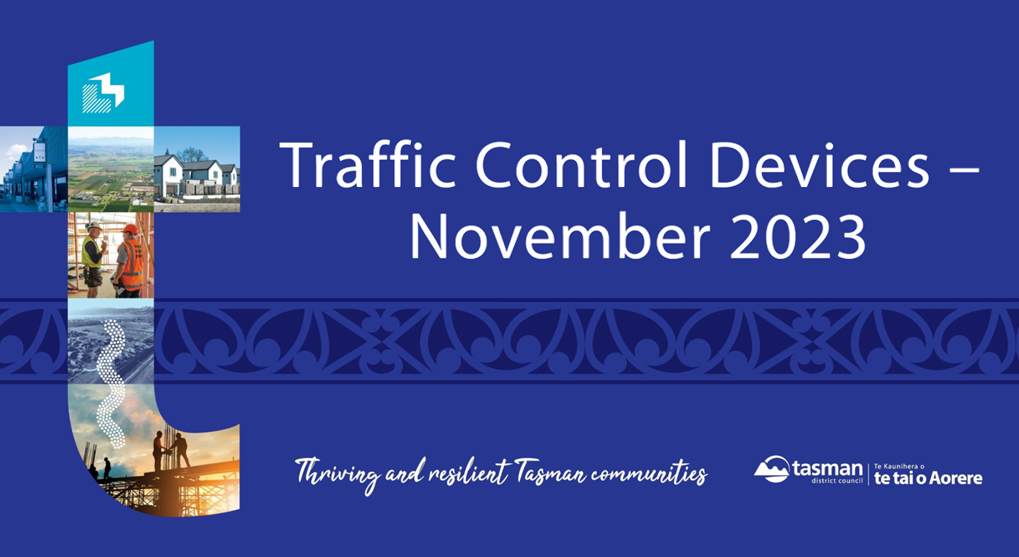
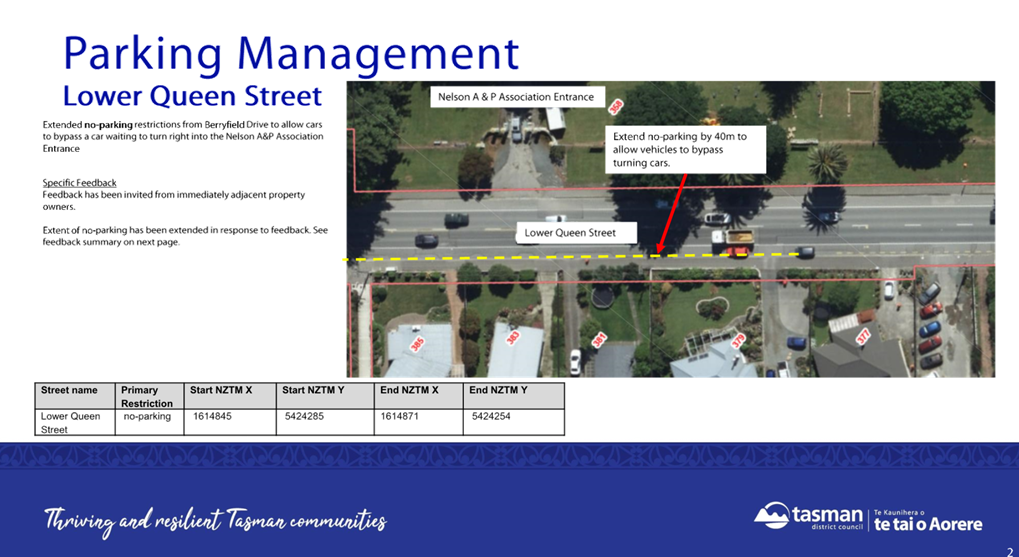
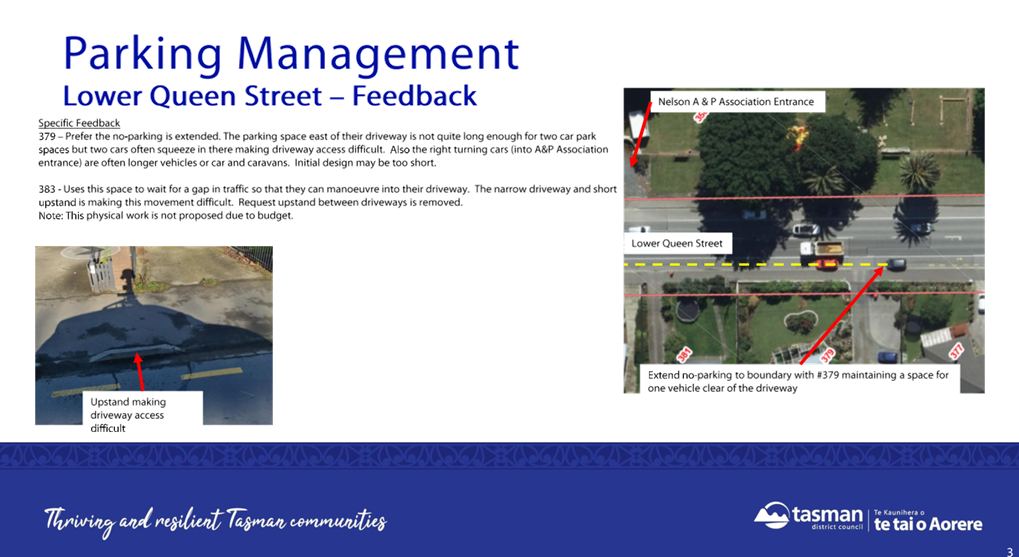
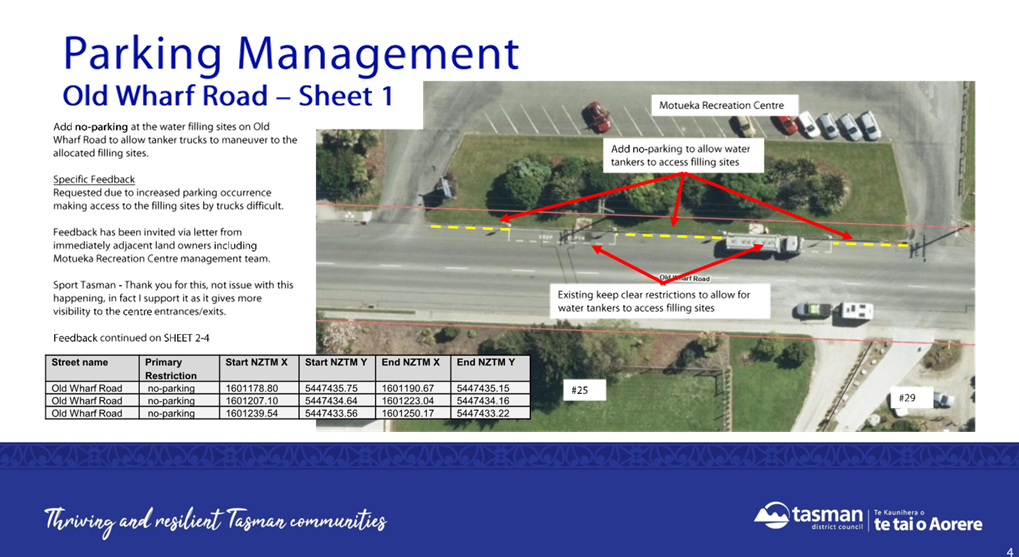

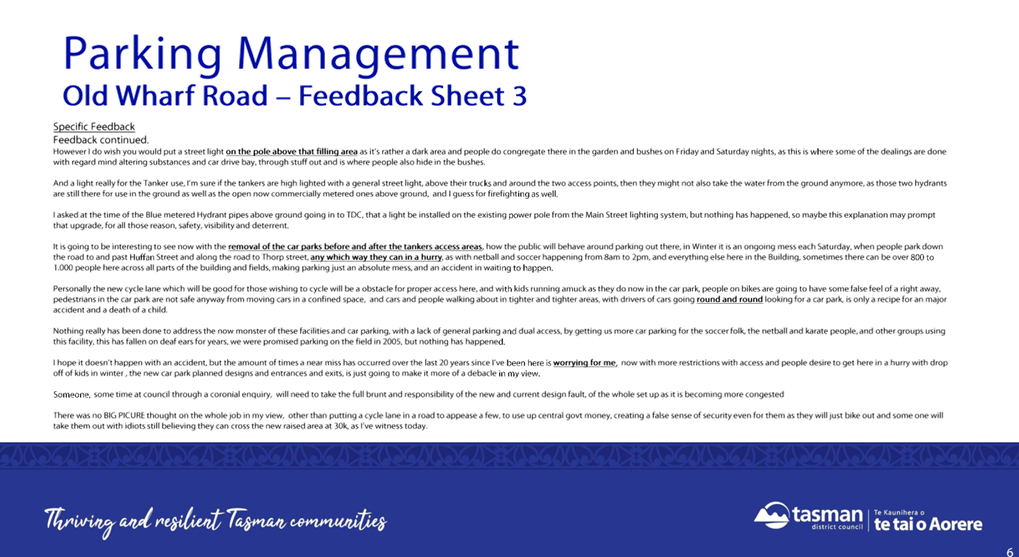
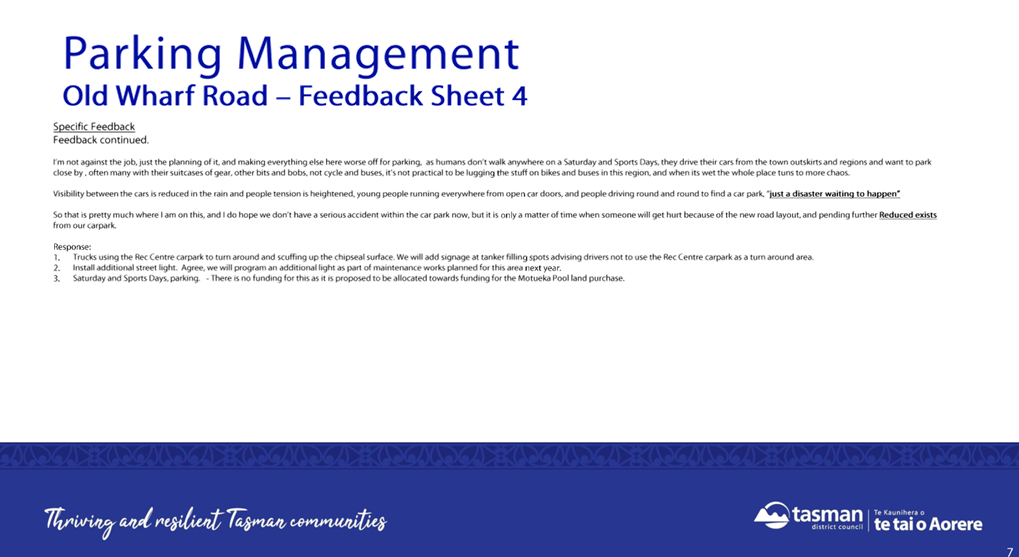
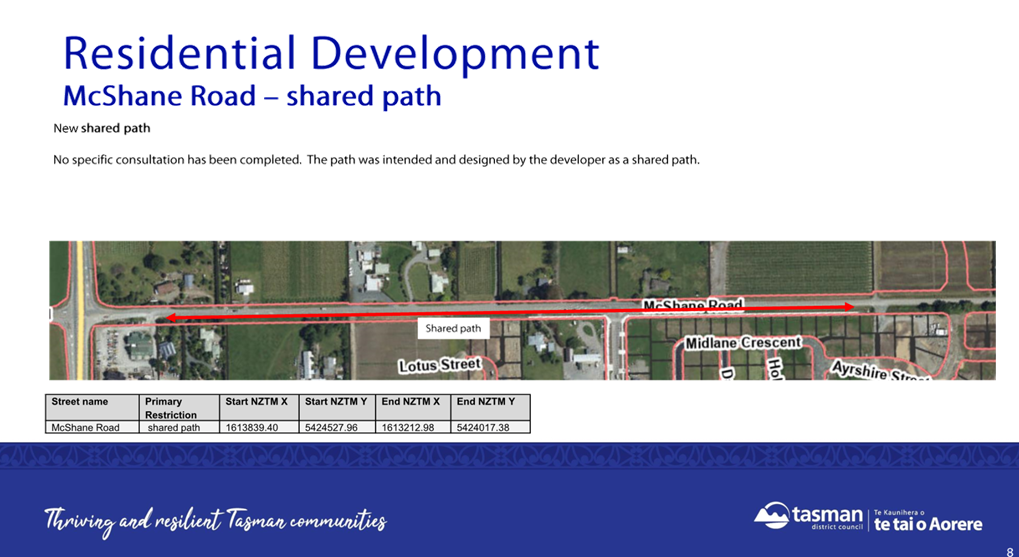
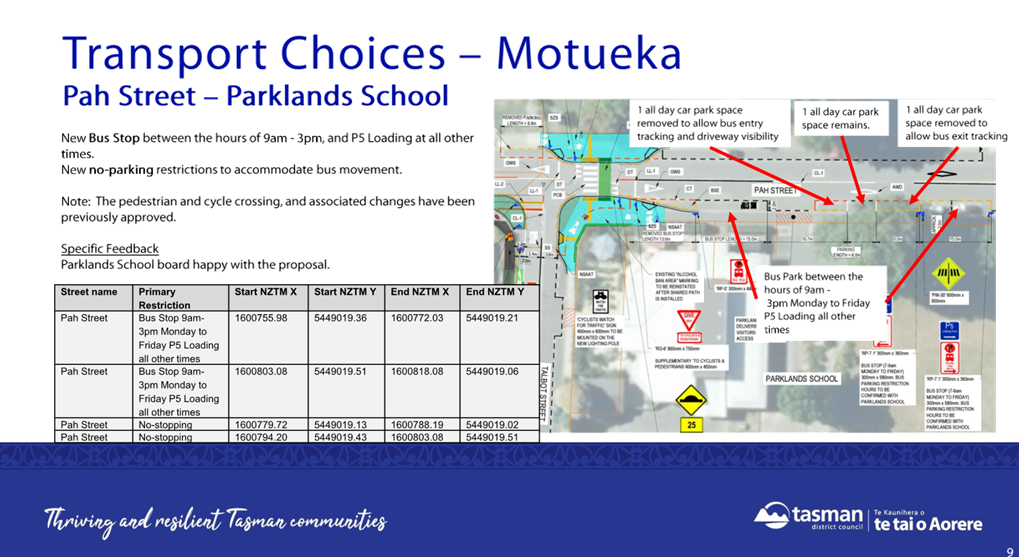
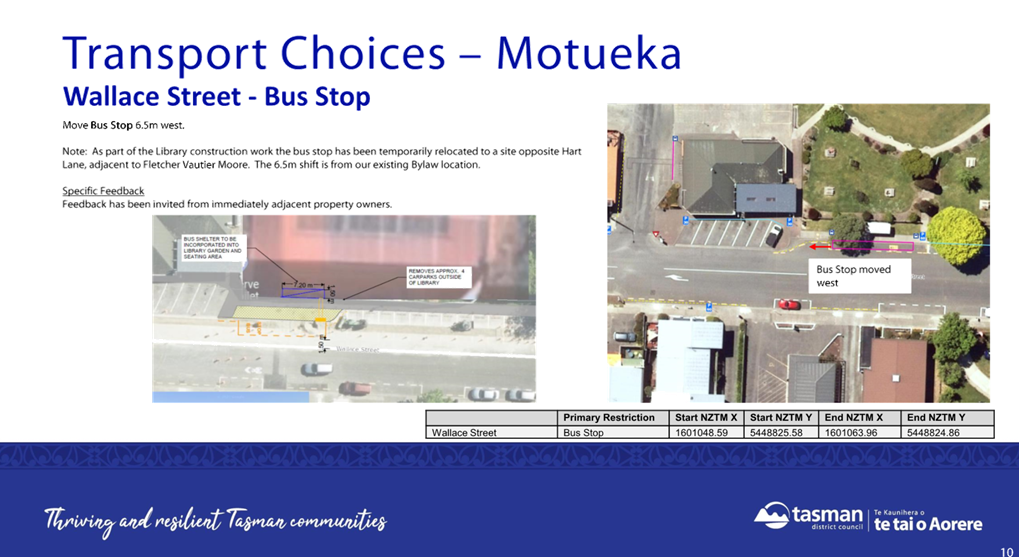

Tasman District Council Agenda – 13 December 2023

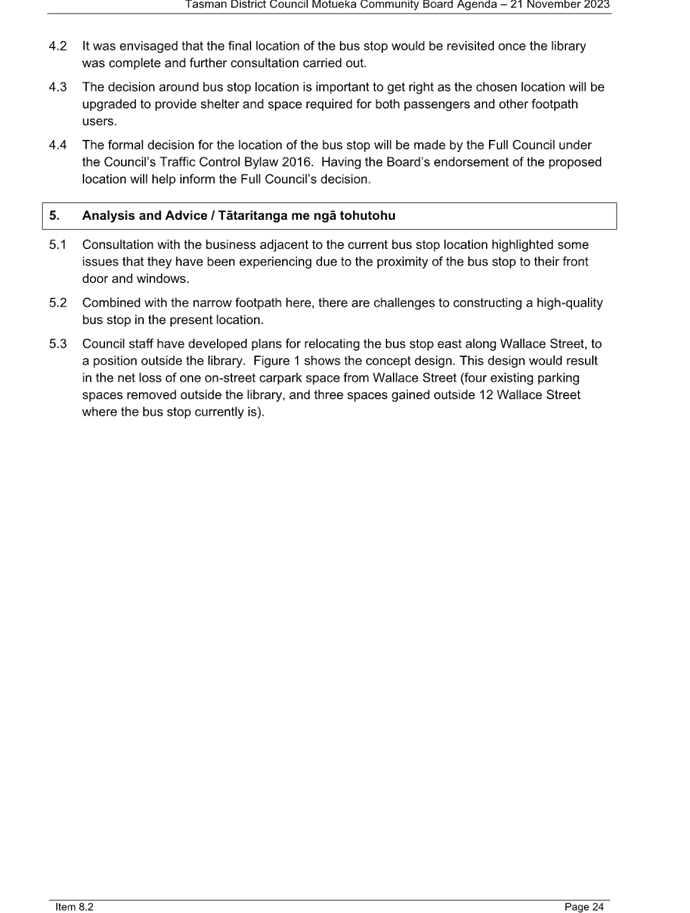
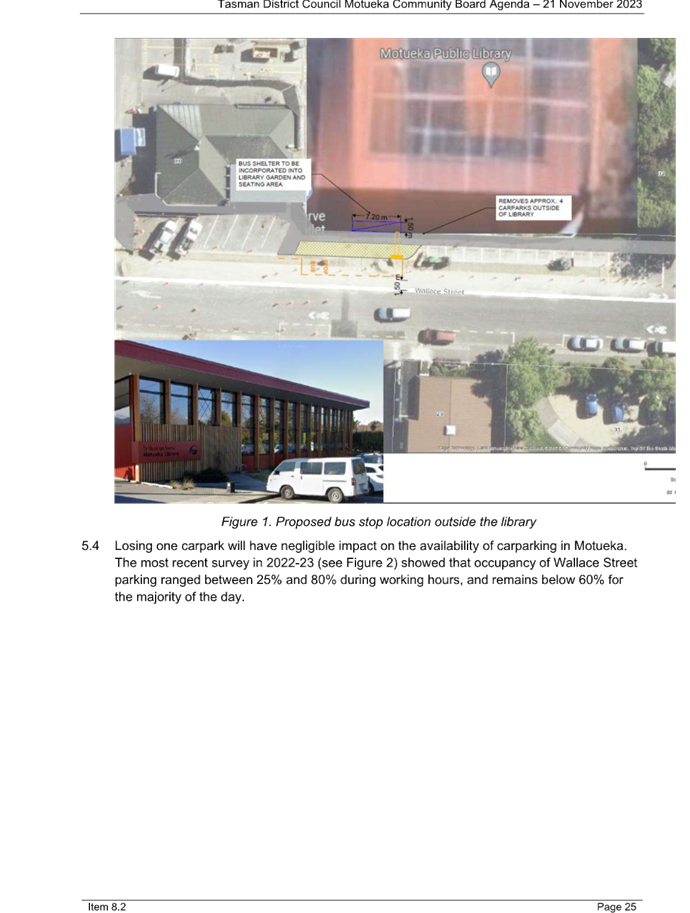
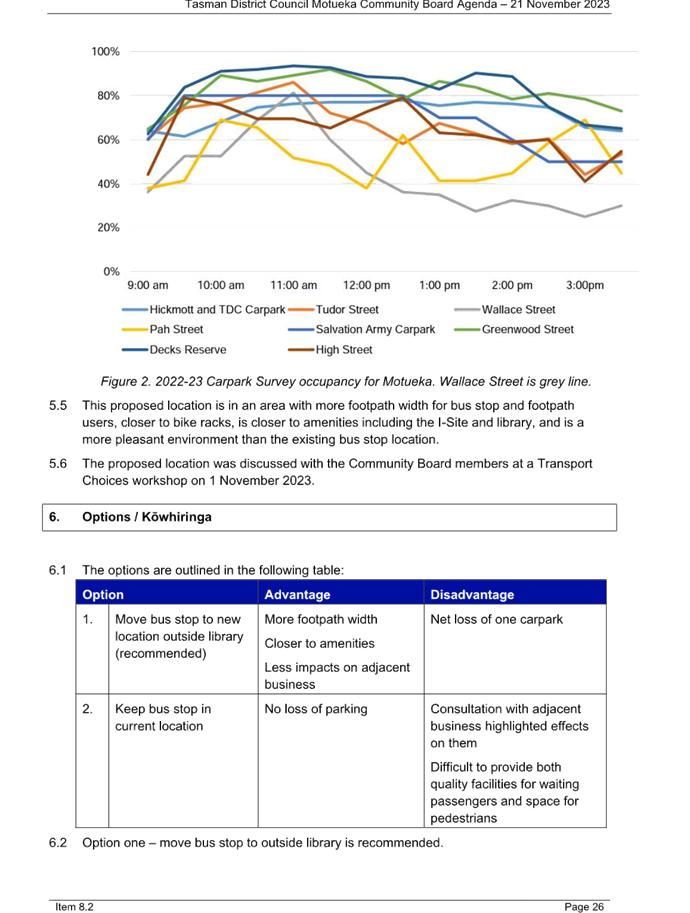

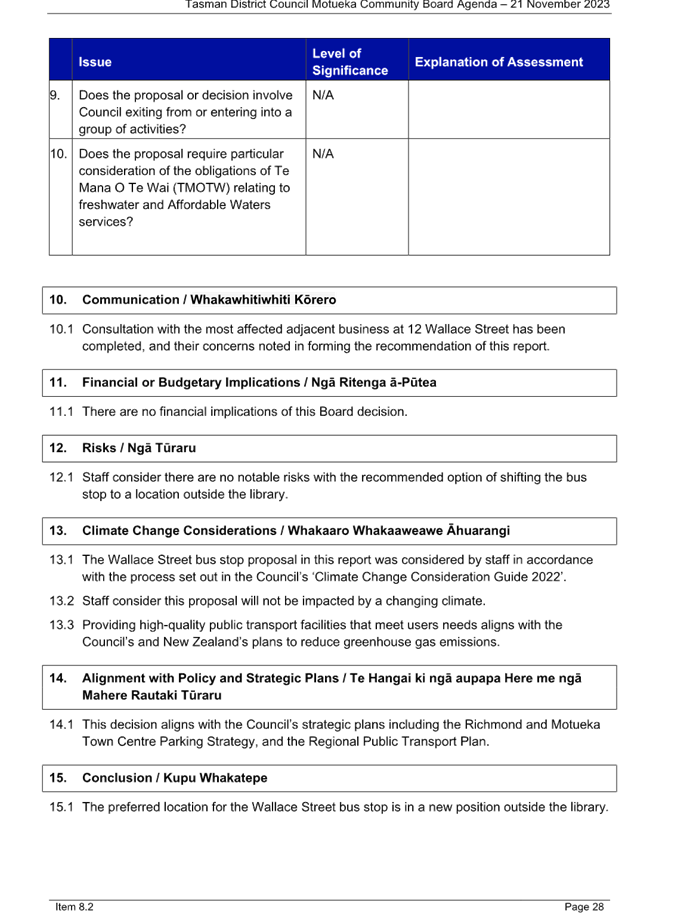

Tasman District Council Agenda – 13 December 2023
7.16 Amendments to the Delegation Register - Finance Roles
Decision Required
|
Report
To:
|
Tasman
District Council
|
|
Meeting
Date:
|
13
December 2023
|
|
Report
Author:
|
Mike
Drummond, Group Manager - Finance
|
|
Report
Authorisers:
|
Leonie
Rae, Chief Operating Officer
|
|
Report
Number:
|
RCN23-12-22
|
1. Purpose
of the Report / Te Take mō te Pūrongo
1.1 To
make amendments to the Tasman District Council Delegations Register to ensure
that the new or amended positions arising from the Finance Department
re-organisation with new position titles, are updated in the Delegations
Register, giving staff powers to act in accordance with legislative
requirements and reflecting revised roles and responsibilities.
2. Summary
/ Te Tuhinga Whakarāpoto
2.1 As
part of a review of the Finance Department several roles were revised and
renamed. The proposed amendments ensure that the changes in the role names are
reflected in the delegations register.
2.2 This
is a mainly a minor routine matter required to keep the Delegations Register up
to date with role title changes, noting that only the Council can delegate
powers under the Local Government (Rating) act 2002.
3. Recommendation/s
/ Ngā Tūtohunga
That the Tasman
District Council
1. receives
the Amendments to the Delegation Register - Finance Roles report RCN23-12-22;
and
2. notes that due to a review of the Finance
team, there are changes to four positions
and titles as set out below, effective from 4 December 2023, and pursuant to the Local Government Act 2002 and the
Local Government (Rating) Act 2002, delegates to the four new managers the same
powers, functions and duties held by them in their previous positions as noted
below:
· Senior
Management Accountant to Management Accounting Manager
· Senior
Financial Accountant to Financial Accounting Manager
· Senior Revenue
Accountant to Revenue Manager
· Finance Manager
to Financial Performance Manager; and
3. notes
that there are further changes proposed on 1 July 2024 to the Group Manager
Finance role and any changes required to delegations will be the subject of a
further report; and
4. notes
that the Delegations Register will be updated to reflect these changes.
4.1 The recent reorganisation of the Finance
Department has been completed with the following changes effective from 4
December 2023:
4.1.1 A Chief Financial Officer (CFO)
role will be introduced from 1 July 2024, and this role will replace the
existing Group Manager – Finance role. Any decision on an appointment for
this role will be delayed, allowing the new Chief Executive to be influential
in the appointment. The appointment process is expected to begin by March 2024.
4.1.2 There is a new Finance
Leadership team leading four teams within the Finance Group with the senior
leaders (3rd tier managers) confirmed and reporting to Mike Drummond as Group
Manager Finance until a CFO appointment is made:
4.1.2.1 Financial Performance led by Matt McGlinchy
4.1.2.2 Financial Accounting led by Charlotte Thomas
4.1.2.3 Revenue led by Margie French
4.1.2.4 Management Accounting led by Paul Egan
4.2 The Delegations Register are required to
give effect to the Finance Department’s reorganisation to ensure the
Register reflects the new structure and role titles.
5. Analysis
and Advice / Tātaritanga me ngā tohutohu
5.1 Staff recommend that the proposed
minor amendments are made to the current delegations.
6.1 The options are outlined in the
following table:
|
Option
|
Advantage
|
Disadvantage
|
|
1.
|
Approve the proposed amendments to
delegations.
|
Ensures that there are clear and specific
delegations relating to the correct roles within the Finance Department.
|
None.
|
|
2.
|
Do not approve the proposed amendments to
delegations.
|
No changes required to the Delegations
Register.
|
Does not ensure that there are clear and
specific delegations relating to the documents and processes within the
Finance Department.
Increases risk to the Council of
challenges to the validity of documents and/or the Council processes.
|
6.2 Option one is recommended.
7.1 Clause 48 Schedule 7 of the Local
Government Act 2002 provides for the Council to delegate certain powers and
functions to the Chief Executive Officer and staff, excluding certain powers
which only the Council can delegate such as those under the Local Government
(Rating) act 2002.
8. Iwi
Engagement / Whakawhitiwhiti ā-Hapori Māori
8.1 No engagement with iwi has been
undertaken, the proposed amendments are of a minor operational nature.
9. Significance
and Engagement / Hiranga me te Whakawhitiwhiti ā-Hapori Whānui
|
|
Issue
|
Level of
Significance
|
Explanation of
Assessment
|
|
1.
|
Is there a high level
of public interest, or is decision likely to be controversial?
|
Low
|
|
|
2.
|
Are there impacts on
the social, economic, environmental or cultural aspects of well-being of the
community in the present or future?
|
Low
|
|
|
3.
|
Is there a
significant impact arising from duration of the effects from the decision?
|
Low
|
The amendments
address potential rather than actual risks.
|
|
4.
|
Does the decision
relate to a strategic asset? (refer Significance and Engagement Policy for
list of strategic assets)
|
No
|
|
|
5.
|
Does the decision
create a substantial change in the level of service provided by Council?
|
No
|
|
|
6.
|
Does the proposal,
activity or decision substantially affect debt, rates or Council finances in
any one year or more of the LTP?
|
No
|
|
|
7.
|
Does the decision
involve the sale of a substantial proportion or controlling interest in a CCO
or CCTO?
|
No
|
|
|
8.
|
Does the proposal or
decision involve entry into a private sector partnership or contract to carry
out the deliver on any Council group of activities?
|
No
|
|
|
9.
|
Does the proposal or
decision involve Council exiting from or entering into a group of
activities?
|
No
|
|
|
10.
|
Does the proposal
require particular consideration of the obligations of Te Mana O Te Wai
(TMOTW) relating to freshwater and Affordable Waters services?
|
No
|
|
10. Communication
/ Whakawhitiwhiti Kōrero
10.1 The proposed amendments to the delegations will be
communicated internally to the staff.
11. Financial
or Budgetary Implications / Ngā Ritenga ā-Pūtea
11.1 Only staff time is involved to amend the
Delegations Register.
12.1 The proposed amendments to the delegations will
ensure clear and specific delegations are in place.
13. Climate
Change Considerations / Whakaaro
Whakaaweawe Āhuarangi
13.1 There are no climate change considerations arising
from the amendments to the delegations.
14. Alignment
with Policy and Strategic Plans / Te Hangai ki ngā aupapa Here me ngā
Mahere Rautaki Tūraru
14.1 The Delegations Register includes the
Council’s policy in relation to delegations.
15. Conclusion
/ Kupu Whakatepe
15.1 Staff recommend that the proposed amendments to the
delegations be approved.
16. Next
Steps and Timeline / Ngā Mahi Whai Ake
16.1 If the Council approves the amendments to the delegations, the
amendments take immediate effect, and the Delegations Register will be updated
accordingly.
Nil
Tasman District
Council
Agenda – 13 December 2023
7.17 Waimea Water Limited - Quarterly Report to Shareholders
Information Only - No Decision
Required
|
Report
To:
|
Tasman
District Council
|
|
Meeting
Date:
|
13
December 2023
|
|
Report
Author:
|
Mike
Drummond, Group Manager - Finance
|
|
Report
Authorisers:
|
Leonie
Rae, Chief Operating Officer
|
|
Report
Number:
|
RCN23-12-23
|
1. Summary
/ Te Tuhinga Whakarāpoto
1.1 The
Waimea Water Ltd Quarterly Report to shareholders was delivered on 23 November
2023. The Quarterly Report is attached as (Attachment 1).
1.2 Waimea
Water Ltd have advised shareholders that the Quarterly Report has been
published on their website.
2. Recommendation/s
/ Ngā Tūtohunga
That the Tasman District Council
1. receives the Waimea Water Limited - Quarterly Report to Shareholders
report,
RCN23-12-23; and
2. notes the
receipt of the Quarterly Report for the period ended 30 September 2023 from
Waimea Water Ltd; and
3. notes the
remaining identified residual risks through to project completion; and
4. notes the
Waimea Water Limited Quarterly Report (or a link to the report) will be
published on the Council’s website within seven (7) days of this meeting.
3.1 To
formally receive the Waimea Water Ltd Quarterly Report for the period ended
30 September 2023.
4. Background and Discussion
4.1 The
Company is required under the terms of its Statement of Intent to provide a
quarterly report to shareholders. These reports are also made available to the
public via both the Council and the Waimea Water Ltd websites.
4.2 The
report provides information regarding:
· Health, safety and wellbeing performance;
· Update on construction progress;
· Update on operational readiness;
· Update on public affairs activities;
· Update on expected cost and risk;
· Statement of comprehensive revenue and expense, disclosing actual
and comparative figures;
· Statement of financial position at the end of the period;
· Statement of cashflows; and
· A commentary on the results for the period.
4.3 The
dam construction progress is set out on Section 3 (page 5) and costs and risks
in Section 9 (page 14). The estimated cost to complete remains at $198.2
million as forecast in February 2023. As at the end of the period, 30
September, WWL has spent $180.2 million of the forecast cost of $198.2 million.
The construction is now 95% complete.
4.4 WWL
is preparing for dam operations in early 2024, following replacement of the
temporary facilities and commissioning of the permanent facilities.
4.5 The
report identified key significant residual risks, not valued:
· Commercial
risks associated with an unexpected outcome from the Contractor-initiated
arbitration that is contrary to the decisions of the engineer and
adjudication. WWL continues to prepare for arbitration.
· Continued
dry weather delaying filling of the reservoir and, therefore, subsequent
completion of the project and availability of service.
· Greater
embankment settlement than expected could put the dam face mechanical systems
out of alignment. Greater seepage than expected may also require post
construction intervention. In such eventualities, WWL would plan to lower the
reservoir after the 2023/2024 summer season and address any issues.
5.1 The
Company has provided the required quarterly update. The information in the
update is in line with the presentation made to the Council in November
2023.
6.1 Staff
will provide a link to the report on the Council’s website within seven
days of this meeting.
|
1.⇩
|
Waimea
Water Limited Quarterly Report - September 2023
|
205
|
Tasman District
Council
Agenda – 13 December 2023

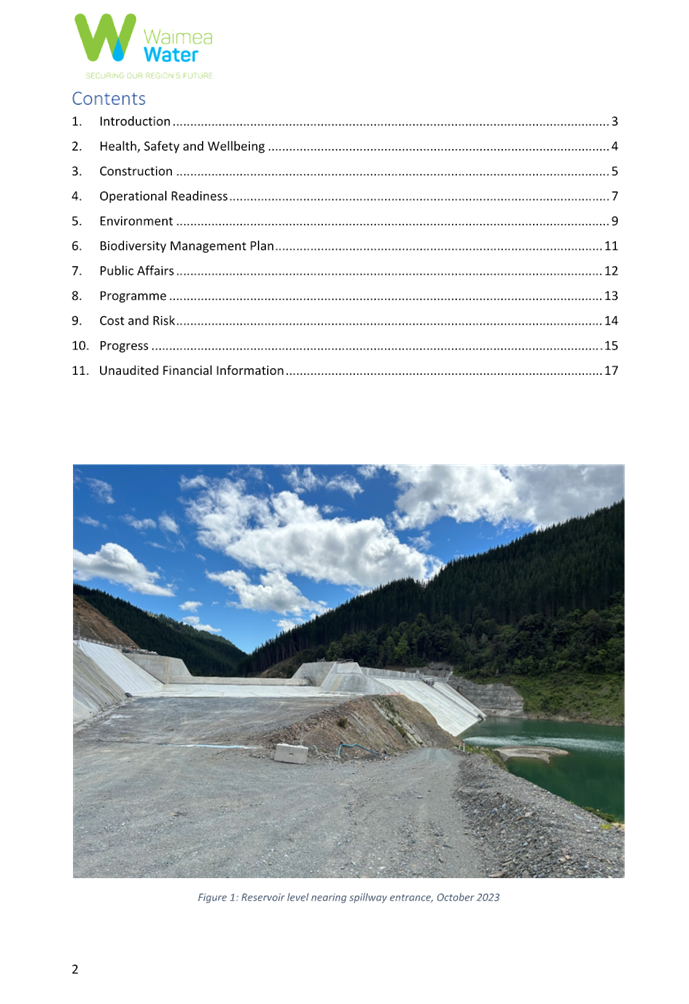
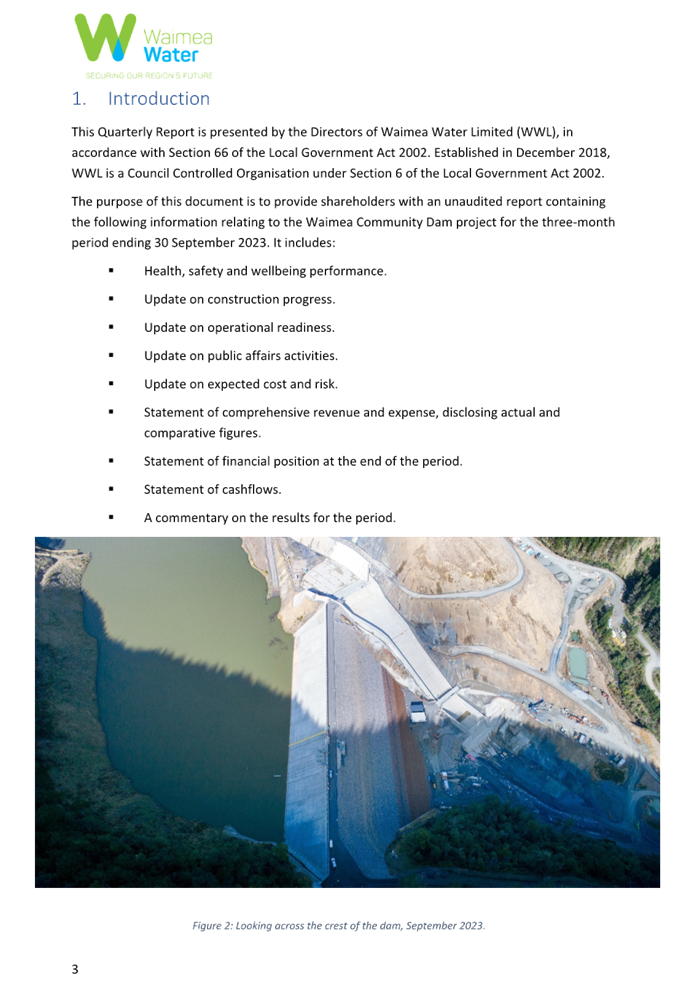
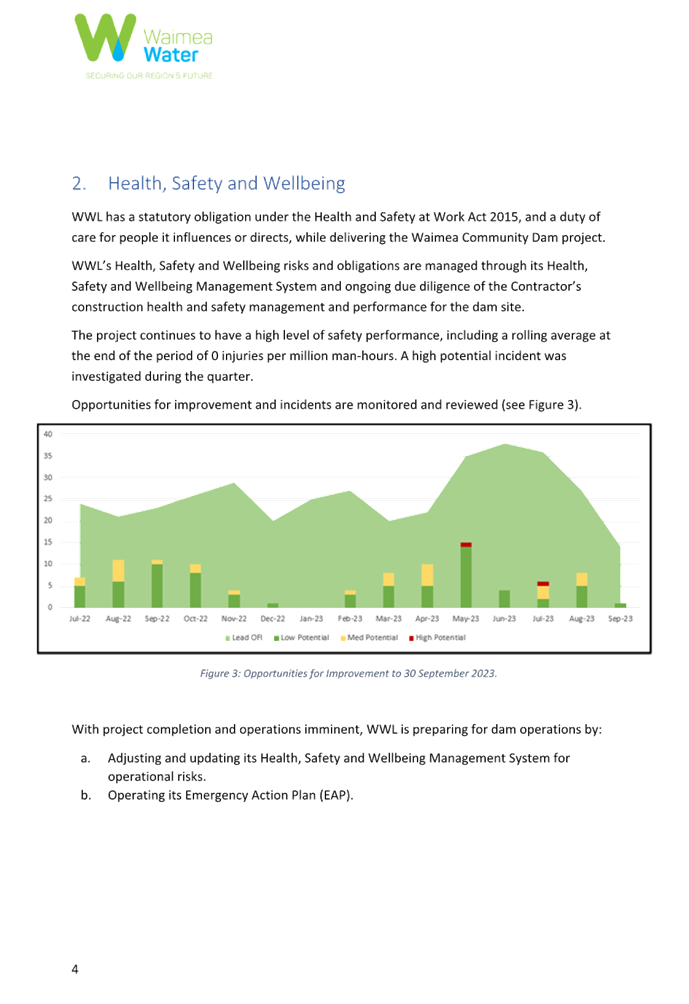
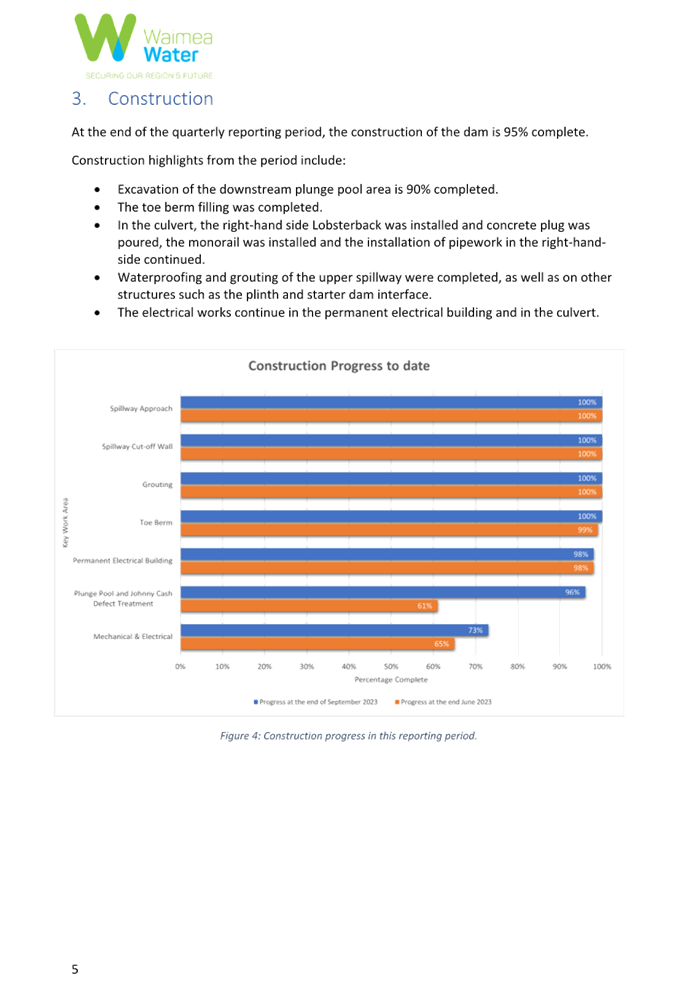
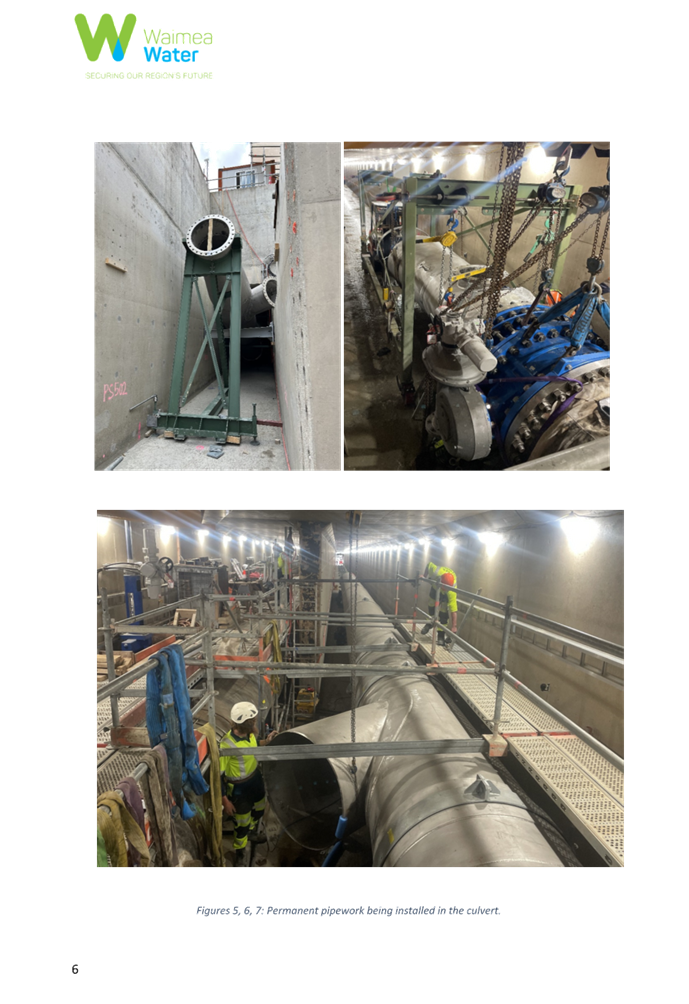
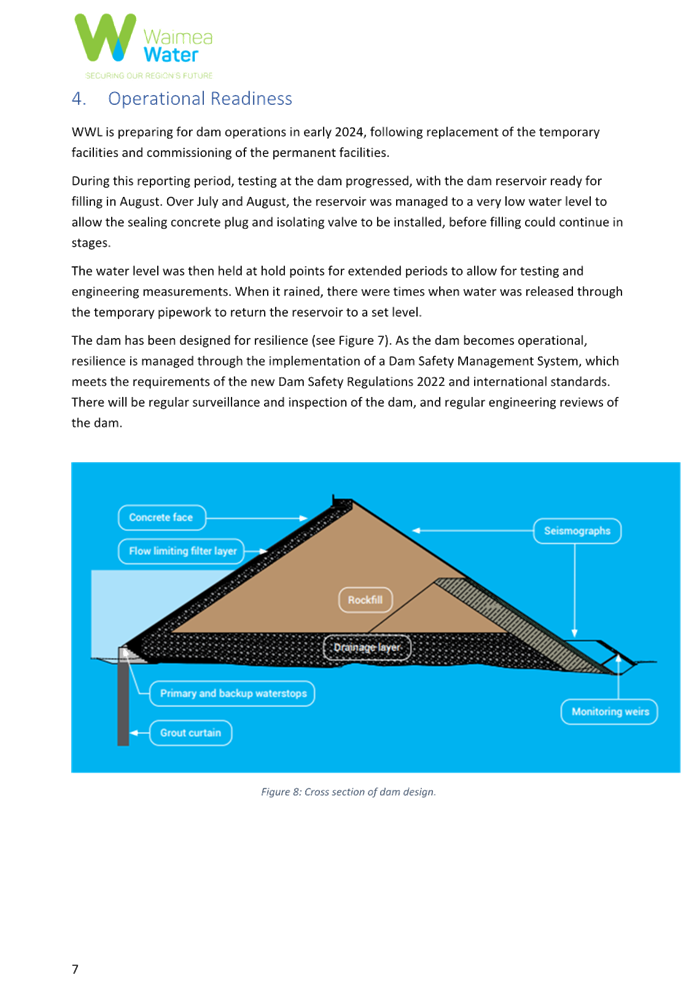

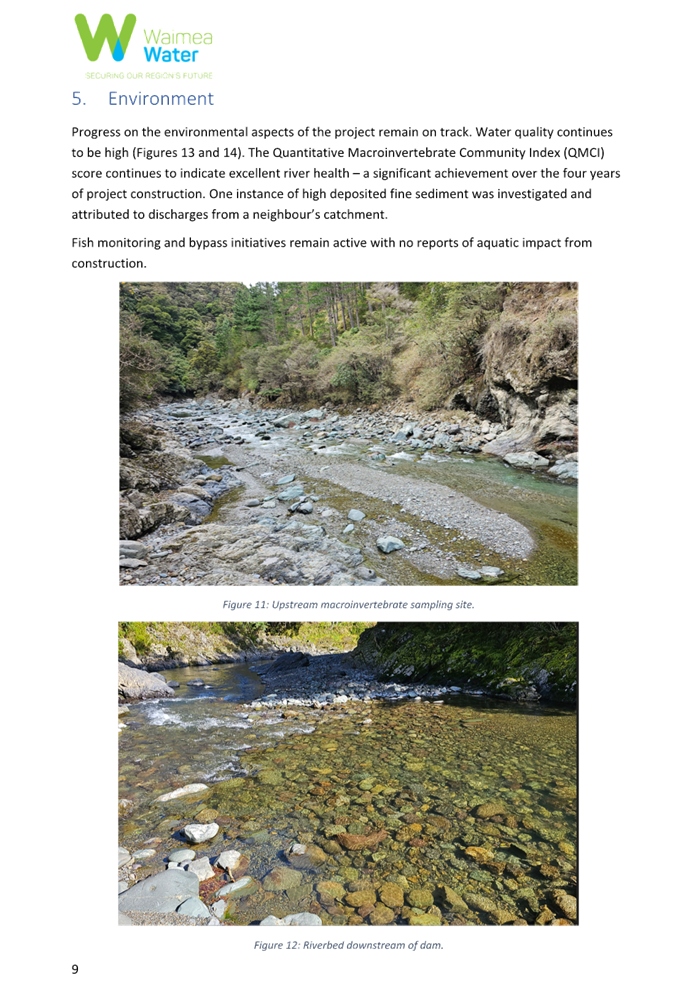
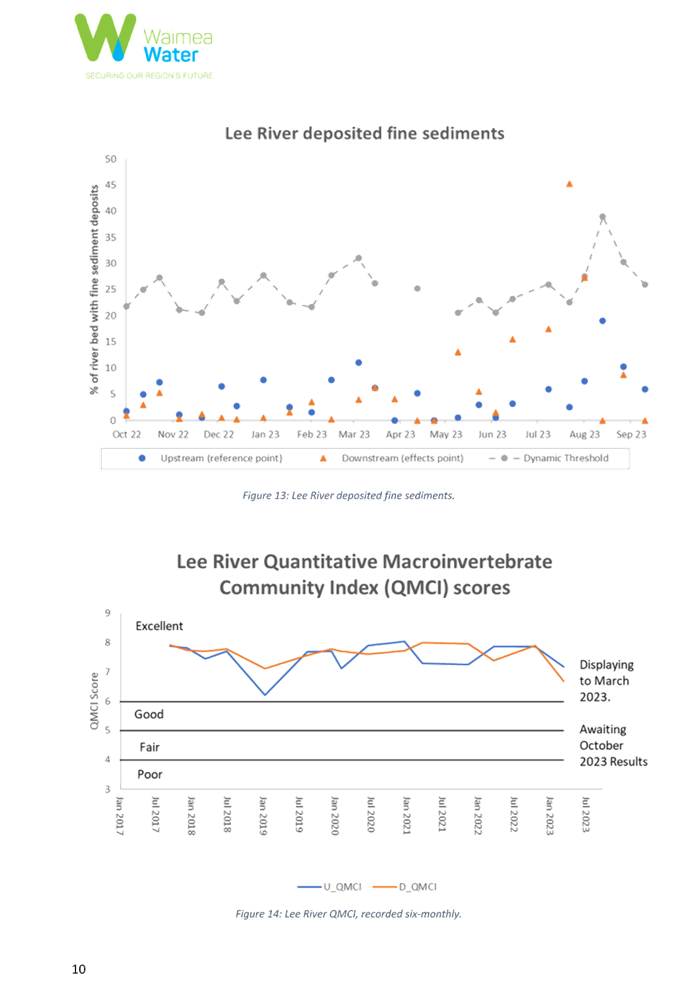
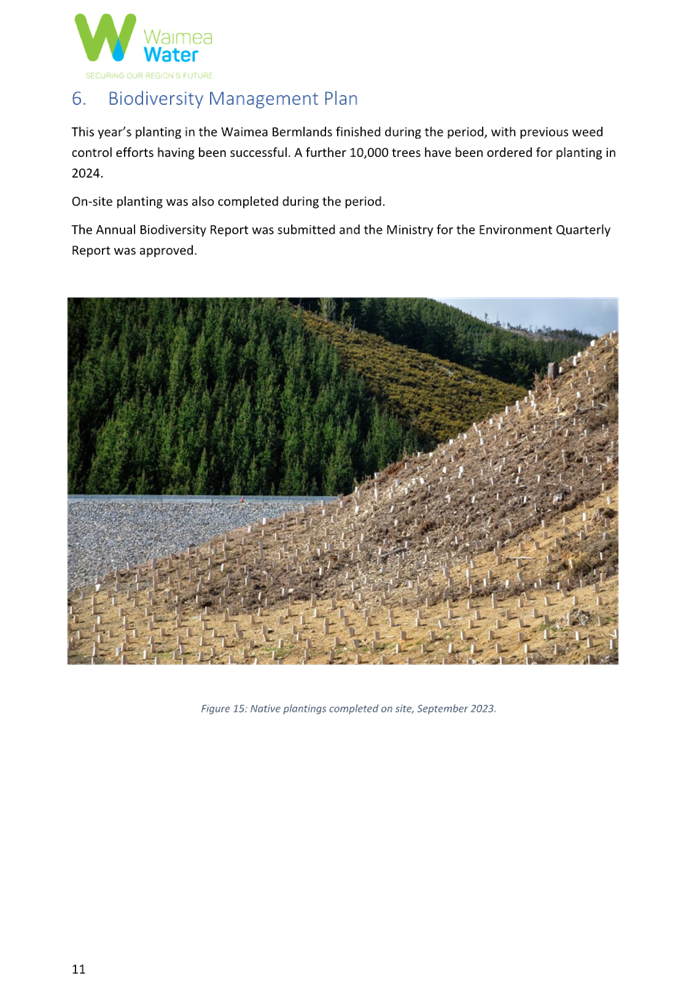
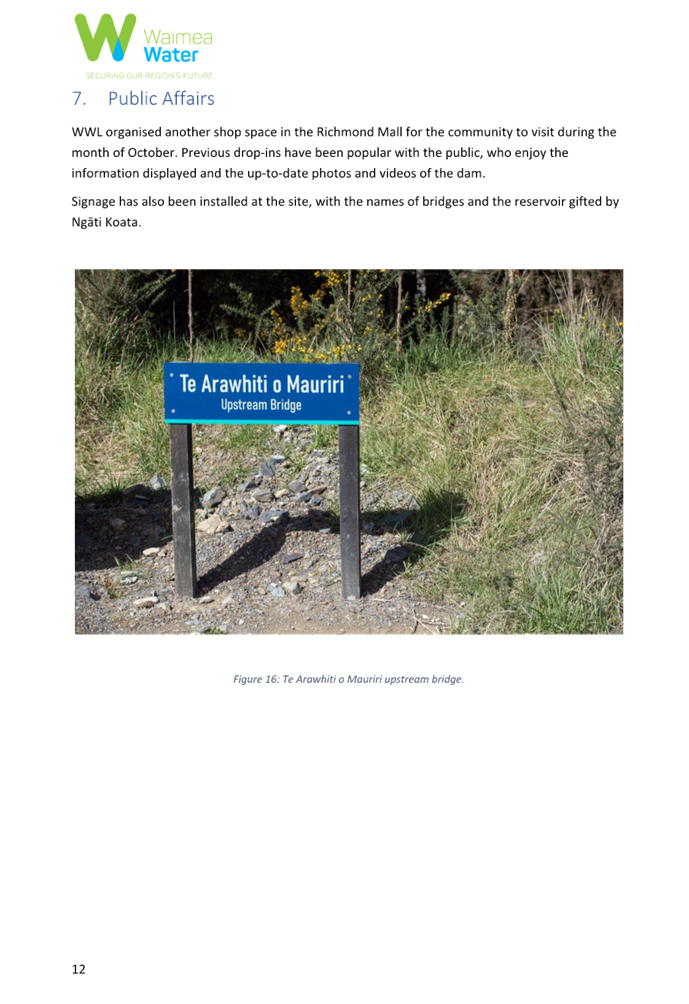
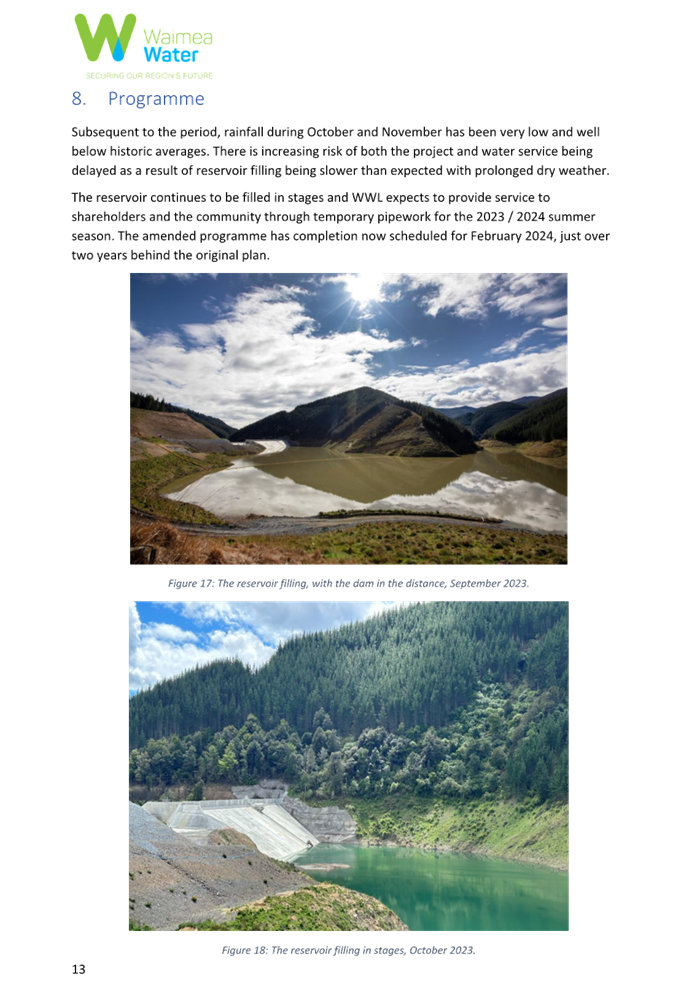

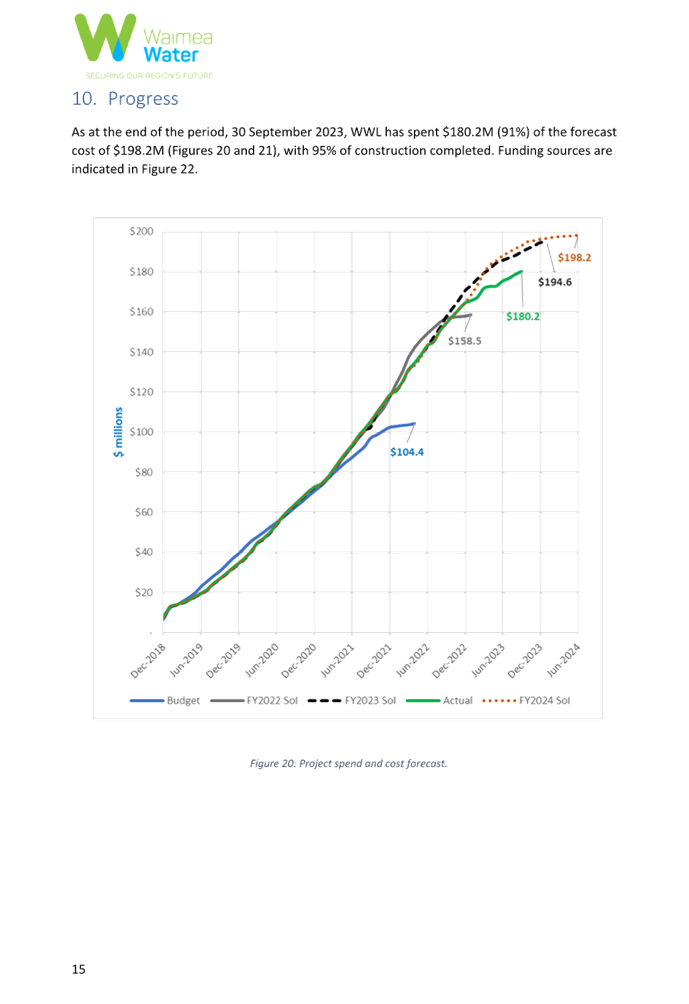
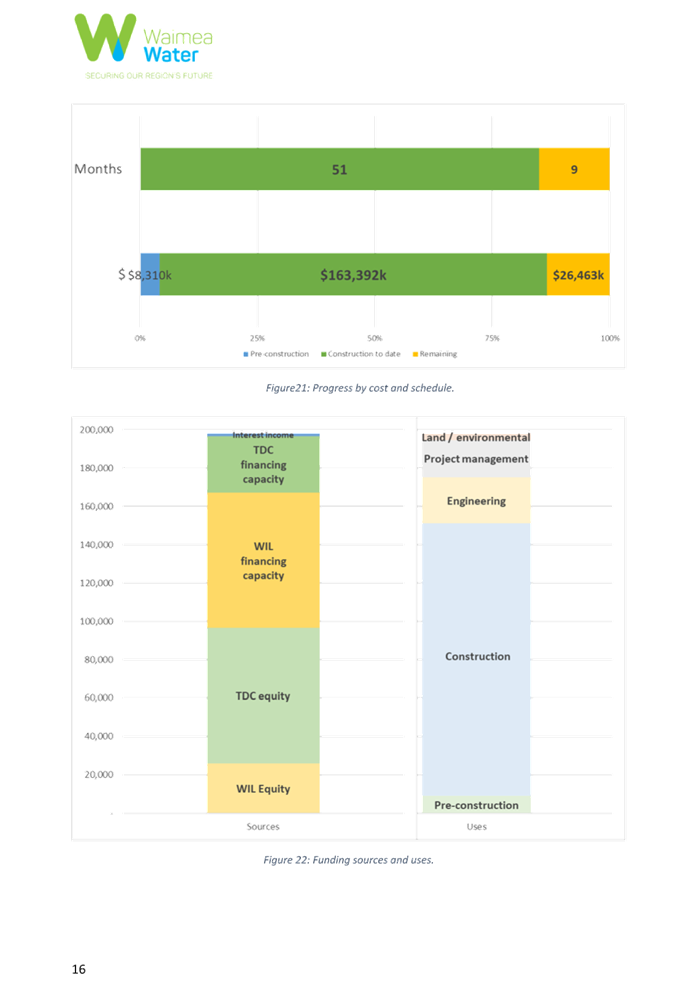

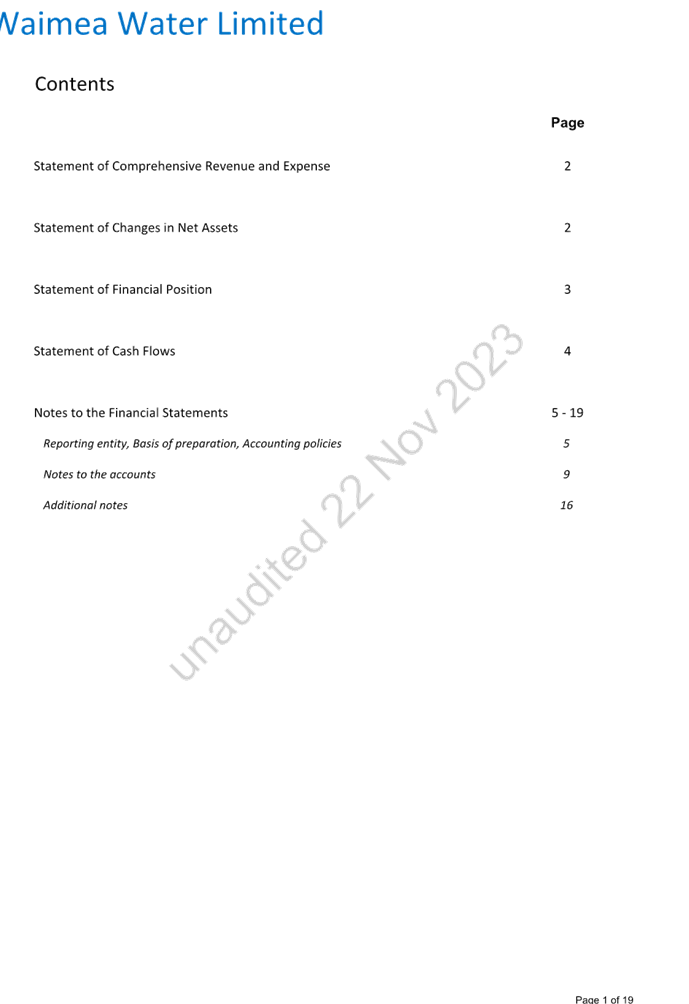
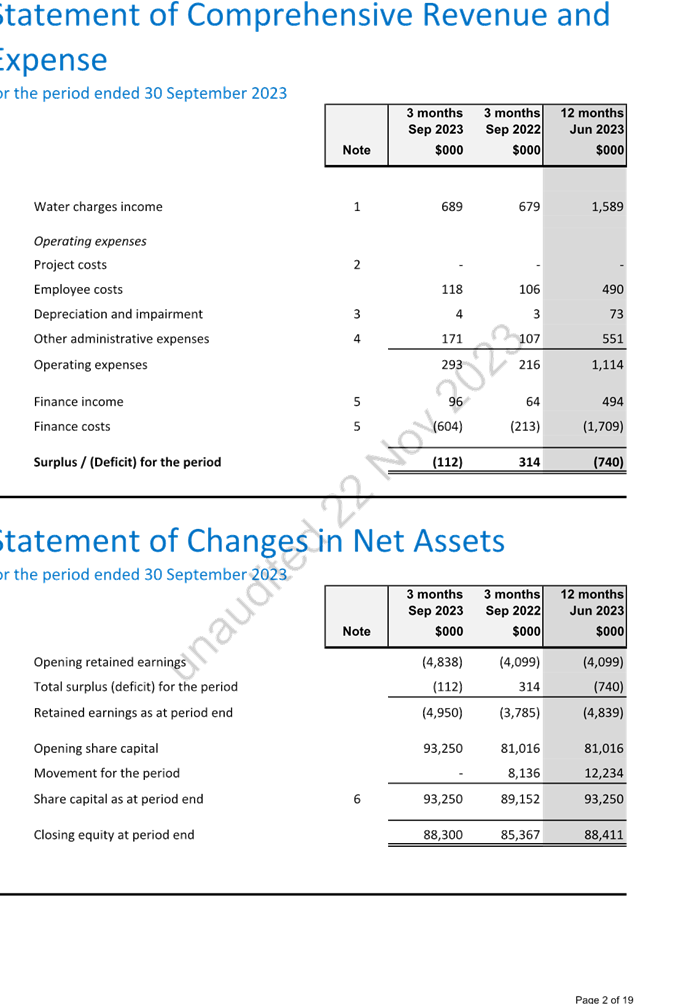
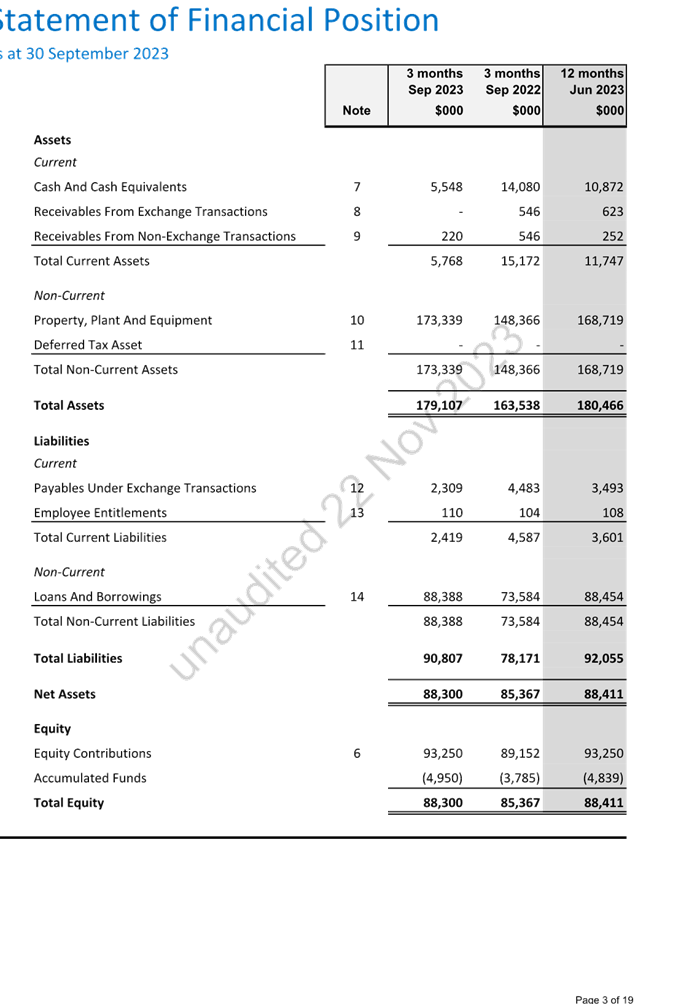
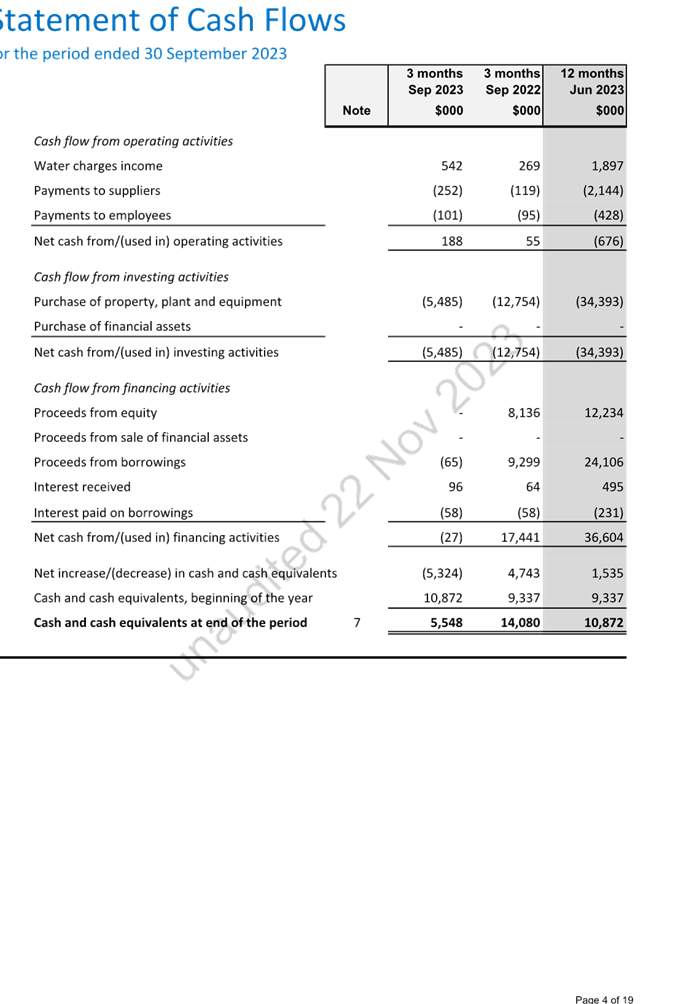
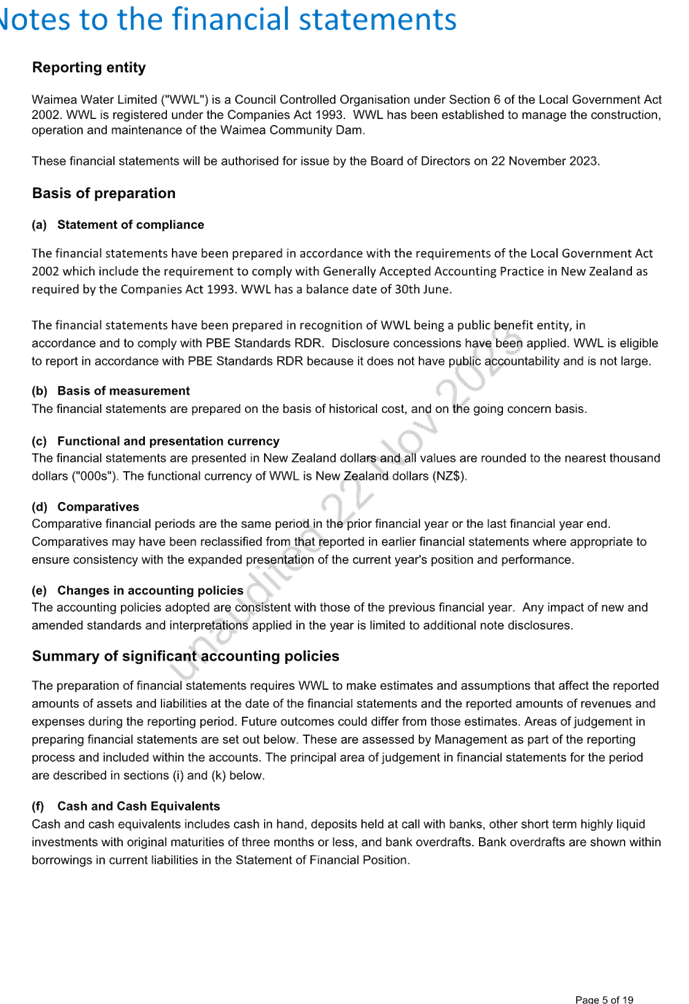
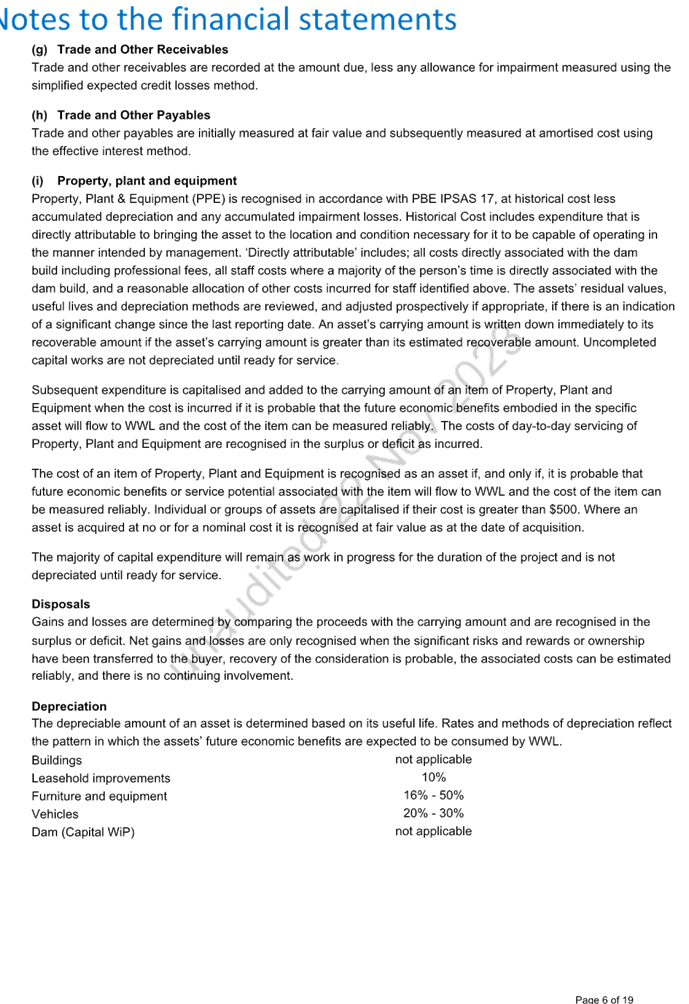
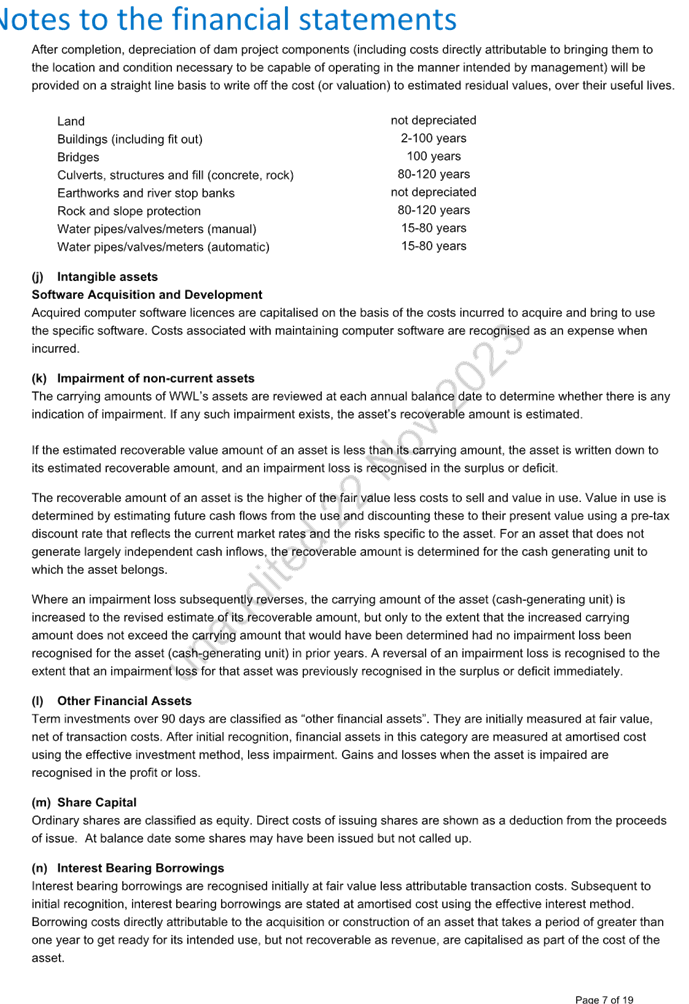
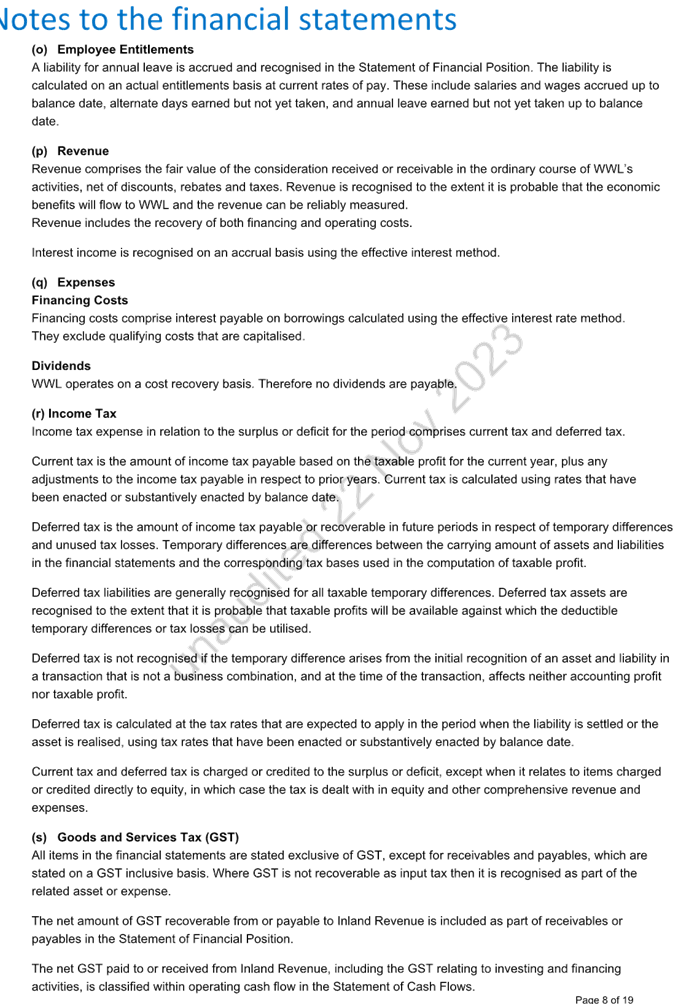
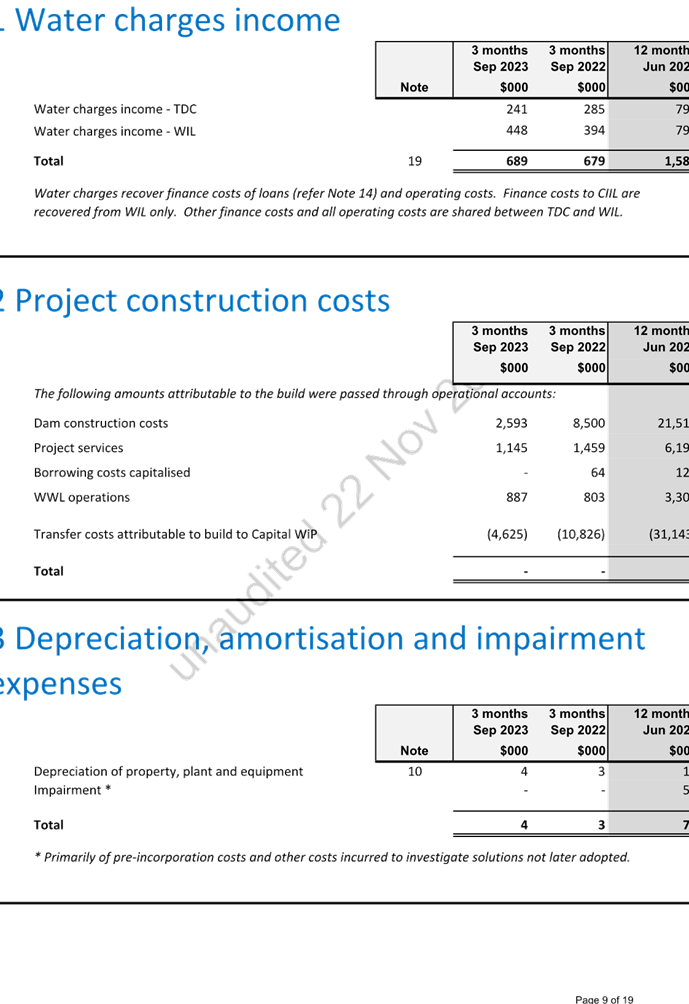
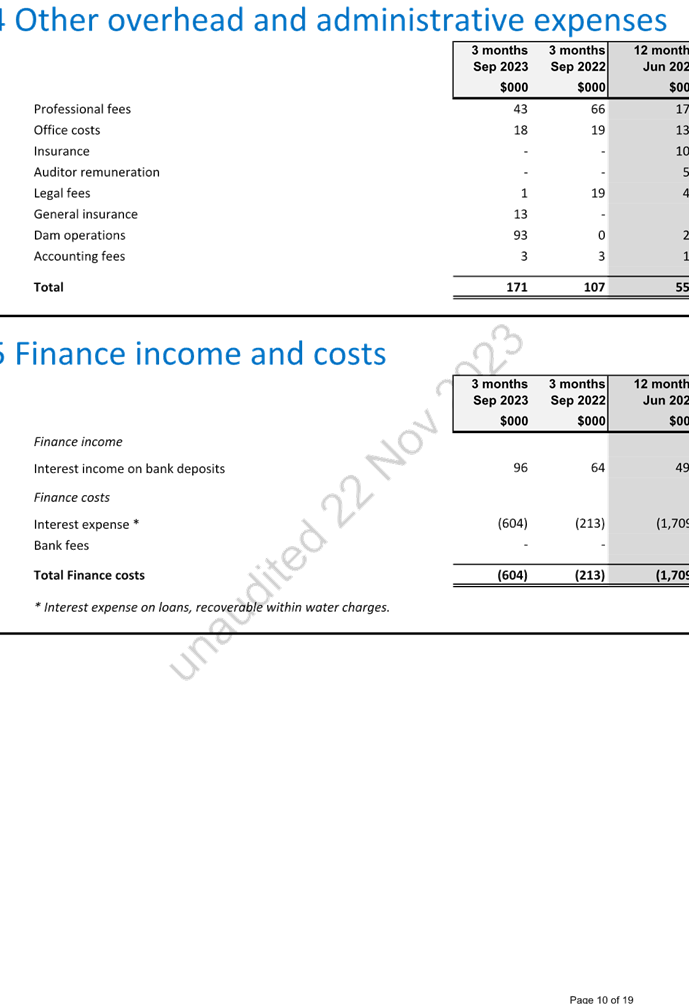
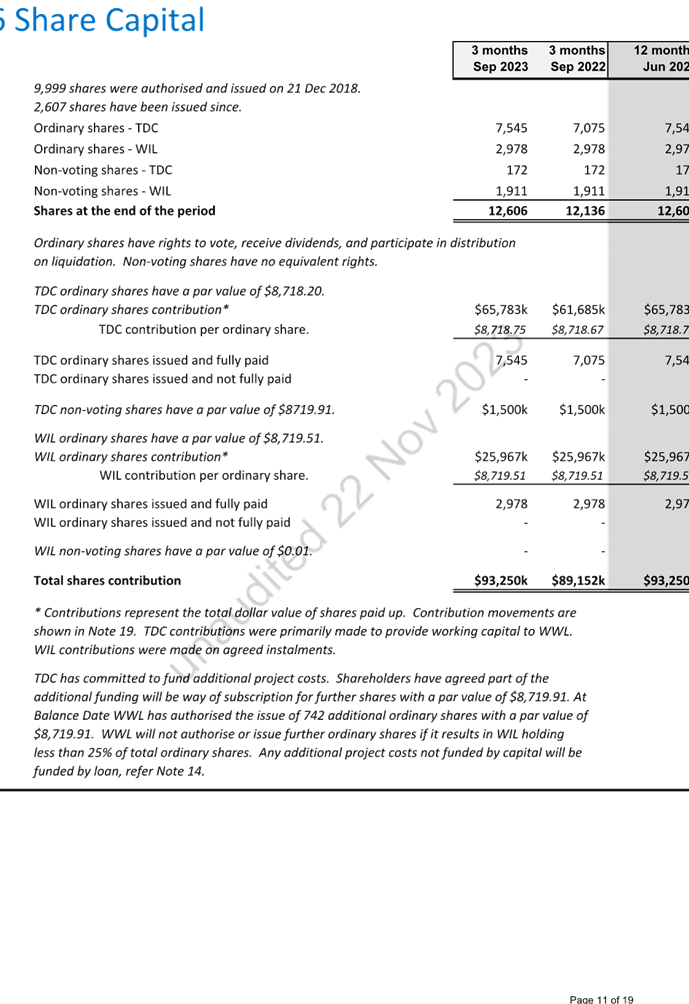
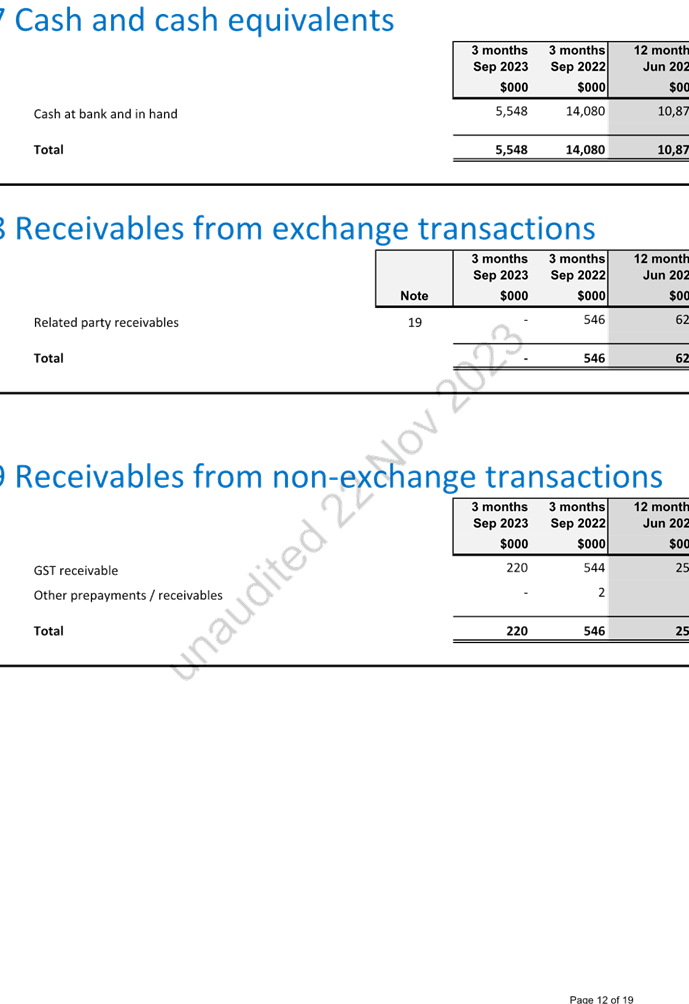

Tasman District Council Agenda – 13 December 2023
7.18 Machinery Resolutions Report
|
Report
To:
|
Tasman
District Council
|
|
Meeting
Date:
|
13
December 2023
|
|
Report
Author:
|
Alexis
Brough, Executive Support Officer, Chief Executive's Office
|
|
Report
Authorisers:
|
|
|
Report
Number:
|
RCN23-12-24
|
1. Summary
/ Te Tuhinga Whakarāpoto
1.1 The
execution of the following documents under the Council Seal requires
confirmation by the Council.
2. Recommendation/s
/ Ngā Tūtohunga
That the Tasman District Council
1. receives the Machinery Resolutions report, RCN23-12-24 and that the execution of the
following documents under the Seal of the Council be confirmed:
Māpua Boat Ramp Community Trust
Deed of Funding – The Deed of Funding to be entered into between the
Council and the Māpua Boat Ramp Community Trust.
Appleby Fresh
Limited Variation of Lease – This Variation of lease grants a term of
three months for growing horticultural crops on part of the Waimea River Berm
land 53307L2. The lease is a standard document originally drafted by Fletcher
Vautier and Moore.
Deed of Lease
Property Number 41000L6 Port Motueka – This Deed of Lease is a commercial
lease that takes the MPBC contributions to the community into account. A
10-year term has been negotiated. There will be a CPI increase in lease rentals
every three years.
Tasman District
Council
Agenda – 13 December 2023
7.19 Chief Executive's Update
Information Only - No Decision
Required
|
Report
To:
|
Tasman
District Council
|
|
Meeting
Date:
|
13
December 2023
|
|
Report
Author:
|
Janine
Dowding, Chief Executive Officer
|
|
Report
Authorisers:
|
Leonie
Rae, Chief Operating Officer
|
|
Report
Number:
|
RCN23-12-25
|
1. Summary
/ Te Tuhinga Whakarāpoto
1.1 The purpose of
this report is to provide an update on some key activity since the Chief
Executive’s last report on 26 October 2023.
2. Recommendation/s
/ Ngā Tūtohunga
That the Tasman District Council receives the Chief Executive's
Update report,
RCN23-12-25.
3. Health,
Safety and Wellbeing
3.1 Since the last
accident, incident, near miss events were reported at the end of October, there
have been 16 events reported between 26 October-1 December. Any actions that
arose from these events have been completed.
3.2 November’s
‘wellbeing’ focus for staff was on the importance of mental
awareness. As part of wellbeing, 15 teams took part in Move-ember. This was our
version of Step-tember to encourage staff to be more active and connect with
others. Ninety people clocked up over 28 million steps during the month of
November.
3.3 Several staff have received training in
the following areas over the past month or so:
· Situational Awareness Training run by QRisk x 45
· Summer Students – completed Advanced Driver Training
· 4WD training x 4
· Advanced Driver Training x 8
· Driver Awareness (theory) x 34
· Health and Safety Rep x 1
· First Aid x 7
3.4 We
had one false alarm in the Richmond office, which was attended by FENZ.
3.5 First
Aid kits are currently being restocked, which is now done in-house.
4. Legal and Democracy Services
Legislative uncertainty
4.1 The policy announcements from the newly
formed government creates some uncertainty about changes to the legislative
environment which is making future planning difficult. This is particularly the
case in relation to Resource Management reforms, Affordable Waters, and the
Council’s upcoming representation review. Staff are monitoring the policy
announcements and will review any relevant bills introduced to the
house.
Information (LGOIMA) requests
4.2 Figure 1 below provides a monthly
comparison between the 2022 and 2023 calendar years for requests under the
Local Government Official Information and Meetings Act 1987 (LGOIMA),
complaints, and Ombudsman investigations.
 Figure 1
– Monthly Comparison 2022 and 2023
Figure 1
– Monthly Comparison 2022 and 2023
4.3 The number of monthly LGOIMA requests
remains higher than previous years. While much of this reflects an increase in
requests across the board, we continue to get high numbers of requests that
relate to the Council’s Walking and Cycling strategy and the creation of
cycleways around the rohe.
4.4 These increased numbers have put
pressure on the team and wider Council. However, in November 2023 all but one
request was provided either within the statutory deadline or lawfully extended
timeframe.
4.5 One of the ways in which the Council is
taking steps to respond more efficiently to LGOIMA requests is to publish
requests and responses of public interest on our website. The responses are
grouped into topics or themes meaning that they can be added to when further
requests arise. More topics are being added as time allows.
4.6 These published responses can be found
here - LGOIMAs and information of public interest | Tasman District Council
4.7 The Council has received 464 LGOIMAs as
at the end of November 2023 which is a significant increase from the 295
received in the whole of 2022. It is possible that we will reach official 500
LGOIMA requests this year. A comparison to previous years can be seen in Figure
2 below.
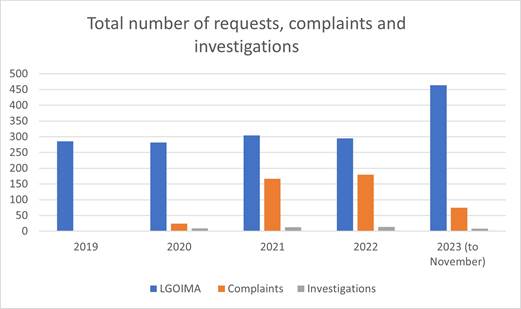
Figure 2
– total numbers
4.8 It is noted that this number only
reflects requests for information that are tracked and managed as LGOIMAs as
opposed to recording the vast number of requests for information that Council
staff manage each day.
4.9 As previously advised the complaints
data held by the Legal and Democracy Services Team will no longer be reported
from the beginning of 2024. The team assists with complaints if required but
the majority are managed by individual teams in accordance with the
Councils’ Complaints Policy.
4.10 To protect staff from abuse and being targeted,
responses to information requests by the Legal Team no longer include the staff
member name, only their position title.
Investigations
4.11 The Council has eight matters currently with the
Ombudsman, one of which is a provisional enquiry. These have been received from
four individuals.
4.12 The Council has been actively engaging with the
Office of the Ombudsman in relation to these matters. This has led to some
additional material being identified and released in some cases as part of the
investigation stage of the process.
4.13 The Council has received provisional opinions from
the Ombudsman in relation to complaints about a resource consenting issue and
the operation of the Motueka Aerodrome. Staff are responding to the provisional
opinions and the Council will be updated when the final opinions are released.
4.14 The Legal and Democracy Services Team continues to
lead the response to these investigations in a timely and professional manner.
5. Te Kāhui Hononga – Māori
Partnerships and Engagement
5.1 In the first week of November 2023,
Nelson hosted Te Mana Kuratahi the national primary school kapa haka
competitions. This event saw thousands of people arrive to watch their Tamariki
perform. Over the week 15 Council staff volunteered at various times. The
organising committee commended the Council for their efforts and presence at
this event. The national secondary kapa haka competitions will be held in
Nelson in June 2024 and will welcome volunteers again.
5.2 On 16 November 2023 the Kaihautū
presented the draft Statement on Fostering Māori Participation in Council
Decision Making. This was well received, and any feedback, questions or
comments can be directed straight to the Kaihautū Renee Thomas. This
document will form part of the LTP and outlines the initiatives (past, present,
and future) that the Council carries out to strengthen relationships between
council and whānau, hapū and iwi of Te Tauihu.
5.3 On 29 November 2023, iwi representatives
co-presented the Māpua Masterplan alongside Council staff. It was a great
opportunity to have iwi able to present workshop material to council. Our staff
felt that the most appropriate people to share the history of Māpua are
the tangata whenua. This process is likely to be used for future workshops.
Staff are now working with the iwi representatives to co-present to the public
in February 2024 at Māpua.
5.4 The RIF hui was attended by Janine
Dowding and Renee Thomas on 5 December 2023, with Tasman District Council
co-chairing the Cultural Pou for this forum with Shane Graham from Te
Rūnanga o Ngāti Rārua. The strategy for this pou was agreed to
with a focus on Te Reo Māori and increasing competency across agencies.
The other areas of focus are housing, education, health and the environment and
economy, all agencies are working on what the new Government and any
legislative changes may mean in terms of organisational impacts.
5.5 A cadetship programme Te Aka
Pūkenga is progressing with the three councils and eight iwi of Te Tauihu
to create opportunities for iwi to gain work experience within the council and
iwi space. The programme will start early 2024 with each council managing a
cadet, this programme is externally funded through the Better off Funding
initiative.
5.6 Iwi representatives on Council
committees was approved by the Council earlier this year. With the need to
review policies on independent members on Council committees and to streamline
processes for onboarding, it has been decided to delay the induction of one
candidate approved by iwi until next year.
6. Motueka Wastewater Treatment Plant Update
Rahui
6.1 Further to an
earlier report to the Council advising that there was a fault with the membrane
at the Motueka Wastewater Treatment Plant, we advise that a ceremony was held
by iwi and whanau putting a rahui in place covering the area North of the
saltwater baths at Motueka to Riuwaka. Te Kāhui Hononga, Leonie Rae and
Richard Kirby attended the ceremony to put the rāhui in place on Wednesday
18 October 2023.
6.2 The membrane has
now been replaced at the treatment plant as scheduled on 1 December 2023.
6.3 We are waiting
for further testing to see when it will be safe to lift the rāhui, aiming
for pre
22 December 2023 which is the shutdown period.
Ask Your Team for Local Government
7.1 In October, we
completed our fifth round of participation in Ask Your Team (AYT) for Local
Government.
7.2 For your information AYT is an online engagement and performance
survey tool that has been developed with the help of Equip, branded as Local
Government New Zealand’s (LGNZ’s) ‘centre of
excellence’. AYT has confirmed there are currently more than 48 councils
participating and we are able to benchmark survey results against these
participating councils.
7.3 Our AYT survey score was 68% compared to a Local Government
(LG) benchmark of 64% and our participation rate was 79% compared to a LG
benchmark of 68%. I’m very pleased to report that nearly all our
top scoring questions have a strong focus on people and wellbeing.
It’s also pleasing to report that our 2023 score is 4% higher than our
2022 survey score.
Human Resources Statistics
7.4 The
human resources statistics for the quarter ending September 2023 show that we
have 410 FTE and a headcount of 434. This has increased from the 405 FTE
(headcount of 426) as at June 2023. The FTE is offset by a 6.6 FTE relating to
existing reduced hours flexible working arrangements, and noting there are
approximately 15 vacancies included in the 410 FTE.
7.5 Turnover
for the quarter was 2.3% and the 12-month rolling period is 12.65%. The new
positions are listed below, and the total headcount has been offset by a number
of disestablished roles and fixed term roles that have finished in the
September quarter.
7.6 The
new positions for this quarter are:
|
CEO Office
|
Kaiāwhina Māori
|
|
Council Operations
|
Democracy Services Advisor
|
|
Environmental Assurance
|
Deckhand (fixed term)
|
|
Finance
|
Finance Advisor – Port Tarakohe (fixed term)
Finance Winter Student (fixed term, part time)
|
|
Information, Science & Technology
|
Applications Support Administrator – 0365
Project Manager – DIP (fixed term)
|
|
Service & Strategy
|
Customer Services Officer (part time)
Principal Planner – Strategic Policy (fixed term)
|
Recruitment
7.7 Recruitment
continues to remain steady, and we are currently at various stages of
recruiting for approximately 15 vacancies which are a mix of existing and new
positions. We continue to face difficulties in attracting experienced Consent
Planners, however we have employed five graduate planners.
7.8 Since
my last report, another 17 appointments have been made, plus 11 summer students
who have started in their fixed term roles for this summer season.
8. Assurance and Improvement Team
8.1 The Assurance
and Improvement team led by Deidre Hemera, was joined by a Procurement
Specialist, Doug Moffet on 27 November 2023.
8.2 The Health and
Safety Lead, Karen Harvey will start 8 January 2024.
8.3 The new
additions will enhance the team as they work toward improving processes within
the organisation to improve the efficiency and effectiveness of operational
matters. The focus is on consolidating processes through the collaboration of
teams to enable consistency in how we operate as an organisation.
9. Resilience Project – 189 Queen
Street, Richmond
9.1 The Richmond
Building Resilience Project is entering the next phase of the work. Parts of
the Richmond office are undergoing building resilience, strengthening and
fit-out work over the coming months, expected to be completed in August
2024.
9.2 The Richmond
office comprises a collection of buildings that are in a medium seismic risk
zone. The aim of this work is to invest in the resilience of our buildings to
create a safe, healthy workplace with a focus on staff wellbeing. We will do
this through mitigating the seismic risk to our buildings and conducting
strengthening work.
9.3 The Chief
Executive office and staff, along with several teams will be relocating to a
different area within the building from late December 2023 through to May 2024,
while the strengthening and construction work happens on the ground floor.
9.4 Access to shared
spaces such as the staff room, showers, lockers, and mailroom is also affected
with alternative arrangements in place from 3 January 2024.
10.1 This will be the last
update report, given that my last day with Tasman District Council is Friday 26
January 2024.
10.2 I want to take this opportunity to thank you and the previous Mayor
and Councillors over the last six years for granting me the privilege of
serving as your Chief Executive Officer.
10.3 In my time with the Council, I have become keenly aware of the
breadth and depth of Council functions, and the level of commitment of elected
members, staff, and those outside of Council that make an enormous contribution
to our district and communities.
10.4 The complexity of issues faced by Local Government, and in many ways
amplified for Tasman District Council as a unitary council is daunting to say
the least. I deeply appreciate the opportunity I was given to work on the
Future for Local Government Review where these issues have been exposed and I
fervently hope that the new Government will recognise the importance of Central
and Local Government working together for current and future generations.
10.5 I
will look back with some regret that we were not always able to meet
expectations of everyone in the community. I learned early that a solution
for one was a problem to another. While we could not always respond with the
outcomes people wanted, I hope that we have shown respect, understanding and
humility.
10.6 I
will also take heart from progress made and acknowledge that in almost all
examples’ relationships and collaboration with iwi, other councils,
government entities, industry, business and community groups, agencies, and
volunteers have been the key success factor.
10.7 Having
had no previous work experience in Local Government prior to undertaking the
Chief Executive role, I have had an intense reliance on support and guidance
from the Mayor, the kaumātua, my executive leadership team colleagues and
the many talented individuals within the Council and staff. I have learned more
than I ever thought possible, yet I know that I have only touched the surface.
I have been blessed to have worked with a wonderful team with a shared spirit
of service. Thank you!
Nil
Tasman District
Council
Agenda – 13 December 2023
7.20 Mayor's Update Report
Information Only - No Decision
Required
|
Report
To:
|
Tasman
District Council
|
|
Meeting
Date:
|
13
December 2023
|
|
Report
Author:
|
Tim
King, Mayor
|
|
Report
Authorisers:
|
|
|
Report
Number:
|
RCN23-12-26
|
1.1 As the end of year rapidly approaches,
the business of Council continues to be full on.
1.2 The ongoing LTP discussions have been
very important in providing direction to the Council staff as we move towards a
draft Long Term Plan for consultation. The use of the prioritisation process of
“must” “should” and “could” to assess
Council’s service delivery has been very helpful in assessing where the
Council’s priorities should be over the next ten years.
1.3 Now that the new Government is
officially “operating” we expect that their plans around affordable
water, resource management legislation and the future for local government will
be announced shortly so that we can factor their direction into our draft Long
Term Plan.
1.4 In response to a request from
Infrastructure Holdings Limited, Mayor Smith and I have agreed to extend the
timeline for the IHL Statement of Intent process by one month. This request was
sought in accordance with the extension of time provision in Schedule 8
Statements of Intent for council-controlled organisations of the LGA.
1.5 It was great to
receive a letter of appreciation (Attachment 1) from the Golden Bay Cyle
and Walkways Society commending the Council for its work on the shared path at
Pōhara. While in the planning stages, this project was lambasted by a
small group within the community. It is pleasing to see that the final shared
path has been welcomed by the Golden Bay community.
1.6 The local
Friends of Fujimi Machi (our sister city in Japan) group visited on 11 November
2023 to discuss plans for a visit from the Mayor, senior Ministry of Education
officials and eight students from Fujimi Machi in March next year.
1.7 A letter was
sent to the Te Tauihu iwi chairs inviting them to provide an appropriate name
for the Council’s new Māori Ward (Attachment 2).
1.8 A letter was
sent on behalf of everyone at the Council to Barney Thomas congratulating him
on his award of Te Tohu Ratonga Tūmatanui o Aotearoa, the New Zealand Public Service Medal.
Barney has been a great supporter of Tasman District Council and was a key
member of the inaugural Waimea Water Augmentation Committee that drove the
Waimea Community Dam Project.
1.9 This is our Chief Executive, Janine
Dowding’s final Council meeting before she leaves the organisation. While everyone at Tasman District Council is disappointed to be
losing her, Janine’s leadership over the past five and a half years has
been hugely appreciated. She has been an outstanding Chief Executive, and I
have enjoyed working alongside her. During Janine’s time, we have faced a
few challenges – the unsettled period during Covid-19, the local
government reforms, an organisational restructure (to name just a few), all
managed to the highest standard. I am sure the Councillors will join me in
thanking Janine for her extraordinary service to the organisation and to wish
her all the very best for the future.
1.9 Finally, I would
like to take this opportunity to wish everyone in the Tasman District community
a very Merry Christmas and a happy and favourable 2024.
2. Recommendation/s
/ Ngā Tūtohunga
That the Tasman District Council receives the Mayor's Update Report,
RCN23-12-26.
3.1 Judging of the annual “Mayors for
Peace” Art Awards was held on 18 October 2023. While we didn’t
receive as many entries this year, the quality was still very high, and ten
artworks were sent to Japan for judging.
3.2 The Rata Foundation held a
“grants” function in Nelson on 18 October 2023.
3.3 The Nelson Tasman Chamber of Commerce
meeting was held on 19 October 2023.
3.4 The Chinese Consul General, He Ying
introduced herself at a meeting held at the Richmond offices on 20 October
2023.
3.5 The two-monthly meeting with Kaumatua
Harvey and Whaea Jane was held on 26 October 2023.
3.6 Several Local Government Reforms
Steering Group meetings were held during the period.
3.7 A meeting was held with Tasman Bays
Heritage Trust personnel on 27 October 2023.
3.8 The powhiri to welcome attendees to Te
Mana Kuratahi was held on 29 October 2023. The competition held at the
Trafalgar Centre was a huge success and the week bought many visitors to our
region with some staying as far away as Kaikoura and then travelling to Nelson
to perform.
3.9 A meeting with Nelson City Council and
Nelson Regional Development Agency staff was held on 30 October 2023 to discuss
the City Deal proposal.
3.10 The Outstanding Community Service Awards were held
at the Headingly Centre on
31 October 2023. A second award ceremony will be held in Golden Bay on 11
December 2023.
3.11 The second Local Government New Zealand Future for
Local Government workshop was held in Wellington on 2 November 2023 followed by
the Regional Sector meeting the following day.
3.12 The Diwali celebration was held on 5 November 2023
at Founders Park.
3.13 The Cawthron Institute Trust Board met on 13
November 2023.
3.14 Fifty-one new citizens attended the final
citizenship ceremony for 2023 on 15 November 2023.
3.15 The opening of the Prowood Sawmill was held on 17
November 2023.
3.16 A TVOne interview on 21 November 2023 focused on
water supplies and the issues with our older non-compliant supplies.
3.17 The Project Kokiri forum met on 22 November 2023.
3.18 Callaghan Innovation held a networking function on
22 November 2023.
3.19 A farewell function was held for Nick Clarke, Chief
Executive of the Habitat for Humanity on 23 November 2023.
3.20 The CDEM Group meeting was held on 28 November
2023.
3.21 The three-monthly catch up with Nelson Regional
Development Agency Chair, Sarah Jane Weir and Chief Executive, Fiona Wilson was
held on 30 November 2023.
3.22 The Project Janszoon Christmas function took place
on 1 December 2023.
|
1.⇩
|
Letter
from Golden Bay Cycle and Walkways Society
|
252
|
|
2.⇩
|
Letter to
Te Tauihi Iwi Chairs - name for Māori Ward
|
253
|
Tasman District
Council
Agenda – 13 December 2023
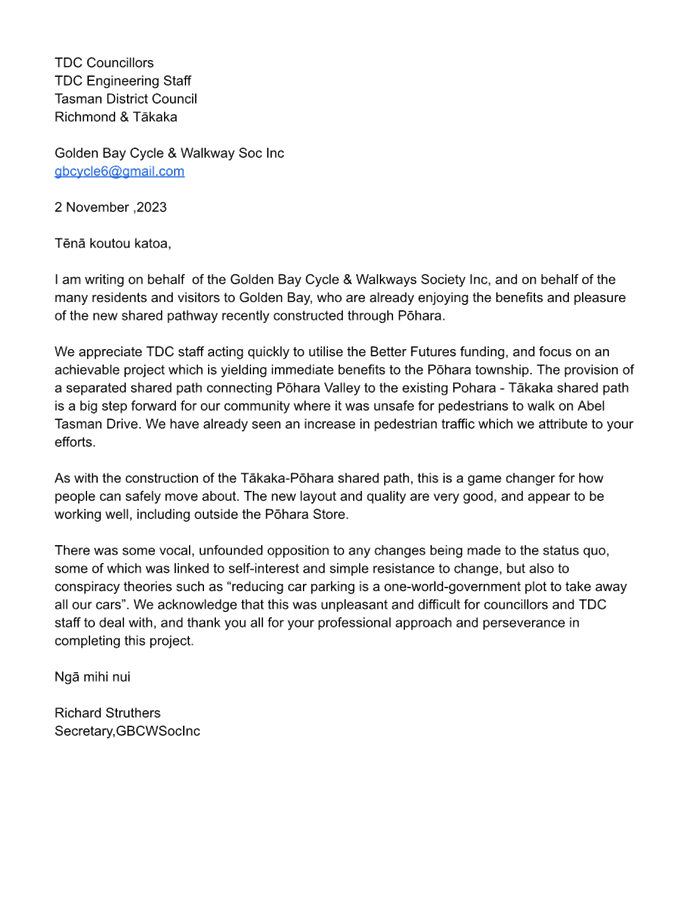
Tasman District
Council
Agenda – 13 December 2023
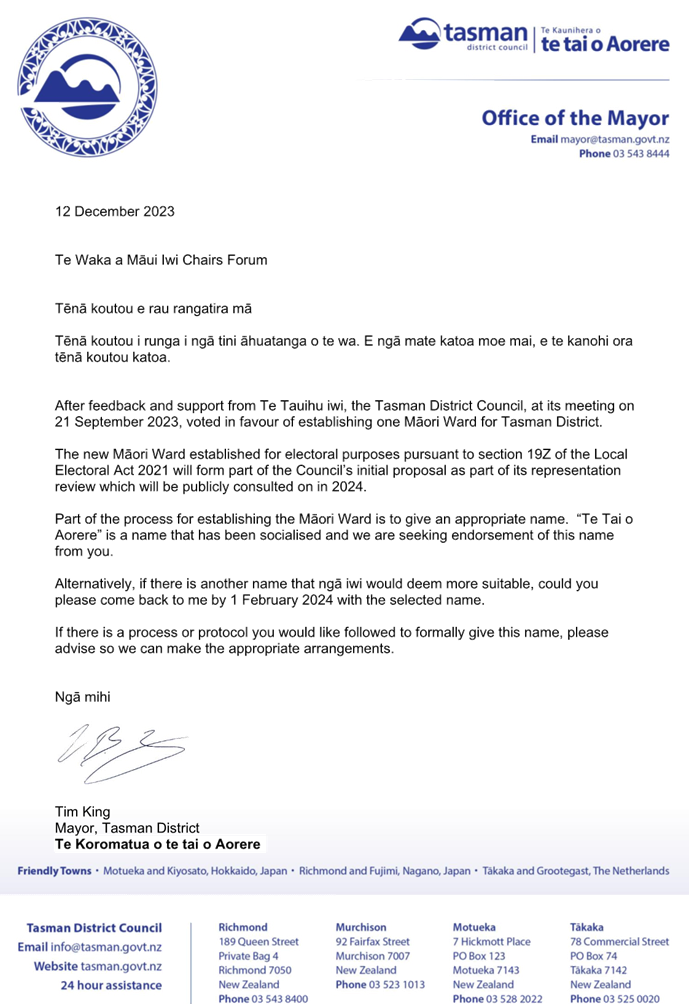
Tasman District
Council
Agenda – 13 December 2023
8 CONFIDENTIAL SESSION
8.1 Procedural
motion to exclude the public
The following
motion is submitted for consideration:
That the
public be excluded from the following part(s) of the proceedings of this
meeting. The general subject of each matter to be considered while the public
is excluded, the reason for passing this resolution in relation to each matter,
and the specific grounds under section 48(1) of the Local Government Official
Information and Meetings Act 1987 for the passing of this resolution follows.
This resolution is made in reliance on section 48(1)(a) of the Local
Government Official Information and Meetings Act 1987 and the particular
interest or interests protected by section 6 or section 7 of that Act which
would be prejudiced by the holding of the whole or relevant part of the
proceedings of the meeting in public, as follows:
8.2 Waimea Water Limited - Statement of
Expectations
|
Reason for passing this resolution in
relation to each matter
|
Particular interest(s) protected (where
applicable)
|
Ground(s) under section 48(1) for the
passing of this resolution
|
|
The public conduct of the part of the
meeting would be likely to result in the disclosure of information for which
good reason for withholding exists under section 7.
|
s7(2)(i) - The withholding of the
information is necessary to enable the local authority to carry on, without
prejudice or disadvantage, negotiations (including commercial and industrial
negotiations).
|
s48(1)(a)
The public conduct of the part of the
meeting would be likely to result in the disclosure of information for which
good reason for withholding exists under section 7.
|






















































































































